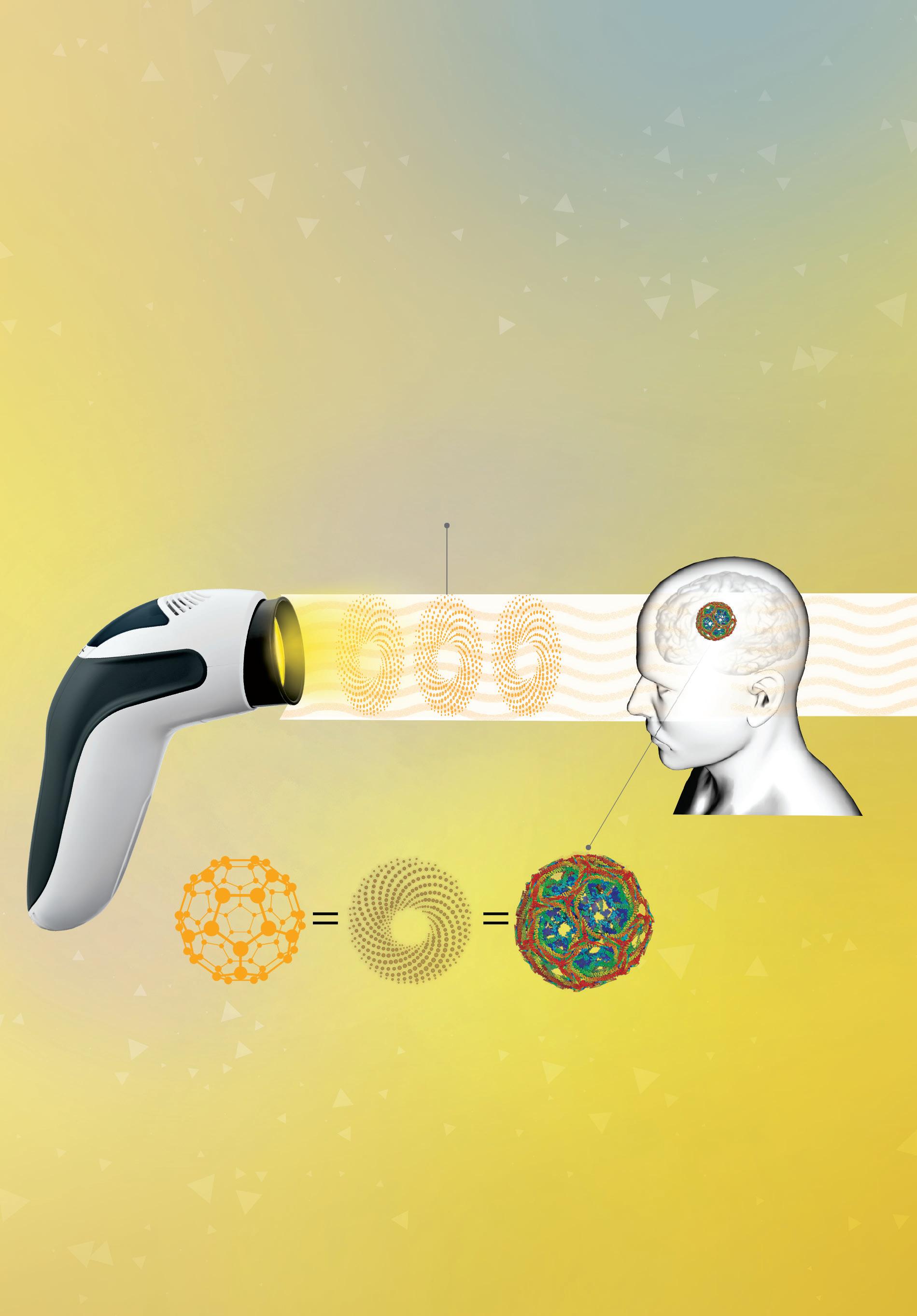

HYPERLIGHT THERAPY
A Breakthrough for Healing and Enhancing Your Well-Being
BART DE WEVER, PHD AND MYRIAM WILLEMSE
Tesla Quantum Torus Structure (Quantum Hyperlight energy, information and frequency)
Bart De Wever, PhD and Myriam Willemse
Hyperlight Therapy
A Breakthrough for Healing and Enhancing Your Well-Being
Copyright © 2025 by Home Art & Sales Services – all rights reserved.
It is not legal to reproduce, duplicate or transmit any part of this document either in electronic or printed format. The recording of this composition is strictly prohibited.
PREFACE
In the boundless tapestry of existence, there exists a force so profound, so infinitely subtle, that it defies the limits of our understanding. It’s the force of light, not just any light, but the enigmatic, transformative essence known as Quantum Hyperlight. As you hold this book in your hands, you are on the brink of an awe-inspiring journey—a journey that will unveil the astonishing secrets of this radiant marvel and forever change the way you perceive healing.
Imagine a realm where healing transcends the boundaries of conventional wisdom, where ailments are not just treated but harmonized on a quantum level. Picture a reality where the very essence of light becomes a powerful agent of transformation—a reality that, until now, has remained hidden in the shadows of mainstream medicine. This book is your beacon into this new realm, your passport to understanding the profound healing properties that Quantum Hyperlight offers.
“Hyperlight Therapy: A breakthrough for Healing and Enhancing Your Well-Being” is more than a book; it’s a gateway to a universe where light becomes a living, breathing healer. It’s an invitation to unlock the latent potential within you and embrace a future where wellness is not just the absence of illness but a radiant, vibrant state of being.
Within these pages, we embark on a journey through the quantum mysteries of light therapy. You will delve into the heart of Quantum Hyperlight, exploring its awe-inspiring origins and the remarkable science that underpins its healing power. But what sets this journey apart is the abundant clinical evidence that accompanies our
exploration. You’ll discover how Quantum Hyperlight has been harnessed to accelerate wound healing, offering hope to those who have faced persistent wounds and injuries. Rheumatoid symptoms, long regarded as a chronic challenge, yield to the gentle touch of Quantum Hyperlight, providing respite to countless individuals. The scourge of back pain, an ubiquitous affliction, surrenders to the transformative power of this radiant therapy, offering relief to sufferers. Skin diseases, sleeping problems, seasonal affective disorder, and the relentless march of skin aging are all confronted within these pages, each met with compelling clinical evidence of the astonishing efficacy of Quantum Hyperlight.
"Hyperlight Therapy: A Breakthrough for Healing and Enhancing Your Well-being” isn’t just about the science of healing; it’s about the art of transformation. It’s about the courage to embrace the unknown, the wisdom to challenge convention, and the belief that there are extraordinary solutions to life’s most challenging problems. It’s a testament to the resilience of the human spirit and the boundless possibilities that await those who dare to explore the quantum realms of healing.
As you turn these pages, you will encounter stories of individuals who found solace from chronic pain, liberation from debilitating conditions, and a renewed zest for life—all through the fascinating therapeutic benefits of Quantum Hyperlight. Their stories are a testament to the profound, life-altering potential that lies within this radiant phenomenon.
So, dear reader, if you’ve ever sought a path to wellness that transcends the ordinary, if you’ve ever dreamed of harnessing the power of light for profound healing, then “Hyperlight Therapy: A Breakthrough for Healing and Enhancing Your Well-Being” is your guiding star.
It’s an exploration of the boundless healing possibilities that await those who embrace the quantum mysteries of light.
Are you ready to embark on this extraordinary journey? Turn the page, and let the healing light of Quantum Hyperlight illuminate your path.
February 2025
Bart De Wever Ph.D. and Myriam Willemse
Book Review by Deepak Chopra, Jack Tuszynski and Brian Fertig, Authors of “Quantum Body.”
– Deepak Chopra, M.D., The Chopra Foundation, New York, USA
– Jack Tuszynski, Ph.D., University of Alberta, Edmonton, Canada and Politecnico di Torino, Turin, Italy
– Brian Fertig, M.D., Meridian Health School of Medicine & Robert Wood Johnson School of Medicine, Piscataway, NJ, USA
Light has been fascinating humans since the dawn of time. It is a source of energy for plants, which, in turn, are the life-sustaining sources of nutrition for animals and, consequently, for us humans. Light illuminates our environment and, hence through the sense of vision, informs us about the world around us. The science of light was developed by Sir Isaac Newton and his contemporaries, who laid the foundation for optics and optical devices, including the discovery of the microscope by Antonie van Leeuwenhoek. Through these discoveries, we have been able to gain insight into the world of cells and their inner workings in the centuries to follow. In the 20th century, quantum mechanics taught us that light is quantized in the form of photons, which sometimes behave like waves and sometimes like particles. Einstein was awarded his Nobel Prize for the explanation of the photoelectric effect, in which light of sufficient energy is able to eject electrons from the surface of a metal plate, leading to the flow of electric current. A few decades later, a monumental discovery of coherent light generation using laser devices enabled the spawning of new
technologies, such as bar code readers, sensors, DVD players, medical therapeutic and diagnostic devices, and a plethora of communication devices based on optical fibers.
The book that you are holding in your hands provides an accessible overview of the fundaments of electromagnetic waves, of which visible light is but a slice of the spectrum. But this book does much more than offer an interesting and highly readable introduction to the fascinating world of the science of light. It takes you to the next level of what promises to be the future of medical applications for a new modality of light. Sir Harry Kroto, Richard Smalley, and Robert Curl were awarded a Nobel Prize in Chemistry in 1996 for their discovery of a special form of carbon molecules, called fullerenes. Little did they know that light passing through these structures (fullerene C60) becomes uniquely polarized and acquires amazing properties. The book by Bart De Wever and Myriam Willemse is a unique publication that anybody who is interested in the healing properties of light must read. This so- called Quantum Hyperlight, obtained by the passage of light through fullerene structures, has shown extraordinary healing potential when combined with the recently developed technology Bioptron, created by the company Zepter.
In this well-documented and richly illustrated book, the reader will find a practical guide for the technology that has been created based on this fundamental discovery. Importantly, it presents in great detail numerous fascinating medical applications, ranging from skin care products and eye care advances, to wound healing therapies, and even pain relief applications. Specific medical cases with patient testimonials provide concrete examples of the efficacy of this new technology, which is poised to improve the state of health for millions of people across the globe. This is already on the way with eyewear products available world-wide. This new and exciting medical technology is part of what
may be called electromagnetic medicine (or healing), which started with lasers and has now become very sophisticated and, most importantly, highly efficacious. It reduces our dependence on pharmacology and is minimally invasive with virtually no side effects. The book is replete with references to the relevant scientific literature. While scientifically rigorous, this publication is accessible to the lay reader. In summary, it is very exciting for us to see a medical revolution based on the electromagnetic paradigm taking place before our very eyes.
FORWORD
Philip Zepter: A global entrepreneur and philanthropist, and the architectural force behind the development of knowledge and applications related to fullerene-based Quantum Hyperlight.
The realization of this book would not have been possible without the dedication and visionary leadership of Mr. Philip Zepter, a prominent figure in the world of business and philanthropy, and renowned for his innovative approach to commerce and his commitment to improving lives through his products and initiatives. Born in Serbia in 1950, Zepter moved to Austria in 1970, where he started as a young entrepreneur to become a global business magnate, a testament to his vision and dedication. In the mid-1980s, he founded Zepter International, a company specializing in high-quality consumer goods, particularly cookware and utensils for healthy food preparation, and wellness- medical products. His commitment to craftsmanship and quality quickly earned Zepter International a reputation for excellence, and the brand became synonymous with innovative design and functionality.
One of Zepter’s most notable contributions to the medical field is the development of the Bioptron Hyperlight Therapy system, a certified medical device that utilizes fullerene C60-based hyperpolarized light, “Quantum Hyperlight,” for various therapeutic and cosmetic applications. The Bioptron Quantum Hyperlight Therapy System has gained medical and regulatory recognition for its effectiveness in skin care, wound healing, seasonal affective disorders, and pain management. More recently, Zepter incorporated the principles of hyperpolarized
light formation into special optics called Quantum Hyperlight Optics that transform any source of light into Quantum Hyperlight, which positively affects neuro-processes and brain functioning and optimizes vision. In a similar way, Zepter’s Quantum cosmetics convert daylight into Quantum Hyperlight to optimize skin functioning. Beyond his business endeavors, Zepter is a passionate advocate for philanthropy and cultural exchange. He has established the Zepter Foundation, which supports numerous charitable projects focusing on education, healthcare, and cultural preservation. The foundation’s initiatives have had a profound impact on communities around the world, particularly in the fields of medical research and children’s welfare. Zepter’s dedication to fostering cultural exchange and understanding is evident through his sponsorship of art exhibitions, concerts, and cultural events. He believes in the power of art and culture to transcend borders and bring people together.
Throughout his career, Philip Zepter has been bestowed with numerous awards and honors in recognition of his contributions to business and philanthropy. His commitment to innovation, quality, and making a positive difference in the world continues to drive his work and inspire others. In a world where entrepreneurship often extends beyond profit margins to leave a lasting legacy, Philip Zepter stands as a shining example of a business leader who leverages success to improve the lives of individuals and communities worldwide. His vision, commitment to quality, and dedication to philanthropy have left an indelible mark on both the business and humanitarian landscapes. Please note that this is but a brief ovetview of Philip Zepter’s life and contributions. His accomplishments and philanthropic work span a wide range of areas and continue to grow and evolve to this day.
INTRODUCTION
Light is a fundamental force in both biology and human life, playing diverse and essential roles that extend far beyond simply illuminating our surroundings. From photosynthesis in plants to vision and the regulation of circadian rhythms in humans, light influences numerous aspects of our existence.
In the realm of biology, one of the most pivotal functions of light is its role in photosynthesis. In this process, green plants, algae, and some bacteria capture light energy from the sun and convert it into chemical energy in the form of glucose. This conversion is the foundation of the food chain, providing sustenance for virtually all life on Earth. Photosynthesis not only produces food but also generates oxygen, a vital component of the atmosphere that supports aerobic respiration in many organisms.
In humans, light serves multiple crucial functions. Vision, being perhaps the most obvious one, relies on the ability of our eyes to detect and interpret light. The retina contains specialized cells called photoreceptors (rods and cones) that respond to varying wavelengths of light, enabling us to perceive color, shape, and depth. Light also plays a crucial role in the regulation of circadian rhythms, which are our internal biological clocks. Specialized cells in the retina communicate with the brain’s suprachiasmatic nucleus to synchronize our bodily processes with the natural light-dark cycle. This influences our sleepwake patterns, hormone production, and overall well-being.
Beyond these fundamental biological functions, light has a profound impact on human life in various ways. It is central to the fields of art, culture, and aesthetics, shaping our perceptions of beauty, space, and
color. Light is harnessed for communication in technologies like fiber optics, lasers, and LEDs, facilitating the transmission of information at lightning speeds. Additionally, the healing properties of light therapy are harnessed in medicine to treat conditions including pain, inflammation, seasonal affective disorder (SAD), and some skin disorders. In conclusion, the functions of light in biology and human life are far- reaching and multifaceted. From sustaining life through photosynthesis, to regulating our internal rhythms, and enabling the sensory experience of the world, light is an indispensable force that shapes our existence in ways both seen and unseen. Its significance extends beyond mere illumination, illustrating the intricate interplay between science, nature, and human culture.
This book will focus on the effects of light, in particular Quantum Hyperlight, and its interaction and modulation of biomolecules to influence a wide range of biological processes at the molecular level, resulting in the extraordinary healing of the human body.
PART 1: Quantum Medicine Based On Quantum Light
CHAPTER 1:
The Principles of Quantum Medicine
Let’s start with explaining what the word “quantum” actually means.
In very simple terms, “quantum” refers to the minute, fundamental building blocks of the universe. It’s a word used in physics to describe things that are incredibly small and behave in a way that’s different from how larger things, like everyday objects, operate.
In the context of quantum physics, scientists study the behavior of these minute particles, such as atoms and subatomic particles, and how they interact with each other. Quantum physics often involves strange and fascinating phenomena, such as particles being in two places at once or particles being “entangled” with each other, where the state of one particle is connected to the state of another, even if they are far apart (Griffiths et al., 2018).
In the context of medicine, “quantum” is not used in the same way as it is in physics. Here a quantum is considered the smallest amount of energy information that can influence the body’s molecules and atoms responsible for healthy elementary processes. Quantum medicine explores the application of quantum physics and quantum biology in the treatment of disease, and examines an illness as “disrupted frequencies in the energy-body status” (Chopra D, 2015; Gonzalez et al., 2020; Bisiani et al., 2023). All our tissues, cells, and organs have their own unique electromagnetic fields. Traumatized, inflamed, or degenerative tissue produces abnormal electromagnetic fields, resulting in imbalances in cells and cellular components (Jafari et al., 2020; Jacques S, 2013; Di Gregorio et al., 2022).
By applying the correct quantum frequencies, such as by means of Quantum Hyperlight, the body can be healed.
Quantum medicine is a term that has been used in various ways and contexts, but it doesn’t have a widely recognized or established definition within mainstream medicine. It is often associated with alternative or complementary medicine approaches that incorporate ideas from quantum physics into healthcare practices (Siko S, 2002; Lakhovsky G, 2007; Korotkov K, 2023; Tiller W, 2004; Oschman J, 2015; Rein G, 2004). In these alternative approaches, “quantum” is sometimes used metaphorically to imply a holistic or interconnected view of health and healing. Some proponents of quantum medicine suggest that it involves a deeper understanding of the body and mind’s interconnectedness with the broader environment and the use of energy-based therapies (Fertig et al., 2022; Chopra et al., 2023).
This book focuses on quantum medicine based on “quantum light therapy,” a term used to describe a form of medical or therapeutic treatment that involves the application of light in a precise and controlled manner for healing or wellness purposes. In this book, the term “quantum” is used to emphasize the precise and quantum-level interactions between light and biological systems.
Although Quantum Hyperlight therapy or “resonance therapy” has been proclaimed the medicine of the third millennium (Magas V, 2006; Chopra et al., 2023), it’s important to note that many mainstream medical professionals and scientists view “quantum medicine” with skepticism, as it often lacks rigorous scientific evidence and may incorporate concepts that are not well-supported by the current understanding of physics and biology. As a result, the term “quantum medicine” is not typically used within conventional medical practice or recognized by medical regulatory bodies.
Recently, an important white paper was published by a team of renowned researchers of Stony Brook University School of Medicine, NY, USA, in the Journal of Clinical Medicine titled “It’s Time to Go Quantum in Medicine” (Bisiana et al., 2023), explaining the applications of quantum physics in medicine. The authors conclude:
“The intersectionality between the fields of quantum physics and medicine can facilitate a greater understanding of how certain diseases arise, and therefore help patients in future treatments. Hence scientists in the field of medicine, as well as those in the field of quantum physics, have begun to realize that these two fields actually have more to do with one another that people usually realize, and it is worth delving into the intersectionality between these two fields, bringing them together as a means of advancing the field of medicine through unique applications of quantum theory.”
The next chapters of this book will demonstrate that applying the principles of quantum light physics and quantum biology resulted in the development of Quantum Hyperlight therapy, a unique and certified technology with a wide spectrum of applications in medical treatment and forming a breakthrough application in quantum medicine.
The latest technological advancement in light therapy development puts forward the breakthrough advantages of fullerene C60 filtered light: Hyperpolarized Quantum Hyperlight obtained through the nanophotonic fullerene C60 optics (Chemistry Nobel Award 1996). Due to its unique quantum properties, based on the principles of biomimicry and resonance, Quantum Hyperlight provides the energy required to optimize cellular processes and tissue regeneration in the human body.
CHAPTER 2:
Light
Therapy Throughout History
Light is an incredible force of nature that has fascinated humans for centuries. Beyond its obvious role in illuminating our world, light has also been harnessed for its therapeutic properties throughout history.
For thousands of years, people all over the world have revered the importance of light for the normal functioning of the human body. The first source of light used for medical treatments was sunlight, known as heliotherapy. Anecdotal records indicate that the use of heliotherapy dates from around 1400 B.C. Hindus treated patients with skin disorders using different plants followed by exposure to sunlight. Ancient Egyptian, Greek, Roman and Arab physicians integrated light therapy in general medical treatments. In Ayurvedic medicine, which originated in ancient India, sunlight was considered an essential healing element. Sunbathing, or “surya chikitsa,” was used to treat certain diseases. Healers believed that different colors possessed unique healing properties, and they used this knowledge to balance the body’s energy through practices such as chromotherapy. The technique is still used today (Satyanand A, 2000).
At the end of the 19th century, heliotherapy was recognized by many physicians. Researchers such as Danish physician Niels Ryberg Finsen pioneered the use of light in medical treatments. His device utilized filters to selectively transmit specific wavelengths of ultraviolet (UV) light for the treatment of Lupus Vulgaris skin condition (Woloshyn TA, 2017). Finsen’s work earned him the Nobel Prize in Physiology or Medicine in 1903 for his contributions to the field of phototherapy
(Godzsche PC, 2011). In the same year, in Leysin, Switzerland, Dr. Rollier (inspired by Dr. Ryberg Finsen’s work) opened the first hospital for the treatment of tuberculosis and rachitis via sun exposure. In 1914, he published a book “La Cure du Soleil” (The Sun Cure), in which he reported his results with heliotherapy, and published two further books in the years after on the application of heliotherapy for curative purposes. During the First World War (1914-1918) and Second World War (1939-1945), “open-air” exposure to natural sunlight was also widely used for the treatment of wounds in the United Kingdom, Italy, France, and Germany (Honigsmann H, 2013).

“The Light Department, London Hospital showing patients being treated with Finsen lamps for lupus.”
In William Beaumont, Fundamental Principles of Ray Therapy (London: H. K. Lewis & Co., 1931), p. 3. Author’s collection.
From Heliotherapy to Phototherapy
Important therapeutic effects of sunlight prompted many researchers to develop and use filtered solar radiation and artificial light sources. Finsen treated more than 950 patients with lupus vulgaris (tuberculosis of the skin) using filtered, technically synthesized “sunlight.”
Although Finsen’s primary focus was not on polarization, the use of filters in the lamp inadvertently resulted in the production of polarized light, amplifying the healing effects (just like the Bioptron Quantum Hyperlight Therapy System, which we will discuss in detail in Chapter 8). In 1903, he was awarded the Nobel Prize in Medicine for his research in light therapy and exceptional therapeutic results. Dr. Finsen is hence considered to be the founder of modern light therapy. Finsen developed the Finsen lamp, a precursor to modern phototherapy devices.
At the turn of the 19th century, tuberculosis was a widespread and deadly disease. Light therapy played a crucial role in the treatment of tuberculosis patients: Sunlight and artificial ultraviolet (UV) light were used to kill the bacteria responsible for the disease, paving the way for the development of UV lamps. Light therapy continued to advance in the 20th century, and researchers began exploring its use for conditions such as psoriasis, eczema, and seasonal affective disorder (SAD). In recent decades, light therapy has become more sophisticated, culminating in the development of specialized light sources and devices. It is now widely used to treat various medical conditions, including skin disorders, sleep disorders, mood disorders, and jet lag (Lee et al., 2021).
UV light therapy continued to evolve in the early 20th century. It became a standard treatment for skin conditions such as psoriasis and eczema. UVB and UVA rays were used to reduce inflammation and slow down the rapid growth of skin cells, providing relief to patients suffering from these conditions. The 20th century also saw the emergence of photodynamic therapy (PDT). This innovative approach combines light with photosensitive drugs to target and destroy cancer cells. PDT has been used to treat various cancers, including skin, esophageal, and lung cancers (Agostinis et al, 2011).
In the 1980s, researchers began to investigate the role of light in combating seasonal affective disorder (SAD), a type of depression linked to seasonal changes in sunlight. Light boxes, which emit bright artificial light exceeding a light intensity of 10,000 lux, have become a popular treatment for SAD. They help to regulate the circadian rhythm of individuals affected by the condition and improve their mood (Pjrek et al., 2020).
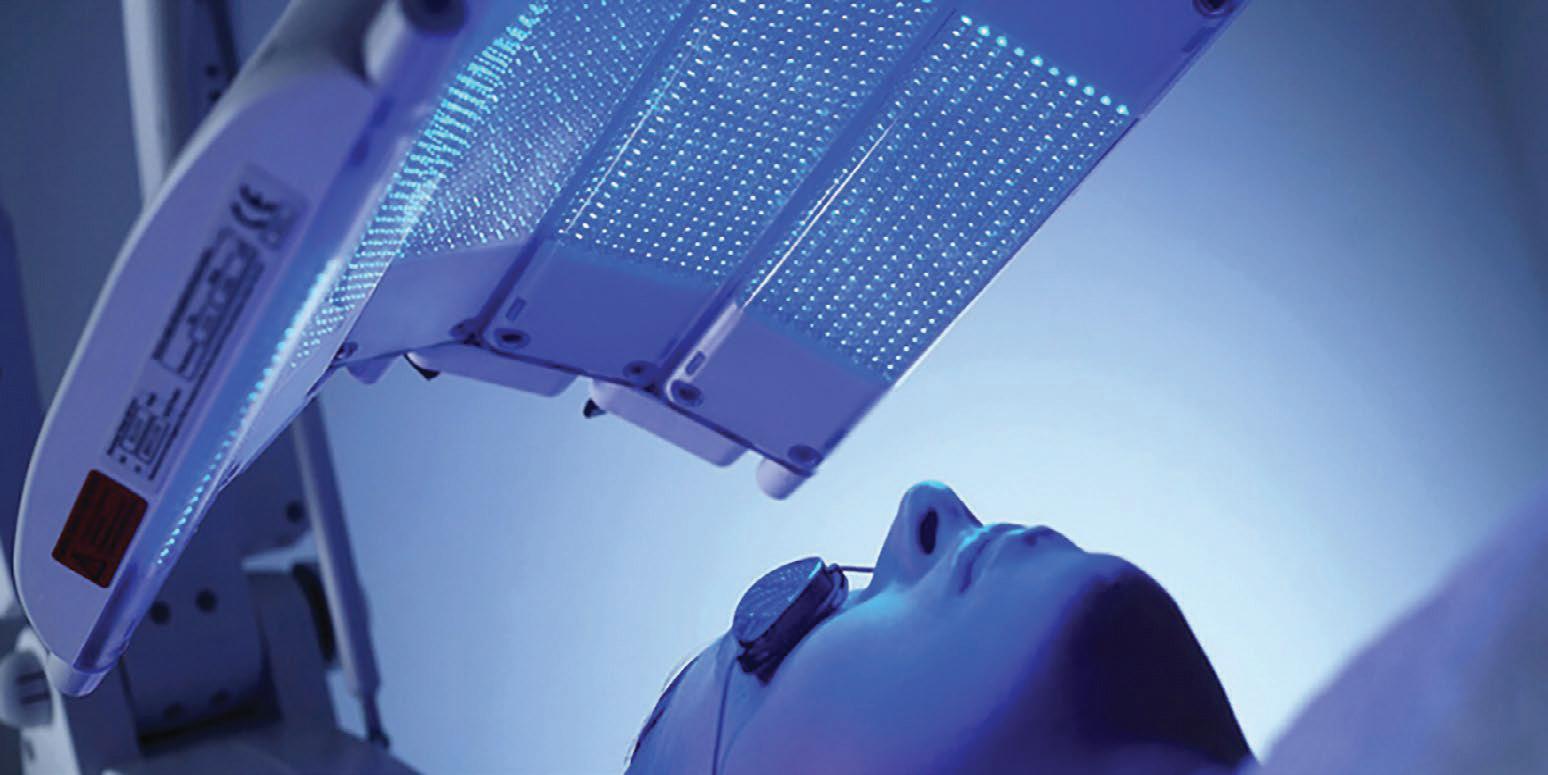
The advent of light-emitting diodes (LEDs) in the mid-20th century revolutionized light therapy. LEDs are energy-efficient, long-lasting, and can emit specific wavelengths of light, making them ideal for targeted therapies. They have been used to treat conditions such as acne, and in pain management and wound healing (Ngoc et al, 2019). Blue light therapy, a subset of LED therapy, has gained popularity as a noninvasive treatment for acne. Blue light kills the acne-causing bacteria, reducing inflammation and improving skin clarity. It has become a valuable tool for dermatologists and aestheticians.
In recent decades, NASA has explored the benefits of red-light therapy. They found that red light, when applied at specific wavelengths,
A woman undergoing blue LED-based photodynamic therapy.
can stimulate the growth of cells and enhance tissue repair. This has promising implications for wound healing, muscle recovery, and even combating the effects of aging (Whelan et al., 2001). Researchers are increasingly investigating the use of light therapy for mental health conditions beyond SAD. Some studies suggest that exposure to natural light or light therapy can alleviate symptoms of depression, anxiety, and sleep disorders. Light therapy may become a complementary treatment option for these conditions.
Today, light therapy remains an important therapeutic option, and advancements in technology continue to expand its applications and effectiveness. Advancements in technology have given rise to smart light devices that can be customized to individuals’ needs. These devices can mimic natural daylight patterns, optimizing circadian rhythms and enhancing overall well-being.
CHAPTER 3: Quantum Light:
Light as a Quantum Particle and Wave
Let us explore light. Is it a particle or a wave? The answer is that it is both! Imagine you’re standing by the shore on a sunny day, and you see the ocean waves rolling in. Just like those waves in the water, light also behaves like waves moving through space. But instead of water waves, we call them “light waves.” Light waves are akin to invisible ripples that travel extremely quickly through space. So quickly in fact that they travel from the sun to Earth in approximately 8 minutes. These waves carry energy and can bounce off of objects and surfaces, bend, and even pass through certain materials, such as glass. In addition, light waves have different colors. When these waves move together, they create what is known as a “spectrum”. You see this spectrum as the vibrant colors of the rainbow. Red, orange, yellow, green, blue, indigo, and violet: these are all different colors of light.
But that’s not all. Even though light behaves like waves, it also behaves like minute, invisible particles. These particles are called “photons”. Think of photons as minute, invisible, speedy particles of light, or tiny proverbial packages of light energy. When you turn on a flashlight or see a lightbulb glow, it’s because a huge amount of these minute photons is emitted at high speed. In this way, light can be both waves and particles at the same time. Scientists call this veritable magical double act “wave-particle duality”. Light acts like waves when we’re discussing its colors and how it moves through space. But when we’re looking at how it interacts with things, such as when it hits your eye or bounces off a mirror, it acts like particles (Sliney D, 2016).
So, how do we see things with light? The eye sees different colors through its interaction with light. Within the eye, there are specialized cells called cones that respond to different wavelengths of light. A wavelength refers to the distance between successive crests or troughs of a wave and is a measure of the length of one complete cycle of a wave’s oscillation. The cones are sensitive to short, medium, and long wavelengths, corresponding to the colors blue, green, and red, respectively. When light enters the eye and strikes these cones, they send signals to the brain, which then interprets the combination of signals to create the perception of various colors. This intricate process allows us to experience the vibrant spectrum of colors present in the world around us.
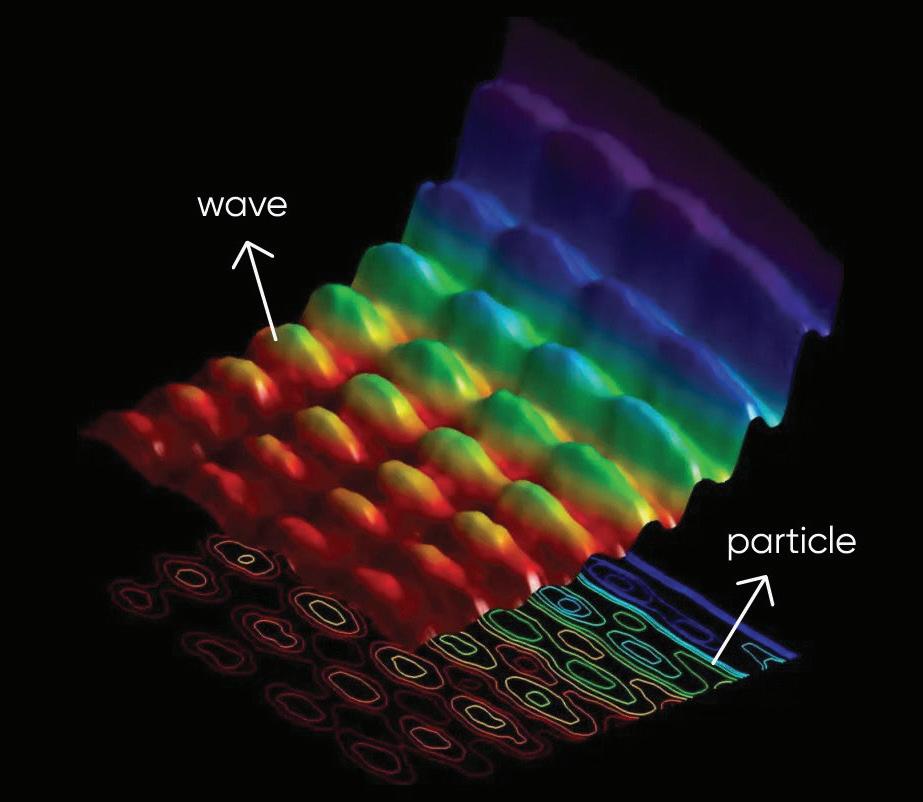
Light behaves both as a particle and as a wave.
Light is all around us, even when it’s dark! When we tum on a lamp, the light helps us to read books or play games. The sun is the biggest source of light, providing warmth and light during the day. Light undergoes captivating changes in appearance when it passes through certain objects, such as prisms. A prism is a special glass that can split white light into its full spectrum of colors.
Light is an indispensable part of our daily lives, serving myriad purposes that extend beyond mere illumination. In communication, fiber-optic cables use light signals to transmit data at incredible speeds, forming the backbone of our internet connectivity. Medical applications harness light in technologies such as lasers for surgeries, diagnostics, and therapies. Lasers are, in essence, concentrated beams of light with unique properties. They are incredibly precise, making them invaluable in various medical applications. Surgeons can employ lasers to make precision cuts, remove tumors, or seal blood vessels. This remarkable precision ensures minimal damage to surrounding healthy tissue, reducing patient discomfort and recovery times.
Light-emitting diodes (LEDs) have revolutionized energy-efficient lighting, reducing electricity consumption and environmental impact. In entertainment, from television screens to smartphone displays, the manipulation of light pixels creates vivid images. Moreover, barcode scanners and optical sensors rely on light for efficient data capture in retail and industrial settings. In agriculture, controlled artificial lighting helps optimize plant growth in greenhouses, extending growing seasons and increasing yields. Solar panels convert sunlight into electricity, contributing to sustainable energy solutions. Beyond utility, artistic expression utilizes light in photography, cinematography, and visual arts to evoke emotions and convey messages. Light also plays a crucial role in our biological rhythms, influencing our sleep-wake cycles through exposure to natural light
Whether in communication, healthcare, technology, or aesthetics, the versatile applications of light underscore its significance in enhancing and shaping various aspects of our modern lives. For instance, Photodynamic Therapy (PDT) is a groundbreaking medical treatment that capitalizes on light’s particle nature. Patients are administered a light-sensitive drug that remains inactive until exposed to specific wavelengths of light. Once activated, this “smart” drug targets and destroys cancerous or diseased cells while leaving healthy tissue untouched. PDT offers a less invasive alternative to traditional treatments such as surgery, chemotherapy, or radiation therapy (Agostinis et al., 2011).
In conclusion, light’s dual nature serves as a versatile and indispensable tool in the realm of healthcare. As we continue to unravel the mysteries of light, we unlock new frontiers in medical science and pave the way for increasingly advanced and less invasive treatments. This harmonious interplay of light as both wave and particle continue to illuminate the path toward healthier and brighter tomorrows for patients worldwide. This will be explained in detail in the following chapters.
CHAPTER 4: Light-Matter Interaction: Effects on Biological Processes
Now, let’s hone in on how light interacts with the microscopic building blocks of life: the cells in our body. Inside your cells, numerous molecules play crucial roles in various biological processes, and some of them are exceptionally responsive to light. Certain molecules within your cells are called chromophores, which literally means “color-bearers.” These molecules have a unique ability to absorb specific wavelengths of light. When they absorb light, they become excited, meaning they gain extra energy.
One of the most famous examples of light-matter interaction in biology is photosynthesis. Plants contain a pigment called chlorophyll, a remarkable chromophore that captures sunlight and converts it into energy. This process not only powers the plant but also provides oxygen for us to breathe.
Clearly our eyes are masterpieces of light detection. In your retinas, special cells called photoreceptors contain pigments that respond to different colors of light. When photons of light strike these pigments, they trigger a chain of events that ultimately send signals to your brain, allowing you to see and interpret your surroundings.
Light also plays a pivotal role in regulating your body’s internal clock, known as the circadian rhythm. Specialized cells in your eyes are sensitive to light, particularly the blue wavelengths. Exposure to natural daylight helps keep your circadian rhythm in sync, influencing your sleep-wake cycles and overall well-being (Reddy et al., 2023).
Beyond its role in basic biology, light is harnessed as a therapeutic tool in various medical treatments. This field is known as photomedicine, and it showcases how light-matter interaction can be leveraged to heal and improve your health. Photomedicine, an extraordinary branch of medical science, brings to life the concept of “healing with light.” In this captivating realm, light, with its dual nature as both wave and particle, serves as a potent tool for diagnosis, treatment, and understanding various medical conditions. Over the years, photomedicine has evolved into a versatile and promising field, revolutionizing healthcare practices and offering new hope for patients worldwide.
The foundation of photomedicine rests on the concept that different wavelengths of light can interact with biological tissues in distinct ways. This interaction can produce therapeutic effects, aid in diagnosis, or facilitate research into the intricacies of human biology. The spectrum of light, from ultraviolet to visible to infrared, holds an array of applications in the world of medicine.
Ultraviolet (UV) light, particularly UV-C, possesses potent germicidal properties. It can inactivate bacteria, viruses, and other microorganisms, making it invaluable for disinfection in healthcare settings. UV-C light sterilizes surfaces, air, and water, preventing the spread of infections and ensuring a safer environment for patients. UVC germinal irradiation was also used for decontamination purposes during the COVID-19 pandemic (Ko et al., 2022).
The visible spectrum of light, the familiar colors of the rainbow, also plays a vital role in photomedicine. Specific wavelengths of visible light are employed in phototherapy, a technique used to treat various skin conditions such as psoriasis, vitiligo, and atopic dermatitis. Different colors of light, such as blue and red, offer distinct therapeutic benefits, reducing inflammation, promoting tissue repair, and even targeting acne-causing bacteria.
Infrared light, which lies beyond the red end of the visible spectrum, is renowned for its ability to penetrate tissues deeply. Near-infrared and far-infrared light therapy is utilized for pain management, wound healing, and even in the treatment of conditions like fibromyalgia. By delivering energy to cells and tissues, infrared light stimulates cellular activity and enhances the body’s natural healing processes.
Photodynamic therapy (PDT), a shining example of photomedicine’s prowess, combines light and a photosensitive drug to selectively target and destroy cancer cells. This therapy hinges on the principle that certain molecules can absorb specific wavelengths of light, transitioning from a benign state to a highly reactive one. Here’s how PDT works:
A photosensitive drug, known as a photosensitizer, is administered to the patient. This drug accumulates in cancerous or diseased tissues. After a sufficient amount of time for drug uptake, a specific wavelength of light is directed at the affected area. The light activates the photosensitizer, triggering a series of reactions that produce highly reactive oxygen molecules. These oxygen molecules are incredibly destructive and specifically target and destroy the cancer cells while sparing healthy tissue. PDT is used in the treatment of various cancers, including skin, esophageal, lung, and certain types of bladder and brain tumors. Its selective nature minimizes collateral damage, reduces side effects, and offers patients a less invasive alternative to traditional treatments like surgery or radiation therapy (Agostinis et al., 2011).
Red and near-infrared light therapy, often referred to as low-level laser therapy (LLLT) or photo-biomodulation, has gained prominence for its potential to stimulate healing and reduce pain and inflammation. Red and near-infrared wavelengths penetrate tissues, reaching cells, and mitochondria. Once absorbed, these wavelengths promote cellular activity and energy production, enhancing the body’s natural repair mechanisms. This therapy is used in physical therapy, pain
management, wound healing, and even in the treatment of skin conditions (Mussttaf et al., 2019).
MRI (Magnetic Resonance Imaging) is another remarkable imaging technique that relies on light, albeit indirectly. It harnesses the interaction between hydrogen atoms in your body and radio waves within a strong magnetic field. When exposed to radio waves, hydrogen atoms emit signals that are transformed into detailed images of internal structures. MRI is particularly useful for visualizing soft tissues, the brain, and the musculoskeletal system (Grover et al., 2015).
Finally, as photomedicine continues to advance, an exciting field called biophotonics emerges at the intersection of light and biology. Biophotonics explores how biophotons interacts with biological tissues, cells, and molecules, providing valuable insights into the fundamental processes of life. More on this subject is explained in Chapter 7.
PART II: Quantum Hyperlight, a Revolution in Quantum Healing
CHAPTER 5:
What Is Quantum Hyperlight?
In order to explain the concept of Quantum Hyperlight, we first need to address the different types of light that are used today in medicine. We can distinguish between three different categories of light: diffuse light, polarized (linear or circularly) and laser light. Each type of light has its own characteristics (Koruga D, 2018).
Diffuse Light
Diffuse light refers to evenly distributed, soft illumination that lacks strong directionality or harsh shadows. It occurs when light scatters in various directions upon encountering rough or non-reflective surfaces, like clouds diffusing sunlight. Sunlight can exhibit characteristics of both direct and diffuse light. When unobstructed, it produces direct light with sharp shadows. However, when sunlight passes through clouds or scatters in the earth’s atmosphere, it becomes diffuse light. This scattered sunlight creates a softer, more even illumination with reduced shadows, making it ideal for various applications such as photography or providing a gentler ambiance in indoor spaces.
Most diffuse light is polychromatic. Polychromatic light refers to light that contains a spectrum of multiple wavelengths or colors. Unlike monochromatic light, for example laser light (that we will explain later on) which consists of a single wavelength, polychromatic light combines various wavelengths, resulting in a broad range of colors. Natural light, such as sunlight, is a common example of polychromatic light,
as it contains a mixture of different colors across the visible spectrum. In contrast, artificial light sources like incandescent bulbs and fluorescent tubes often emit polychromatic light with specific spectral characteristics. Polychromatic light is important in various applications including color vision, photography, and spectroscopy, where the presence of multiple wavelengths can provide valuable information or visual experiences.
Diffuse light is also incoherent. Incoherent light refers to light waves that have random phase relationships with each other. In other words, the individual photons in incoherent light do not have a consistent or synchronized pattern of peaks and troughs in their waveforms. This lack of coherence means that the light waves do not maintain a fixed relationship in terms of frequency or direction over time.
We can conclude by saying that diffuse light has the following characteristics: – Polychromatic – Multi-directional – Incoherent
Polarized Light
In contrast to diffuse light, polarized light is a type of light in which the oscillations of the electromagnetic waves (i.e., the direction of the electric field) are restricted to vibrate in a particular orientation or plane. This alignment of oscillations creates a distinctive property where the light waves are said to be polarized.
Polarized light can be produced by passing unpolarized light through a polarizing filter, which selectively allows light waves with a specific
orientation to pass through while blocking those oscillating in other directions. The resulting polarized light waves all vibrate in the same plane, making them aligned and coherent. Polarized light has various practical applications, including reducing glare in sunglasses, enhancing visibility in 3D movies, and analyzing the properties of materials in scientific research and industrial settings.
Diffuse light can also be transformed into polarized light under ‘Brewster’s angle. Brewster’s angle is a critical concept in optics that explains how light can be partially polarized when it is reflected from a transparent surface. This phenomenon occurs when light passes from one medium (such as air) into another (such as glass or water) and is incident at a specific angle known as the Brewster’s angle. At this angle, the reflected light becomes partially polarized.
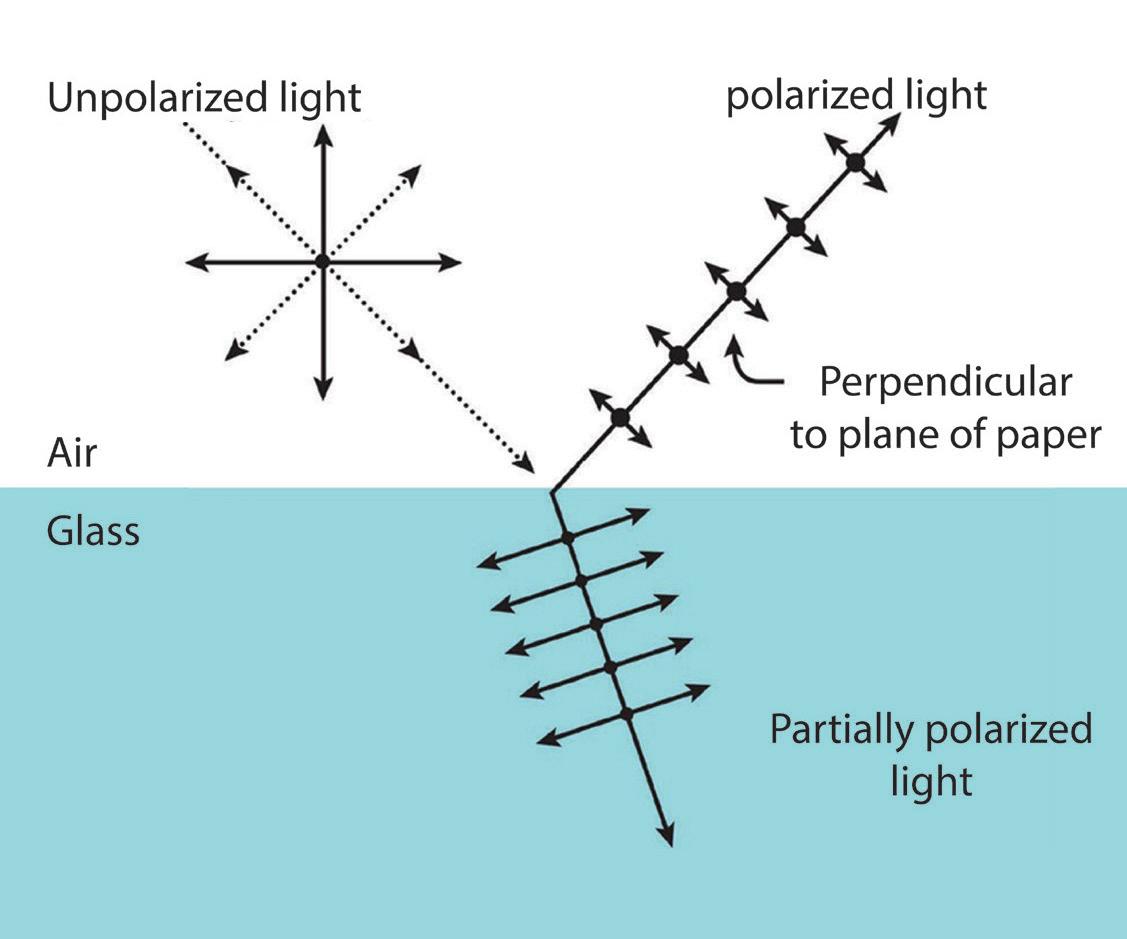
Description of the image. When an electromagnetic wave is reflected from a surface, the wave interacts with the reflective surface in accordance with Brewster’s law. Brewster’s law states that an unpolarized electromagnetic wave reflected above a certain threshold incidence angle is known as Brewster angle. In other words, the diffuse light consists of waves vibrating in various random directions. It lacks a specific polarization orientation; its oscillations are in all planes. When diffuse light strikes the surface of a transparent medium (such as glass or water) at a particular angle, the light can be partially polarized. This angle is known as the Brewster’s angle. At Brewster’s angle, the component of light parallel to the surface becomes strongly reflected, while the component perpendicular to the surface is mostly transmitted. This phenomenon is due to the way electromagnetic waves interact with the surface electrons in the medium. The reflected light is now partially polarized because it consists predominantly of waves oscillating in one plane (the plane of incidence). This means the light is polarized in the direction parallel to the surface.
Polarized light is often used as a part of PDT, a medical treatment that involves the activation of photosensitizing agents by specific wavelengths of light. This treatment is used in oncology to target and destroy cancerous cells. The polarized light helps to precisely deliver the therapeutic light to the affected area while minimizing damage to surrounding healthy tissue.
Polarized light therapy has been explored for its potential in promoting wound healing. By improving blood circulation and tissue regeneration, it can help wounds heal more quickly and with reduced scarring. This application is particularly relevant in the treatment of chronic wounds and ulcers. Polarized light therapy is also used in the treatment of musculoskeletal injuries and in pain management. It can
help reduce inflammation, relieve pain, and promote tissue healing in conditions such as arthritis, tendinitis, and sports-related injuries. In dentistry, polarized light therapy can aid in treating conditions such as temporomandibular joint (TMJ) disorders by reducing pain and inflammation in the jaw joint and surrounding tissues. Polarized light therapy may be employed to treat certain dermatological conditions, including acne and psoriasis. It can help reduce inflammation and improve skin health.
In conclusion, we can characterize polarized light as:
Polychromatic – Uni-directional (photons of the same wavelength are organized in one plane), polarized – Incoherent
Laser Light
Laser light, short for “Light Amplification by Stimulated Emission of Radiation,” is a type of light characterized by its unique properties. It is produced using a device called a laser, which emits highly focused and coherent light. Laser light is coherent, meaning that the individual photons (particles of light) emitted by a laser have the same frequency and are in phase with each other. This results in a well-defined and narrow beam of light that doesn’t spread as widely as ordinary light sources.
Laser light is typically monochromatic, meaning it consists of a single specific wavelength or color. This single color is determined by the laser’s design and the properties of the lasing medium. Laser light is also highly directional and can be focused into a very narrow beam over long distances. This property allows laser light to
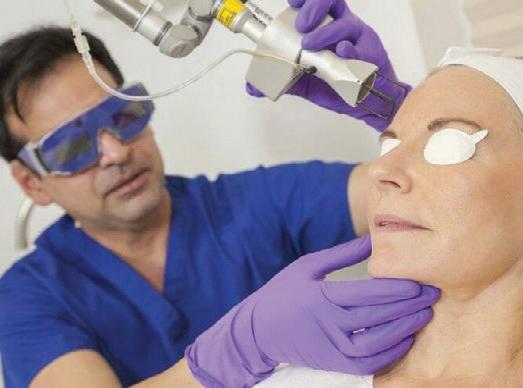
A dermatologist performing laser treatment on a woman’s skin.
be used for precision applications, such as cutting, engraving, and telecommunications. Laser light can be extremely intense, capable of delivering a concentrated and powerful energy source. This makes it valuable in various medical applications such as Low-Level Laser Therapy (LLLT). Also known as photo-biomodulation, LLLT uses polarized or coherent light from lasers or LEDs at specific wavelengths to stimulate tissue repair, reduce pain, and decrease inflammation. It’s used in various medical fields, including physical therapy, sports medicine, and dermatology (Mussttaf et al., 2019). In summary, laser light is: – Monochromatic
Directed – Coherent – Polarized
Diffuse Light

– Polychromatic (photons of various wavelengths)
– Multi-directional (random scattering)
– Incoherent (not in phase, neither spatially nor temporally)
– EM components are mutually orthogonal but their orientation is random.
Linearly Polarized Light
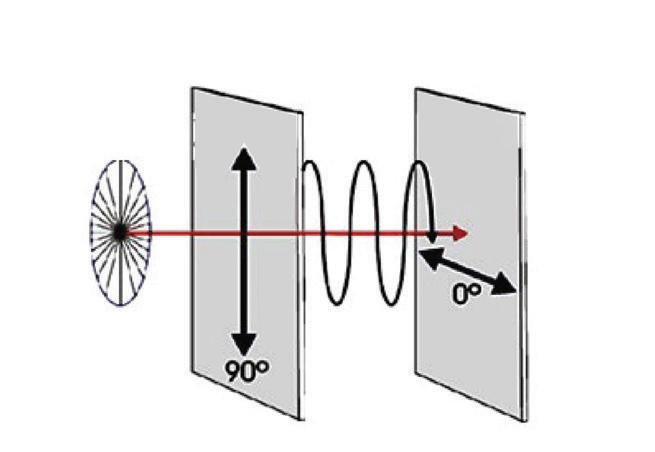
– Polychromatic (photons of various wavelengths)
– Photons of the same wavelength are organized in a plane
– Incoherent (not in phase, neither spatially nor temporally)
– Vertical or horizontal polarization is possible
Laser Light
– Monochromatic (photons of the same wavelength)
– Directed (high energy per mm2)
– Coherent (in phase, spatially and temporally)
– Vertical or horizontal polarization is possible
The three basic light types used today in traditional medicine.
Limitations of Diffuse, Linearly Polarized, and Laser Light
Diffuse light, polarized light, and laser light are all used in various therapeutic applications, each with its own set of advantages and limitations. Here are some of the limitations associated with each type of light in therapeutic applications:
1. Diffuse Light:
Diffuse light scatters in many directions and lacks the coherence and directionality of laser light. This makes it less precise for targeting specific tissues or cells. Diffuse light has limited tissue penetration capabilities, primarily affecting superficial tissues. It is less effective for treating deep-seated conditions or reaching internal organs. In addition, the energy density of diffuse light is generally lower compared to laser light, which can limit its therapeutic efficacy for certain applications.
2. Polarized Light:
Polarization techniques are often limited to a specific wavelength range, which can restrict their use for conditions requiring a broader spectrum of light. Polarized light therapies may require specialized equipment to generate and manipulate polarized light, making them more complex and costly. The effectiveness of polarized light can vary depending on the orientation of tissues, making it less predictable in some cases.
3. Laser Light:
Laser light is highly coherent and can deliver high energy densities, which can pose safety risks, including tissue damage or eye injury if not used with proper precautions. While some lasers can penetrate
tissues deeply, others have limited penetration, which can be a limitation for treating conditions deep within the body. Laser systems are often expensive to acquire and maintain.
Quantum Hyperlight: From Diffuse and/or Polarized to Hyper-Polarized Light
Quantum Hyperlight, also called hyperpolarized light, is created when diffuse or polarized light passes through a very specific “nanophotonic” light generator called fullerene C60.
A nanophotonic light generator is a device or system that generates light at the nanoscale using the principles of nanophotonics. Nanophotonics is a branch of optics and photonics that deals with the interaction of light with nanoscale structures, materials, and devices. It focuses on manipulating and controlling light at dimensions much smaller than the wavelength of light itself, typically at the scale of nanometers (billionths of a meter).
What is fullerene? Fullerene is a minute molecule made up of carbon atoms arranged in a spherical shape, resembling a miniature soccer ball. The most common type of fullerene is C60, which consists of 60 carbon atoms arranged in a pattern that forms a cage like structure. What makes fullerenes intriguing is their unique structure and properties.
They can absorb and emit light, making them useful in applications such as sensors, where they can detect specific substances based on their interaction with light. Additionally, fullerenes can be used in solar panels to help convert sunlight into electricity more efficiently. In essence, fullerenes are like minute carbon structures with special abilities that scientists have found invaluable for various purposes, including sensing and solar energy conversion. Fullerenes also have attracted
considerable attention in different fields of science. Their unique carbon cage structure coupled with their immense scope for derivatization makes them a potential therapeutic agent (Bhakta et al., 2020).
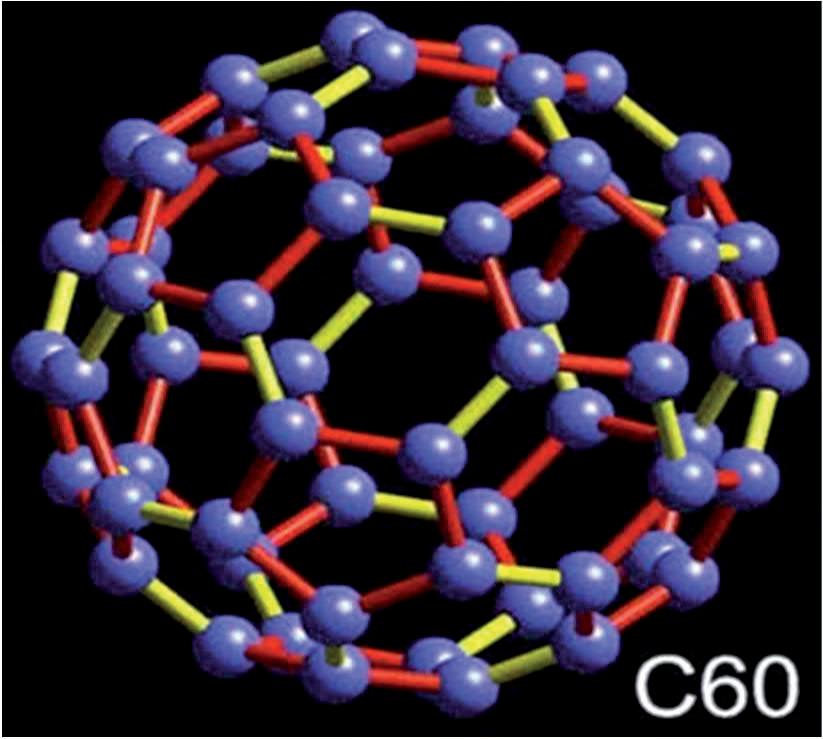
Chemical structure of fullerene C60.
Light passing through a fullerene-coated filter (nanophotonic fullerene C60 optics / Quantum Hyperlight Optics) will undergo various interactions and modifications, becoming what we call “structured light” containing wavelengths that are absorbed by all biomolecules, cells, and living body tissues, thereby improving and stimulating cellular metabolism in its entirety. Based on the discovery of fullerene C60, for which the Nobel Prize in Chemistry was awarded in 1996, and inspired by the properties of this special molecule, scientists developed the unique “Quantum Hyperlight” filter. Thanks to its quantum properties, Quantum Hyperlight can positively influence the molecules responsible for various healthy elementary processes, potentially bringing the body back to a state of optimal health (Koruga D, 2018).
We will explain how fullerene was discovered and how it interacts with human cellular components in the following chapters below.
CHAPTER 6:
The Discovery of Fullerene C60
In 1985, two scientists named Richard Smalley and Robert Curl at Rice University in Texas, USA, were conducting experiments to understand the properties of carbon molecules in space. They used a powerful laser to vaporize carbon from a graphite target (similar to the lead in a pencil) in an atmosphere of helium gas. As they studied the vaporized carbon in their experiment, they discovered something unexpected: Instead of finding the long chains or sheets of carbon atoms they were looking for, they found minute carbon clusters. These clusters were akin to microscopic soccer balls made entirely of carbon atoms.
One particular cluster caught their attention, featuring 60 carbon atoms arranged in a visually appealing spherical structure. The carbon atoms formed a hollow cage like structure with 12 pentagonal faces and 20 hexagonal faces. Each carbon atom was bonded to three others, creating a cluster of alternating pentagon and hexagon rings resembling a geodesic dome or soccer ball. It was this that lead the scientists to name the cluster “buckminsterfullerene” after the architect Buckminster Fuller, who designed geodesic domes.
This discovery was significant, marking the first time scientists had identified a novel form of carbon beyond the commonly known graphite and diamond. Fullerene C60 opened up a whole new field of nanotechnology and materials science, leading to many exciting discoveries and applications. So, in short, fullerene C60 was discovered purely by chance when scientists were investigating carbon using laser
technology, leading to the unexpected identification of these minute soccer ball-like structures composed of carbon atoms (Baggot J, 1994).
In 1996, the Nobel Prize in Chemistry was awarded to Richard Smalley, Robert Curl, and Sir Harold Kroto for their discovery of fullerenes. The Nobel Committee recognized the significance of this discovery in expanding our understanding of carbon chemistry and nanomaterials. Fullerene C60, with its unique soccer ball-like structure, opened up a new branch of chemistry called “nanotechnology.” It paved the way for the development of various carbon-based nanomaterials, including carbon nano tubes and graphene, which have had profound impacts on science and technology.
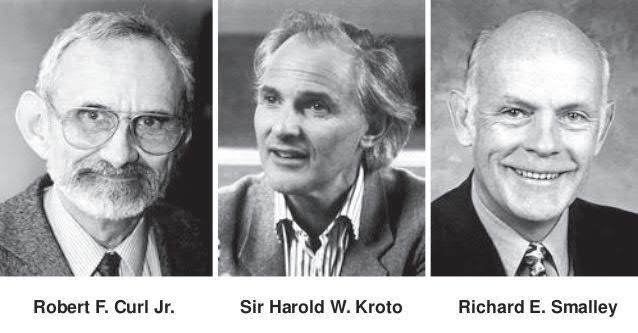
The three scientists who discovered fullerenes received the Nobel Prize for Chemistry in 1996.
CHAPTER 7:
How Quantum Hyperlight is Generated
Quantum Hyperlight is generated as the result of the interaction of diffuse or polarized light with a nanophotonic light generator fullerene C60. When diffuse light (emitted by a halogen bulb light source), collides or interacts with a polarizer (the Brewster’s optical unit), it reflects and becomes vertically linearly polarized light.
As the polarized light passes through the nanophotonic fullerene C60 filter, it interacts with the fullerene that rotates at a staggering rate of 18 billion times per second. As a result, the photons change their orientation: The Faraday effect is imposed on the 20 hexagons in C60 (the photon plane of polarization rotates within the hexagons). In addition, the Fibonacci Sequence effect is imposed on the 12 pentagons in C60 (the photon plane of polarization rotates and twists in all directions within the pentagons). Thus, the photons’ electrical plane of polarization changes direction from diffuse or polarized light to form hyperpolarized light that exhibits both left and right-handed circular polarization and vertical and horizontal linear polarization (“sunflower seed pattern”). This unprecedented, perfectly-ordered hyperpolarized light is called Quantum Hyperlight (Koruga D, 2018).
The key element is the icosahedral twisting structure (C60 molecules incorporated into the polymer material), generating photon distribution by creating a 2D energy membrane [Φ2+φ2=3] that “filters” propagating photons according to Fibonacci law [Φ, φ]. The final output is a Fibonacci twisting torus resulting from the dynamics of three (1, 2, 3) energy forms (left helix φ, right helix Φ) and
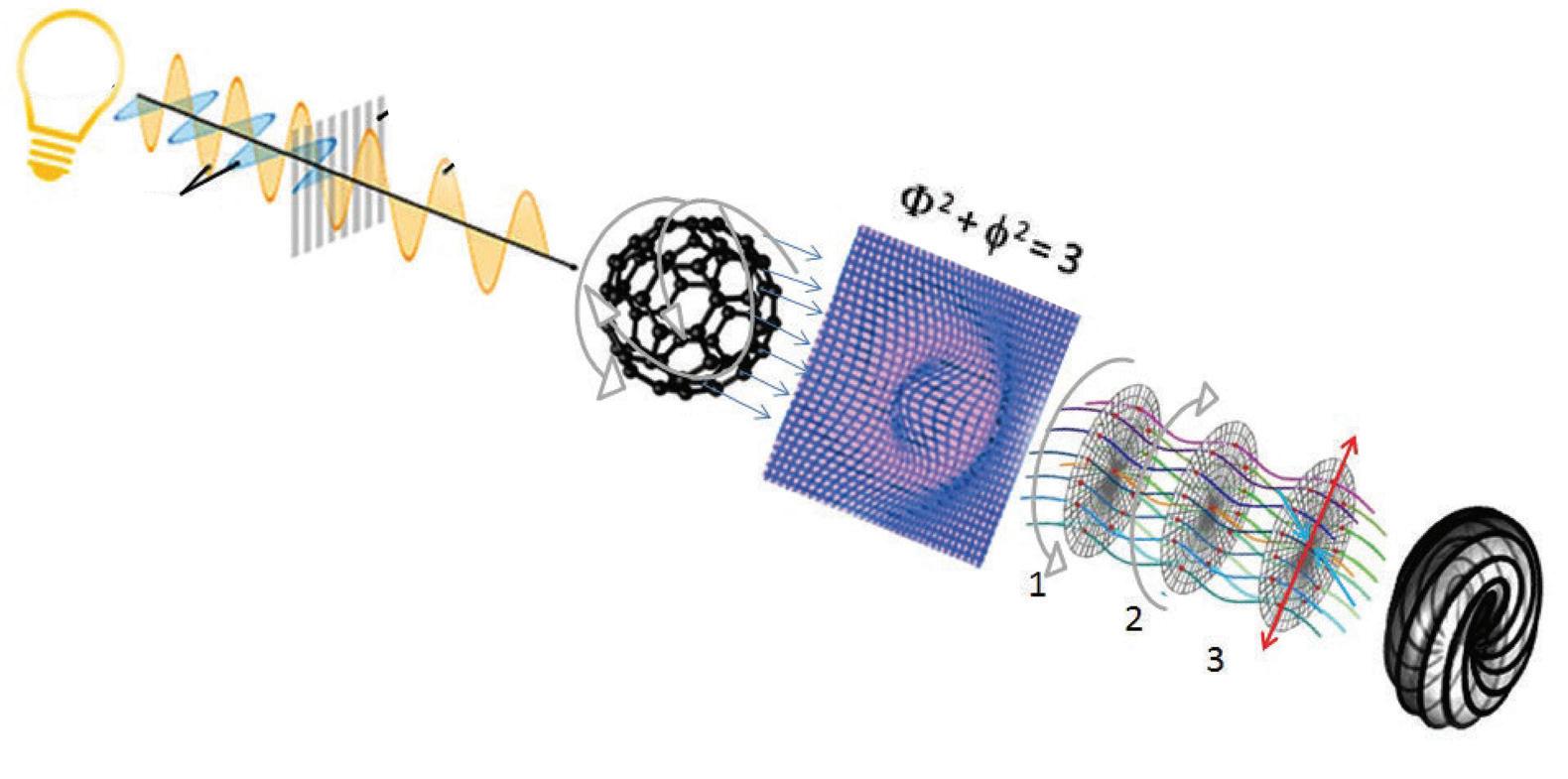
Schematic representation of nanophotonic light generation producing Quantum Hyperlight.
attractive- repulsive interactions determining the value at each intersection of the left and the right helix.
This concept was invented and patented by Prof. Djuro Koruga, an expert in the field of nanotechnology, information biotechnology, and biomolecular information processing. (Koruga, D, PCT patent/EP 2016/063174, 2016; WO 2017/211420 A l).
Fibonacci Features of Quantum Hyperlight: The Golden Ratio
The Fibonacci sequence is a famous series of numbers in mathematics, where each number is the sum of the two preceding ones. It starts with 0 and 1, and then each subsequent number is obtained by adding the last two numbers in the sequence (0, 1, 1, 2, 3, 5, 8, 13, 21, 34 etc.). The sequence is named after Leonardo of Pisa, an Italian mathematician also known as Fibonacci, who introduced it to the Western world in his book “Liber Abaci” (The Book of Calculation) published in 1202.


Above: The original Liber Abaci written by Leonardo of Pisa. At the bottom of the page is Leonardo’s famous rabbit problem, with its solution presented in the column of numbers on the far right: 1, 2, 3, 5, 8, [. . .], 377. This is now known as the Fibonacci sequence.
Below: The golden ratio is a mathematical ratio with a value equal to 1.618, derived from the Fibonacci series. The Fibonacci sequence begins with O and 1, and each subsequent number is the sum of the two preceding numbers: 1, 2, 3, 5, 8, 13, 21, 34, and so on.
The Fibonacci sequence exhibits some interesting mathematical properties and appears in various aspects of nature, art, and science where the Fibonacci sequence and the related “golden ratio” (the limit of the ratio of consecutive Fibonacci numbers) can be observed. The Fibonacci sequence and the golden ratio appear in various natural phenomena, such as the arrangements of leaves on a stem, the spirals of a snail shell, the patterns of seeds in a sunflower, and the proportions of various animal and the human body parts, or even
the shape of storms (see image below). In certain biological growth processes, such as the formation of certain plant structures and the arrangement of cells during tissue development, patterns that approximate Fibonacci numbers or logarithmic spirals emerge. These patterns are believed to be the result of efficient packing arrangements and optimal growth strategies.
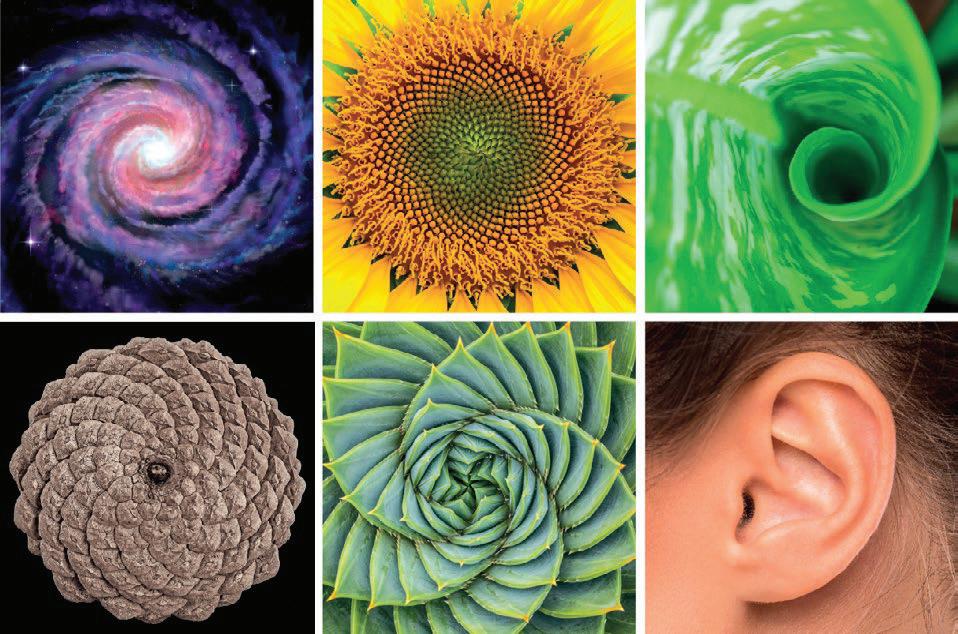
Fibonacci Sequences in the Human Body
Fibonacci numbers and golden rations have been described for the several parts of human body all the way down to the cellular and molecular level, such as the branching of lung buds during embryogenesis, arrangement of nucleic acid bases in the spiral of DNA, and in colon stem cell turnover (Ravindra et al., 2022). The regulation of the cardiovascular system also appears to be associated with the golden ratio (Ozturk et al., 2016).
Examples of structures in nature that comply with the Fibonacci sequence.
The unique photon pattern of Quantum Hyperlight, characterized by icosahedral symmetry and arranged according to the Fibonacci law, therefore provides the ideal energy-informational structure or symmetry that is energetically compatible with human biostructures based on Fibonacci sequences, and can therefore be “optimized” using the principles of biomimicry. In his book “Hyperpolarized Light: Fundamentals of Nanobiomedical Photonics,” Koruga et al. describe that many biological structures, such as water, microtubules, collagen, cilia, centrioles, and clathrin etc. and totaling almost 75% of the human organism, are actually Fibonacci structures based on icosahedral symmetry (Koruga D, 2018).
Biophotons and the Principle of Biomimicry
It has been scientifically proven that every cell in our body emits more than 100,000 light impulses or photons per second (Hamouda, 2018). These light emissions, otherwise known as biophotons, have been found to be the steering mechanisms in all biochemical reactions (Cifra et al., 2015; Rizzo et al., 2016). Cell-to-cell communication based on photon emission has been studied in the last 80 years, starting with the discovery made by A. Gurwitsch, who demonstrated that cell division is triggered by extremely weak ultraviolet photocurrents (Gurwitsch A, 1923). Lateron F. Popp provided further evidence of their existence and their role in biological processes, including intracellular and intercellular communication, cell growth and differentiation, and interactions among biological systems (Popp F, 2003).
In the last decades, human biophoton emission, also called ultra-weak photon emission or UPE, has become accepted by the scientific community as a phenomenon occurring in all living organisms,
including plants, animals, and humans, as a process in which living cells emit extremely faint levels of light in the form of photons. These emitted photons are of very low intensity, typically in the range of several photons per square centimeter per second. Some researchers have explored potential correlations between UPE and health or disease conditions (Van Wijk et al., 2005). For example, changes in UPE patterns have been observed in relation to physiological states, circadian rhythms, and pathological conditions. In addition, recent studies have described the influence of age, brain activity, and disease states on UPE. (Zapata et al., 2021; Fertig et al., 2022).
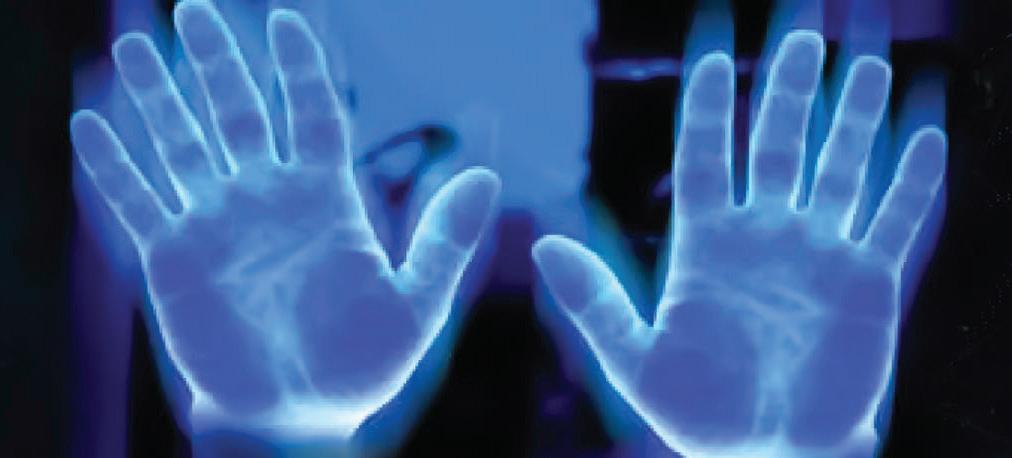
The human body emits biophotons, also known as ultra-weak photon emissions (UPE), with a visibility 1,000 times lower than the sensitivity of our naked eye (source: Psy- Teklabs, CA, USA).
The word “biomimicry” is derived from “bio,” meaning life, and “mimesis,” meaning to imitate. Biomimicry focuses on understanding the functions and mechanisms of biological systems. Biomimicry can be found in human tissues and refers to certain structures or functions that resemble or imitate other objects or organisms in nature. This mimicry can have various purposes, including improved function,
protection, or adaptation to specific environments. Examples of mimicry found in human tissues are mucus and cilia in the respiratory system, lens mimicry in the human eye, microvilli in the digestive system, and the structure of human bones.
Within cells, various biochemical pathways and molecules can mimic or resemble structures found in other organisms. For example, certain enzymes and receptor proteins can have structures that mimic naturally occurring substances or the shapes of molecules that they interact with, allowing for specific biochemical interactions. One example is clathrin. Clathrin is a protein that plays a crucial role in the process of intracellular transport in eukaryotic cells. It is a key component of the clathrin-coated vesicles, which are small membranous sacs that transport various molecules within the cell. Clathrin is a fundamental protein involved in cellular trafficking, and its study has significantly advanced our understanding of intracellular transport mechanisms and cellular communication.
Due to the symmetrical icosahedral similarities of C60, fullerenebased Quantum Hyperlight is ideal for therapy based on the principle of biomimicry. Biomolecules are by structure and energy related to information, and can therefore be altered by newly created light. If both light and biological structures have the same type of symmetry and organization, a mutual recognition of structural patterns occurs that results in resonant interaction (Litchinister N, 2012). Such isocahedral symmetry can be found in water molecule clusters, which make up 70% of the human organism. But also, collagen (40% of all protein), clathrin (fundamental protein in cellular trafficking), microtubules (the dominant cytoplasmic protein for cell transport), cilia (functional structures on the surface of epithelia), and centrioles, microtubular structures involved in cell division, have structural features that allow resonant energy interactions (Koruga et al., 2023).
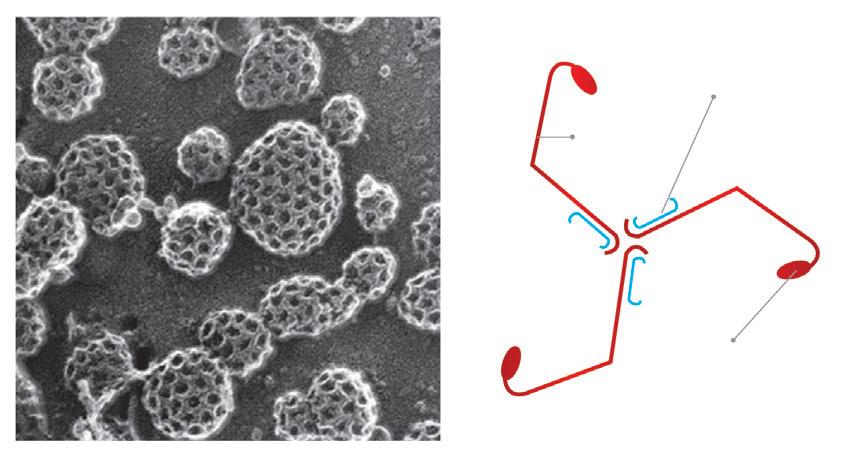

Microscopic image of clathrin (left), triskelion shape, and the network of 36 triskelions forming clathrin (middle). Schematic structure of fullerene C60 (right).
PART III: Commercial Applications of Fullerene-Based Quantum
Hyperlight
In part III of this book, we will be describing three very different commercial applications of fullerene C60-based Quantum Hyperlight:
1. The Bioptron Quantum Hyperlight Therapy System (a lamp) is a medical device that uses a special type of light to provide therapy for various health conditions. In simple terms, Bioptron works by emitting a specific type of light called polarized light. This light is different from regular light because its waves move in a specific direction. When this polarized light is applied to your skin, it can have various therapeutic effects. These effects include promoting healing, inducing pain relief, improving circulation, and even enhancing your mood. Bioptron can be used for a wide range of health issues, such as wound healing, skin conditions, pain relief, and improving your overall well-being. Combined with the nanophotonic fullerene filter Bioptron generates Quantum Hyperlight. We will explain in more in detail what the unique features of Bioptron Quantum Hyperlight are.
2. The Quantum Hyperlight Optics: These are special glasses which integrate the fullerene C60 nanophotonic optics in the lenses to produce Quantum Hyperlight. Wearing these glasses will stimulate the optimal functioning of biomolecules in the brain, improving your mental state so that you will sleep better, see better, perform faster, and feel healthier and happier in general.
3. The Quantum Hyperlight cosmetics: These are cosmetic products in which a derivate of the fullerene C60 nanophotonic filter is mixed as the main active ingredient. Applying these cosmetic products on your face and skin will generate similar beneficial effects as those achieved through exposure to light, i.e., improving skin function and texture, and stimulating cellular energy.
CHAPTER 8: Bioptron Quantum Hyperlight Light
Therapy in Medicine
The Bioptron Quantum Hyperlight Therapy System
The Bioptron Quantum Hyperlight Therapy System is a non-invasive light emitting device, with clinically proven efficacy in promoting wound healing, inducing pain relief, improving dermatological disorders and reducing symptoms of seasonal affective disorders, with no known side effects. The Bioptron Quantum Hyperlight Therapy System’s proven efficacy is based on more than 30 years of experience, resulting in 50+ scientific publications demonstrating its safety and efficacy.
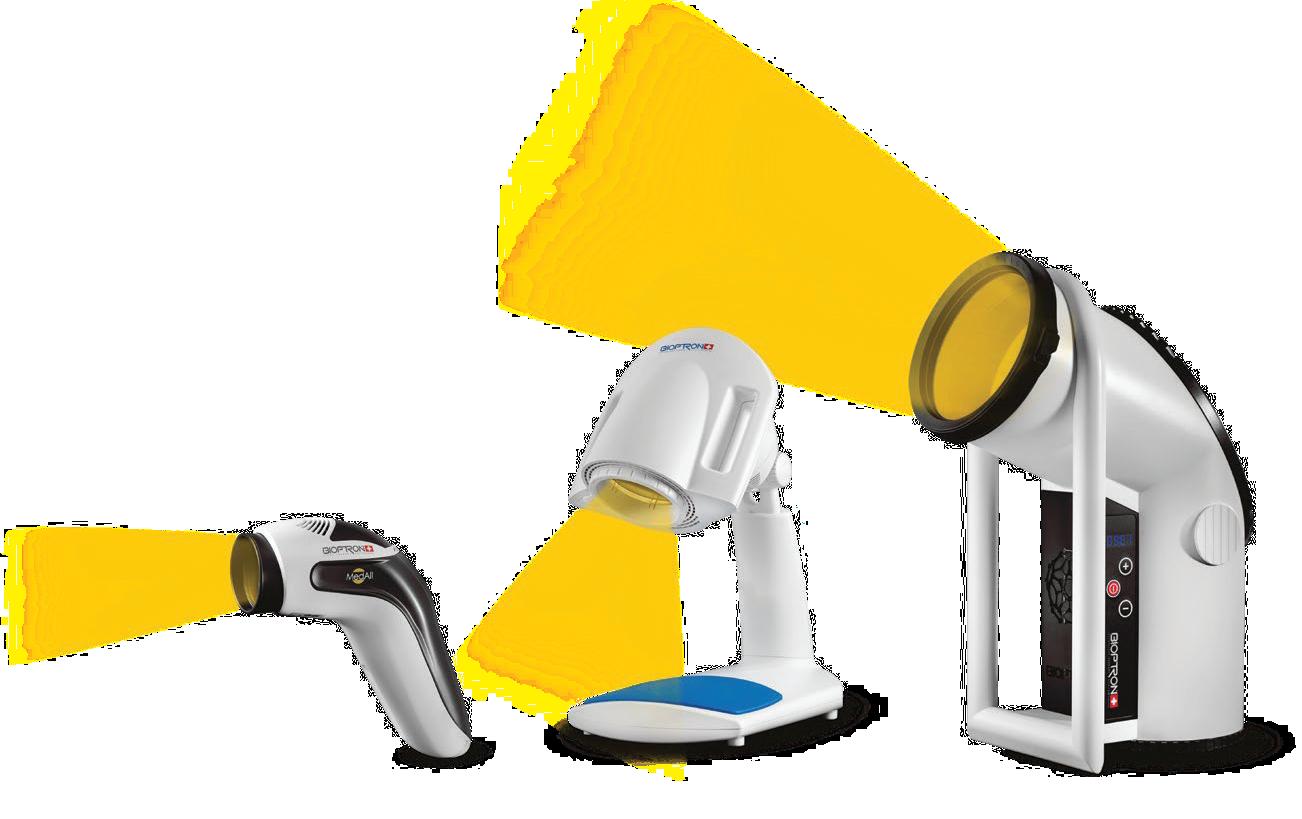
Bioptron Quantum Hyperlight therapy devices.
Bioptron light therapy puts forward the breakthrough advantages of fullerene C60-filtered light: Hyperpolarized Quantum Hyperlight obtained through the nanophotonic fullerene C60 filter (Chemistry Nobel Award 1996). Due to its unique quantum properties based on the principles of biomimicry, Bioptron Quantum Hyperlight provides the energy required to optimize cellular processes and tissue regeneration in the human body.
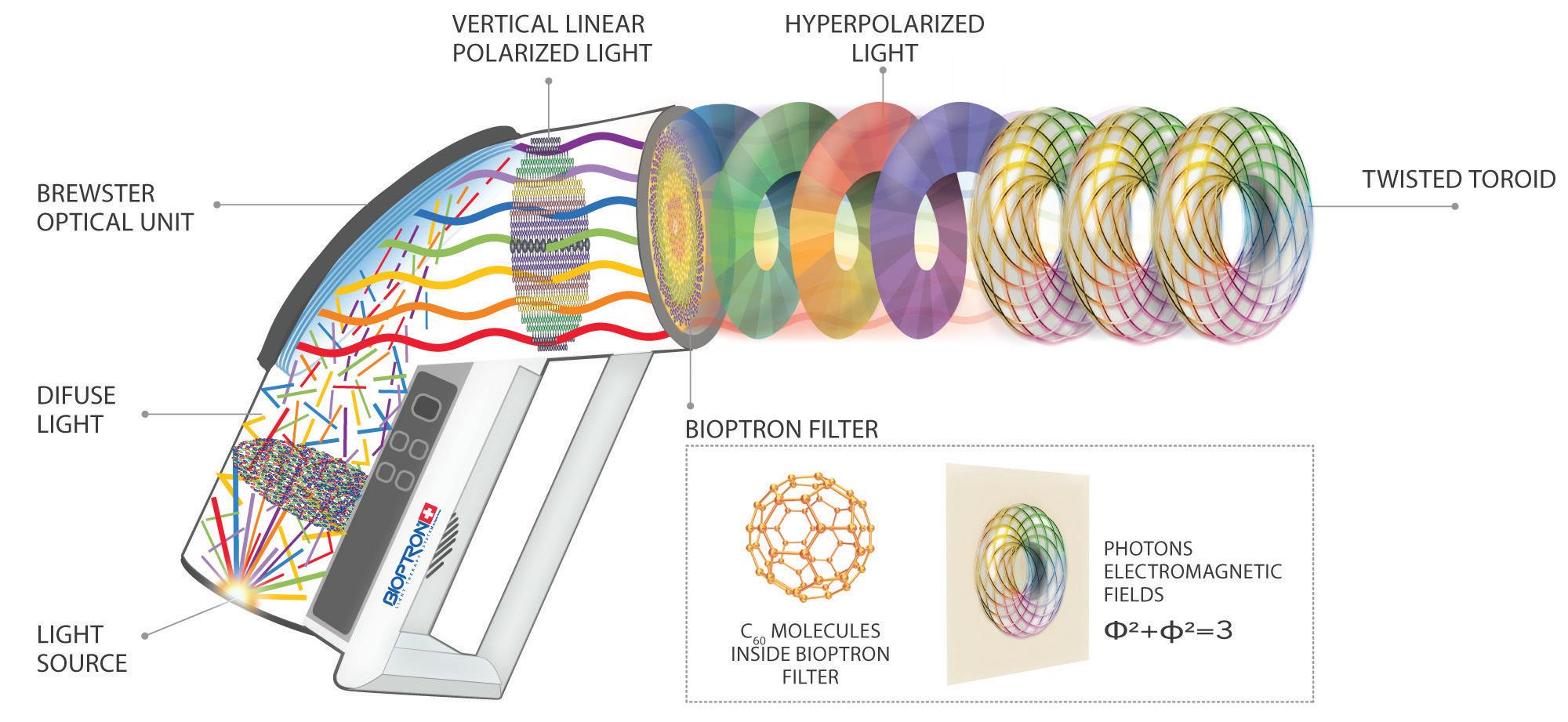
Schematic representation of how Quantum Hyperlight is generated by the Bioptron Quantum Hyperlight Therapy System as explained in Chapter 7.
Bioptron Quantum Hyperlight is based on the unique combination of four specific light characteristics that have bio-stimulating effects.
1. Hyperpolarized: 95% of polarization, ensures optimal quantum light penetration of tissues at the application site to stimulate cellular processes.
2. Polychromatic: Contains the visible light and a portion of the infrared spectrum (350 to 3,400 nm).
3. Incoherent: Dynamic penetration without the risk of damaging cells and tissues.
4. Low energy: Consistent intensity of 2.4 J/cm2 per minute for a safe and precise dose (power density 40 mW/cm2).
Medical Device Certifications for Clinical Efficacy
Bioptron Quantum Hyperlight Therapy System devices are certified medical devices in Europe (93/42/EEC) for pain relief, wound healing, dermatological disorders, and seasonal affective disorder (SAD). In the USA, the Bioptron device is certified for pain relief in neck and shoulders.
Each year, millions of people suffer from injuries and illnesses. Conventional treatment of these painful and often life-threatening conditions is, in most cases, based on the use of pharmaceutical drugs. However, the risk of undesirable side effects and the costs involved are considerable, hence why more and more people are seeking alternative therapies that minimize the risk of side effects and preserve the body in the long term without sacrificing efficacy.
Bioptron’s mission is to provide such a cost-effective medical therapy system that yields excellent results and has no side effects. Swiss-made, with cutting-edge technology and an innovative, user-friendly design, Bioptron Quantum Hyperlight Therapy System devices are a supportive tool to accelerate healing and decrease pain and inflammation, forming a highly effective treatment method for soft tissues regeneration with no secondary side effects.
Bioptron Quantum Hyperlight Therapy System devices are designed for home use, offering convenience and ease of use for individuals who may not have regular access to a healthcare facility or clinic. To date, over 3,5 million devices have been sold and are being used successfully in family homes and professional care centers.
We will now review the therapeutic applications for which Bioptron Quantum Hyperlight obtained regulatory medical device certification:
– Wound healing
– Pain relief
– Applications in physiotherapy and sports medicine
– Dermatology and skin diseases
– Skin aging
– Seasonal affective disorders
Wound Healing
Chronic wounds have a substantial impact on patients’ quality of life and are a therapeutic challenge, as they often do not respond to standard treatments. Wounds are the reason for many consultations and hospitalizations, and are also the cause of prolonged hospitalizations. Chronic wounds are a major public health burden in terms of health costs. Complex and non-healing wounds are not only painful, they can be life-threatening. Whether a wound is the result of a traumatic injury, a bum, an infection, a disease, or any other condition, it requires timely and effective care. Healthcare professionals are showing growing interest in using a combination of different concurrent treatment methods to manage chronic wounds.
Bioptron Quantum Hyperlight therapy is an exceptional technology that offers effective and economical treatment of complex and nonhealing wounds, on any part of the body, including those caused by diabetes, vascular disease, pressure ulcers, and other health concerns.
Multiple clinical trials in regenerative medicine demonstrate that the use of Bioptron Quantum Hyperlight therapy greatly enhances inner
tissue regeneration processes, resulting in faster wound healing with minimal scarring.
In addition, Bioptron Quantum Hyperlight therapy cuts the number of costly wound dressings needed, shortens hospitalization durations, and relieves pain and inflammation across the entire healing process.
Lastly, Bioptron Quantum Hyperlight therapy has no known side effects!
Here’s how Bioptron Quantum Hyperlight therapy can promote wound healing:
– Increased blood flow: The hyperpolarized light from the Bioptron device penetrates the skin to reach the blood vessels below. This exposure to light can stimulate the release of nitric oxide, which helps to dilate the blood vessels, increasing blood flow to the wound area. Improved circulation is crucial for delivering essential nutrients and oxygen to the site of the wound.
– Reduction in inflammation: Bioptron Quantum Hyperlight therapy has anti-inflammatory effects. It can help to reduce swelling and inflammation around the wound, which can be especially beneficial in the early stages of wound healing.
– Stimulation of cellular healing: Quantum Hyperlight energy can also stimulate cellular activity. It can promote the production of collagen and fibroblasts, which are essential for tissue repair and wound closure. This can lead to faster wound healing and potentially less scarring.
– Pain relief: Bioptron Quantum Hyperlight therapy may help relieve the pain associated with wounds. By reducing inflammation and promoting healing, it can alleviate discomfort and allow patients to heal with less discomfort.
– Improved immune response: Bioptron Quantum Hyperlight therapy can also have a positive impact on the immune system. A stronger immune response can help protect the wound from infection and support the healing process.
Multiple clinical trials have proven that the Bioptron Quantum Hyperlight Therapy System is a successful treatment method for the management of:
– Venous leg ulcers (Jankovic A, 2005 ; Medenica et al., 2003 ; Jankovic et al., 2010 ; Aragona et al., 2017 ; Waked et al., 2021)
– Pressure ulcers (Al-Kader et al., 2015 ; Bialozyt et al., 2018 ; Durovic et al., 2008 ; Iordanou et al., 2002 ; Aragona et al., 2017 ; Waked et al., 2021 ; Chen et al., 2023)
– Diabetic foot ulcers (El-Deen et al., 2014 ; Mohamed et al., 2019 ; Taha et al., 2022)
– Burns (Monstrey et al., 2002; Mowafy et al., 2021, 2022; Abdel-Mageed et al., 2015)
– Skin grafting (Monstrey et al., 2002)
– Post-surgical wounds, including cesarian section, episiotomy (Simic et al., 1999, 2001, Colic et al., 2004; Kymplova et al., 2003; Ahmed et al., 2020; Monstrey et al., 2002; Mohamed et al., 2016)
– Skin injuries (Abdou et al., 2019 ; Rutterman et al., 2017 ; Nardi et al., 2021, Abd-Elhamed et al., 2022)
Below are some images and results collected during the clinical research trials investigating Bioptron Quantum Hyperlight in the treatment of a variety of different wounds.
Venous leg ulcers:
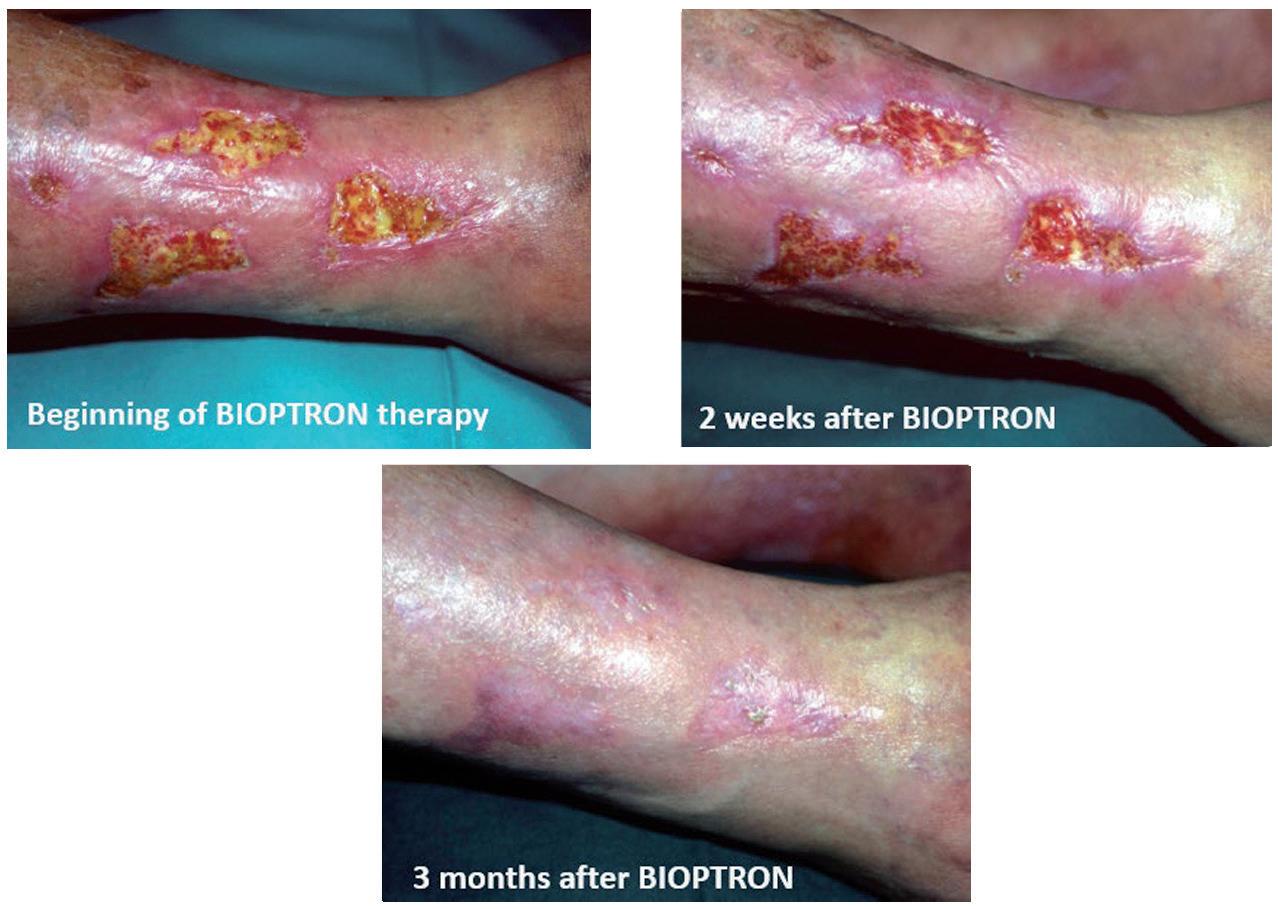
A chronic venous ulcer treated daily with Bioptron Quantum Hyperlight for 10 minutes. (Medenica et al., 2003)
Pressure ulcers:
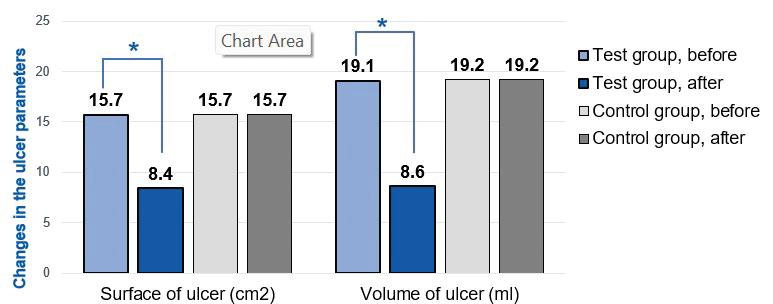
Changes in ulcer parameters in 15 patients treated with Bioptron Quantum Hyperlight (10 min. per session, twice a day) versus 15 non- treated patients. Significant reductions in ulcer surface and volume were observed within 4 weeks in patients with pressure ulcers treated with Bioptron Quantum Hyperlight therapy (Al-Kader et al., 2015).


Evaluation of wound closure in a patient suffering from a chronic pressure ulcer treated with Bioptron Quantum Hyperlight for 10 minutes each day.
Diabetic foot ulcers:

Left graph: 20 patients were treated with Bioptron Quantum Hyperlight (blue bars), another 20 patients (control group) were not (grey bars). The decrease of ulcer surface area was 41.1 % in treatment group compared to just 25,1 % in the control group, showing that using Quantum Hyperlight treatment in combination with traditional wound care methods yields significantly better results than solely using traditional wound care methods.
Right graph: Similarly, a higher significant reduction in wound volume by 56.2% was shown in patients treated using Bioptron Quantum Hyperlight therapy compared to 31.8 % in the control group.
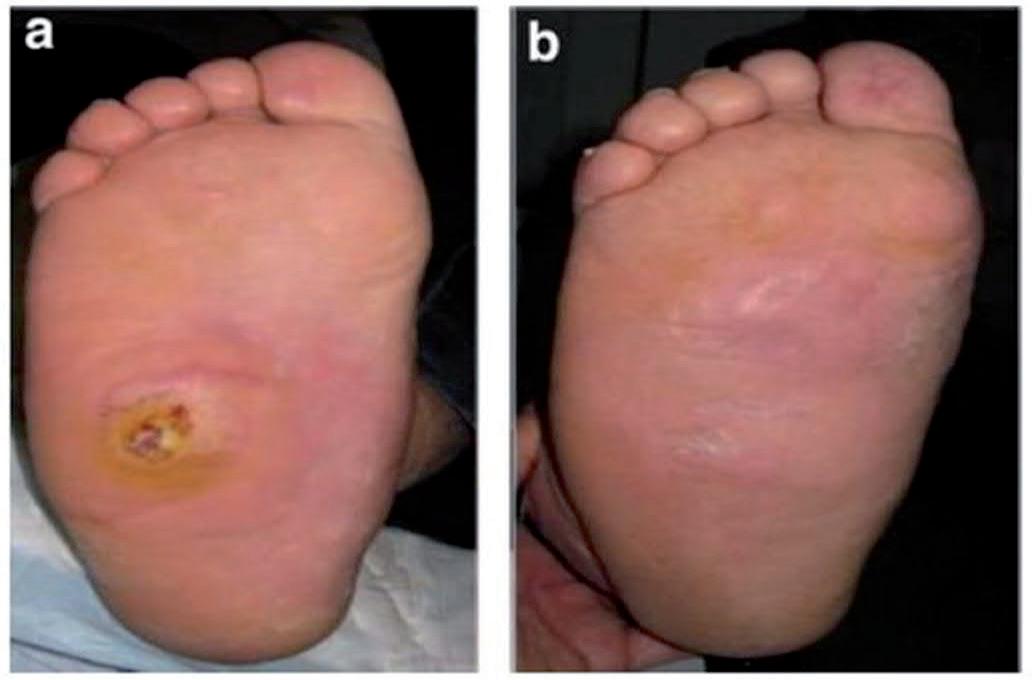
Image of a foot ulcer in a diabetic patient before treatment (a) and after treatment with Bioptron Quantum Hyperlight for 2 months (12 minutes, 3 times per week): Complete healing was achieved (b).
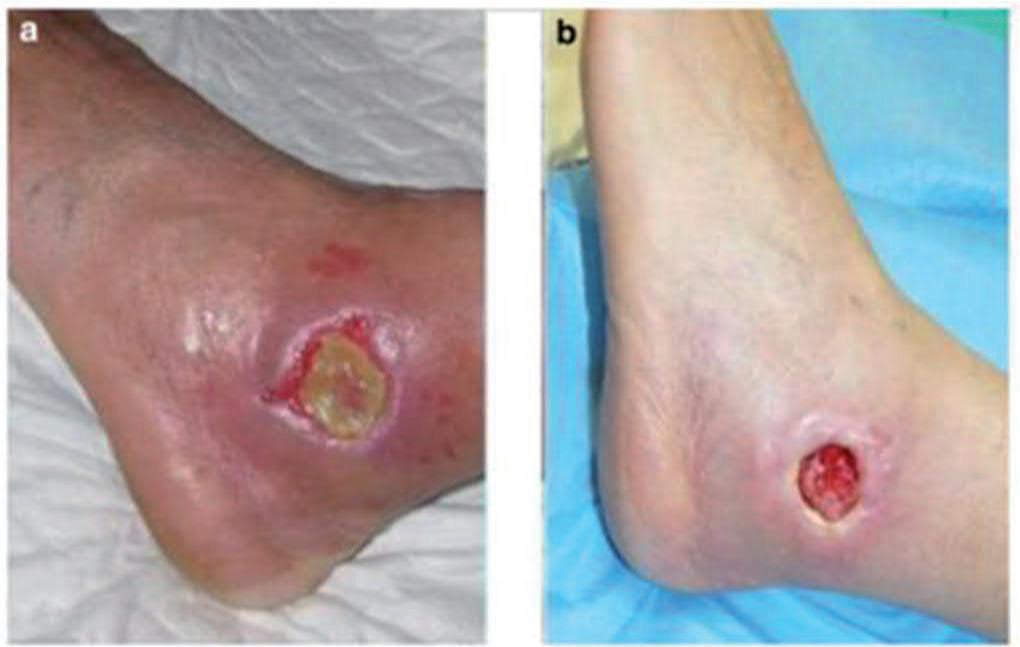
Image of a foot ulcer in a diabetic patient at the start of the trial (left) and after 2 months with no treatment with Bioptron Quantum Hyperlight (right).
All 40 patients who participated in this study had a positive finding in their microbial culture tests before treatment. After treatment, the cultures for 85% of the patients in the control group were still positive, compared to only 40% of the cultures in the Bioptron Quantum
Hyperlight group. There was a significant decrease in the positive finding of microbiota in the Bioptron Hyperlight therapy group after treatment compared to before treatment (Taha et al., 2022).
Deep Dermal Burns:
A young woman with a flame burns on her face and neck. Appearance of the burn wound 2 days after the injury (left). Bioptron Quantum Hyperlight treatment was started daily for 10 minutes per day. The wound closed after 12 days (middle-left). Appearance after 8 months (middle right) and after 15 months (right) (Monstrey et al., 2002).
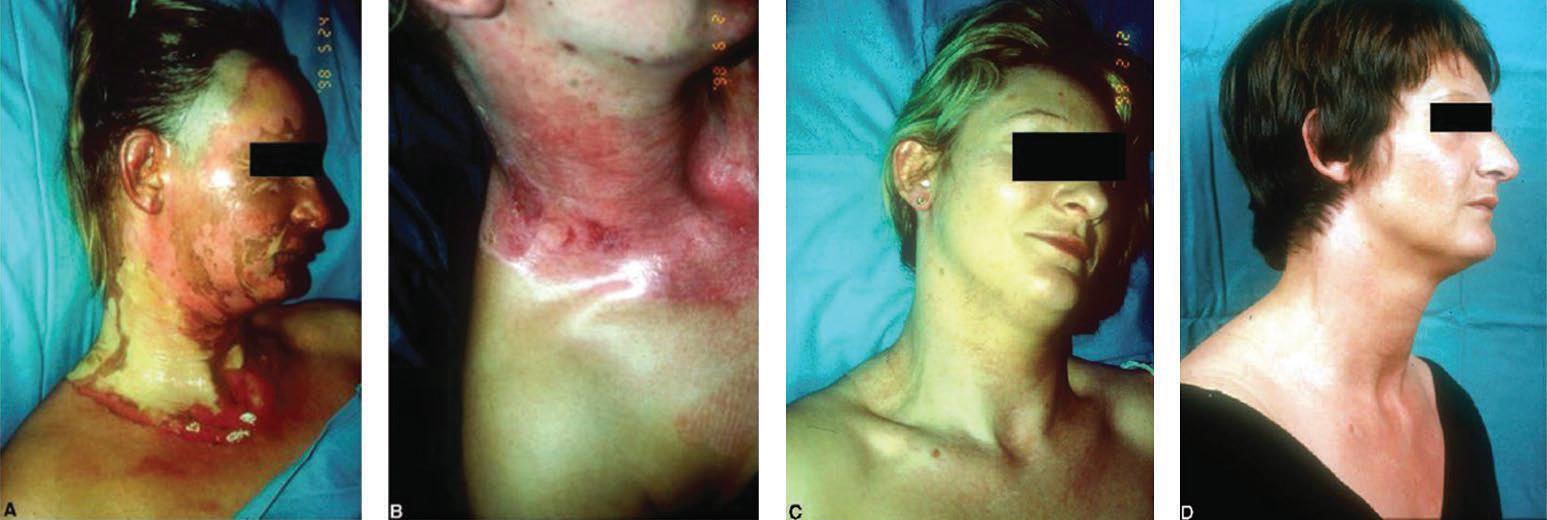
The clinical trials performed using Bioptron Quantum Hyperlight showed that the healing time of the burn wounds was much faster than expected. In addition, no hypertrophic scarring was observed. This accelerated healing process enabled patients to be discharged from the hospital sooner than usual.
Pain Relief
Pain is an extremely common and troublesome disorder; its treatment has always been -and particularly nowadays- an essential problem in medicine. It degrades quality of life for millions of people, and current
treatments present a long list of undesirable side effects to short and long-term effects such as nausea, vomiting, drowsiness, constipation, and dizziness. Especially long-term use of pain managing drugs can cause other serious problems:
– Addiction and dependence: Some pain medications, particularly opioids (e.g., morphine, oxycodone, and hydrocodone), have a high potential for abuse, addiction, and dependence. Long-term use or misuse of opioids can lead to physical and psychological dependence, making it difficult for individuals to stop using them, even when their pain is under control.
– Tolerance: With prolonged use, the body may develop a tolerance to pain medications, which may result in the same dose becoming less effective over time. To achieve the same pain relief, higher doses may be needed, increasing the risk of side effects and potential harm.
– Drug interactions: Pain medications can interact with other medications a person is taking, leading to adverse effects or reduced efficacy of either drug. It is essential for healthcare professionals to consider potential drug interactions and adjust the dosage or choose alternative medications if necessary.
– Gastrointestinal issues: Nonsteroidal anti-inflammatory drugs (NSAIDs) such as ibuprofen and aspirin can cause gastrointestinal problems such as stomach ulcers, bleeding, and perforation, especially if taken for an extended period or in high doses.
– Liver and kidney damage: Certain pain medications, especially those containing acetaminophen, can cause liver damage if
taken in excessive amounts or combined with alcohol. NSAIDs can also affect kidney function, leading to kidney damage or exacerbating existing kidney problems.
– Respiratory suppression: Opioids can suppress the respiratory system, leading to slow and shallow breathing, especially when taken in high doses or combined with other drugs that have sedative effects. This can be life-threatening if not addressed promptly.
– Allergic reactions: Some individuals may experience allergic reactions to pain medications, ranging from mild rashes to severe anaphylaxis, a potentially life-threatening condition.
– Masking underlying issues: Pain medications can mask the symptoms of an underlying medical condition, making it challenging to diagnose and treat the actual cause of the pain.
– Misuse and overdose: If pain medications are not taken as prescribed or are used recreationally, there is an increased risk of overdose, which can be fatal.
Bioptron Quantum Hyperlight is considered an excellent and effective therapeutic tool in the treatment of almost any pain, without any known side effects. Bioptron Quantum Hyperlight therapy is frequently used as an integral part of the treatment protocols applied in physical therapy and rehabilitation for accelerated pain relief and healing:
Rheumatology and Chronic Pain:
Bioptron Quantum Hyperlight helps to alleviate pain and disability in patients suffering from various forms of rheumatism: it relieves, without any side effects and in combination with other
pharmacological and physical treatments, the main characteristic rheumatic symptoms:
– Decreases or relieves pain or discomfort, usually perceived in the vicinity of one or more joints
– Decreases motion pain of the affected area(s)
– Diminishes the inflammation of the affected region(s)
Bioptron Quantum Hyperlight therapy can be used in clinics and hospitals, but it is also suitable for home use to control pain in patients with rheumatology and chronic pain. Patients are able to treat themselves every day in their own home, increasing the adherence and commitment to the treatment.
The multiple clinical trials of Bioptron Quantum Hyperlight therapy medically certified its effectiveness for patients with rheumatology issues:
– Rheumatoid arthritis (Gallacchi et al., 1993 ; Karadzic M, 2001)
– Osteoarthritis (Abramovich et al., 2020; Marx A, 2007)
– Low back pain (Mihaylova et al., 2017)
– Neck and shoulder pain (Ballyzek et al., 2005)
– Carpal tunnel syndrome (Raeissadat et al., 2014 ; Stasinopoulos et al., 2005 & 2017)
– Tendinopathies in several joints (Stasinopoulos et al., 2005, 2006, 2009, 2019, 2020 (1&2)
– Musculo-skeletal injuries in sprains, strains (Stasinopoulos et al., 2017 ; Zlaktovic-Svenda et al., 2018)
– Post-surgery pain (Bahrami et al., 2023)
Here are some data from the clinical trials:
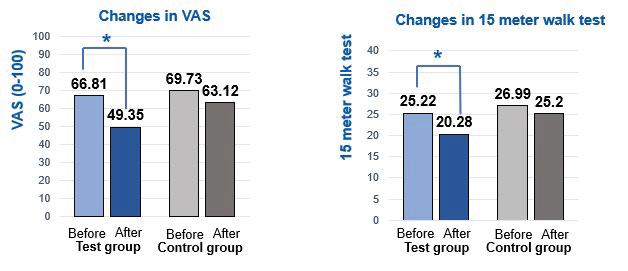

Changes in VAS parameters (Abramovich et al., 2020) in patients suffering from osteoarthritis treated (n=34) and not-treated (n=30) with Bioptron Quantum Hyperlight devices. Patients treated with Bioptron Quantum Hyperlight therapy reduced their pain values and improved their mobility. Treatment during 2 weeks, 6 minutes per session, 5 times a week. (VAS stands for Visual Analogue Scale, used to measure pain intensity; a high VAS means more pain).
Changes in VAS parameters and Roland-Morris questionnaire (self- rated physical disability caused by low back pain) (Myhailova et al., 2017) in patients suffering from low back pain treated (n=30) and not- treated (n=30) with Bioptron Quantum Hyperlight devices. Patients treated with Bioptron Quantum Hyperlight therapy reduced their pain values and improved their quality of life significantly more than patients not treated with Bioptron. Treatment during 4 weeks, 10 minutes per session each day.
Changes in Schober (measures the flexion of the lumbar spine) and Thomayer tests (used to assess spine stiffness) (Myhailova et al., 2017) in patients suffering from low back pain treated (n=30) and not- treated (n=30) with Bioptron Quantum Hyperlight devices. Patients treated with Bioptron Quantum Hyperlight therapy for 4 weeks, with 10-minute sessions each day, significantly improved their capacity to flex and bend the body, improving their overall mobility compared to non-treated patients.
The mechanism of action behind the Bioptron Quantum Hyperlight pain relief mechanism is that the light penetrates the skin and stimulates various biological processes. Several potential effects of Bioptron Quantum Hyperlight therapy that may contribute to pain relief include:
– Increased blood circulation: Quantum Hyperlight helps improve blood flow to the affected area, which can aid in reducing inflammation and promoting healing.
– Enhanced cellular metabolism: Quantum Hyperlight stimulates cellular activity, leading to faster tissue repair and regeneration.
– Activation of natural pain-relieving mechanisms: It is believed that certain wavelengths of light can trigger the release of endorphins, which are the body’s natural painkillers.
– Reduction of muscle tension: By promoting relaxation and reducing muscle tightness, Quantum Hyperlight therapy may alleviate pain caused by tense or overworked muscles.
–
–
Anti-inflammatory effects: Quantum Hyperlight’ s impact on the body’s immune response helps reduce inflammation, a common source of pain in various conditions.
Nerve modulation: Quantum Hyperlight therapy could potentially influence nerve activity, leading to pain relief.
Physiotherapy and Sports Medicine
Over the years, the importance of physiotherapy has been highlighted as key in assuring recovery and regain of lost joint function for a variety of medical conditions. Sports medicine is a growing branch of medicine aiming to treat and prevent injuries related to sports and exercise. Overall, the future of physiotherapy is likely to be characterized by a growing emphasis on technology, interdisciplinary collaboration, and patient-centered care that focuses on promoting overall health and wellness. In addition, the success of the physical therapy depends on its accessibility, because this has a direct impact on patient adherence.
Bioptron Quantum Hyperlight therapy is an accessible therapy for everyone, both in clinics and for home use, facilitating adherence and its use on a daily basis-a pivotal factor for the success of the entire treatment plan for each patient. Bioptron Quantum Hyperlight therapy is compatible with other treatment protocols, being a part of the integral interdisciplinary therapy to accelerate and optimize the rehabilitation of patients. Thanks to its synergic actions, Bioptron Quantum Hyperlight devices help patients by promoting their recovery and improving their overall well-being, while also supporting athletes by shortening the healing time of various sports injuries.
Bioptron Quantum Hyperlight Therapy eases patient discomfort during the recovery period and accelerates the healing process by:
– Accelerating tendons and muscular regeneration
– Improving muscle tensile strength
– Reducing inflammation and swelling
– Relieving pain or decreasing its intensity
– Increasing mobility in the affected body regions
Dermatology and Skin Diseases
Almost everyone is affected by skin diseases at some point in their life. Skin diseases are conditions that affect your skin for genetic reasons or due to lifestyle factors, and which may cause rashes, inflammation, itchiness, or other skin changes. Dermatologic disorders can be very distressing for the patient and can have a negative impact on their quality of life, causing psychological problems, including loss of confidence and feelings of depression. Another issue is that current treatments, used to calm the symptoms, may have side effects and are unpleasant for the patient. Some common side effects associated with various types of drugs for treating skin disease:
– Topical corticosteroids: These medications are commonly used to treat inflammation and itching associated with skin conditions such as eczema, psoriasis, and dermatitis. Side effects may include skin thinning, redness, burning or stinging sensation, and potential development of stretch marks.
– Topical immunomodulators (calcineurin inhibitors): Such drugs are used to treat inflammatory skin conditions. Common side effects include burning or itching at the application site and a potential risk of skin infections.
– Topical retinoids: Retinoids such as tretinoin and adapalene are used to treat acne and certain skin conditions. Side effects
may include skin dryness, redness, peeling, and increased sensitivity to sunlight.
– Systemic corticosteroids: In severe cases of certain skin diseases, oral or injectable corticosteroids may be prescribed. These can have more significant side effects, including weight gain, mood changes, increased blood pressure, and potential adverse effects on bone health and immunity if used for an extended period.
– Immunosuppressive drugs: In autoimmune skin diseases such as pemphigus or lupus, immunosuppressive drugs such as methotrexate, azathioprine, or mycophenolate mofetil may be used. Side effects can include increased risk of infections, gastrointestinal disturbances, and effects on blood cell counts.
– Biologic therapies: Biologics are a newer class of medications used to treat certain autoimmune skin diseases, such as psoriasis. They can have side effects such as increased risk of infections, injection site reactions, and potential effects on the immune system.
– Antifungal and antibacterial topicals: Topical antifungals and antibacterial agents used to treat fungal or bacterial skin infections may cause skin irritation, itching, or allergic reactions in some individuals.
– Phototherapy: Ultraviolet (UV) light therapy is used to treat certain skin conditions such as psoriasis. Side effects may include skin dryness, redness, and an increased risk of skin cancer with long- term use.
Bioptron Quantum Hyperlight therapy is an easy-to-use, painless device to promote skin healing and reduce the pain and discomfort associated with various skin disorders. Bioptron Quantum Hyperlight devices provide high-quality care to treat the symptoms of several skin
diseases, promoting the regeneration of the damaged skin and increasing the comfort and overall wellness of the patients, by:
– Promoting the skin regenerative process through increased fibroblast proliferation and migration
– Increasing collagen production
– Improving microcirculation
– Decreasing inflammation, rashes, and redness
– Relieving pain and discomfort
– Reinforcing the immune system to assist the body in fighting external pathogens
Bioptron Quantum Hyperlight devices can be used alone or in combination with other treatments as a part of integral treatment aiming to improve patients’ quality of life.
They can be used both in a clinical setting and at home by the patients themselves, ensuring an easy treatment with high patient adherence and guaranteed efficacy. The multiple synergic cellular effects of Bioptron Quantum Hyperlight therapy is therefore ideal for treating:
– Acne (rosacea) (Begic-Rahic J, 2005)
– Psoriasis (Nosseir et al., 2020 ; Waked et al., 2015)
– Atopic dermatitis / eczema (Leguina-Ruzzi et al., 2019 ; Mohamed et al., 2022 ; Marx A, 2007)
– Herpes simplex & zoster (Aronis et al., 1992 ; Kolenko A, 2017)
– Oral pain and inflammation (Petruzzi et al., 2019 ; Nemeth et al., 2020 ; Nardi et al., 2019 & 2022).
Below are some examples of published research:
Acne vulgaris: A 27-year-old woman with extensive inflammatory face infection after six months treatment with antibiotics. During the first 10 treatment days, Bioptron Quantum Hyperlight was applied twice
daily for 10 minutes, and once per day for 12 minutes starting from the 11th treatment day.
After 26 days, the skin pores closed coupled with a reduced propensity for the formation of new blemishes and blackheads. The affected pigmented areas gradually returned to a normal skin tone.
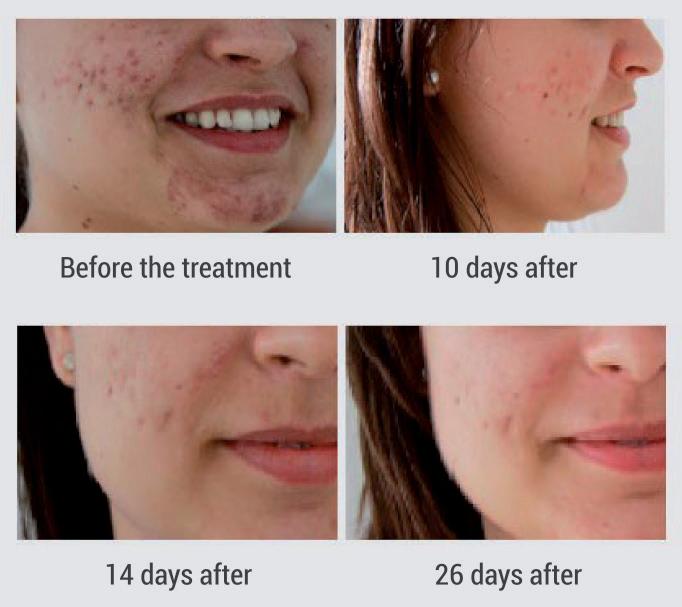
Psoriasis: The foot of a psoriasis patient before treatment (left), after 10 days treatment (middle), and 20 days (below).
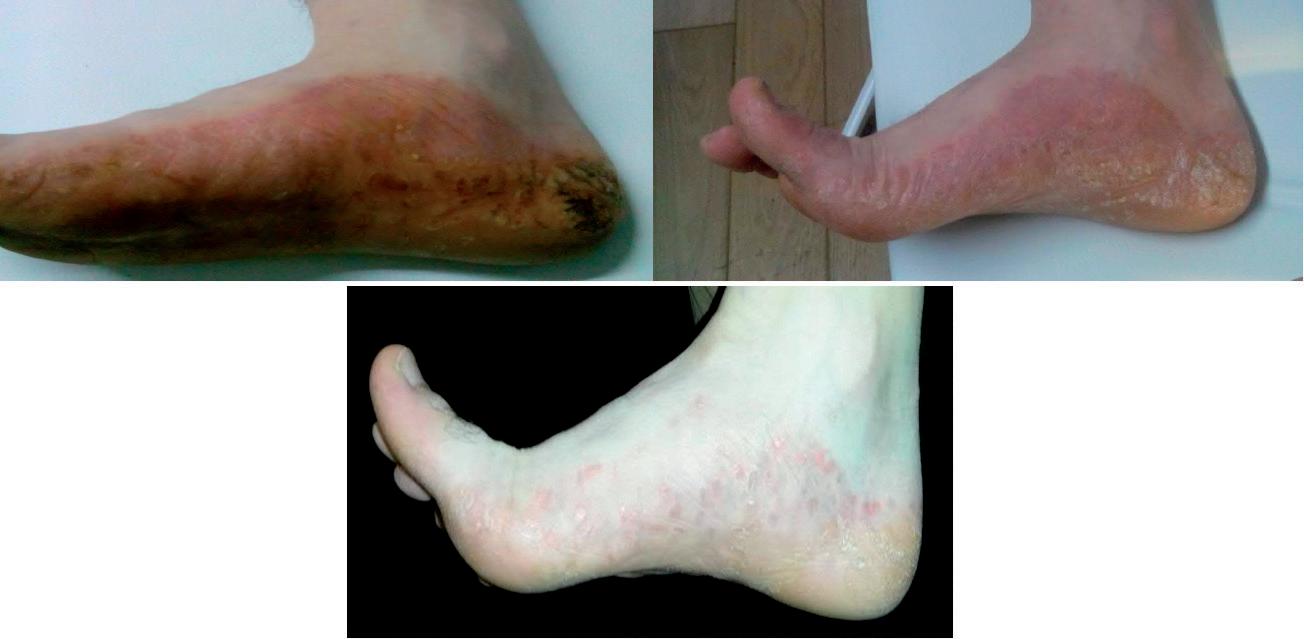
The back of a psoriasis patient before treatment (day 0) and during the course of 17 daily treatments with Bioptron Quantum Hyperlight.
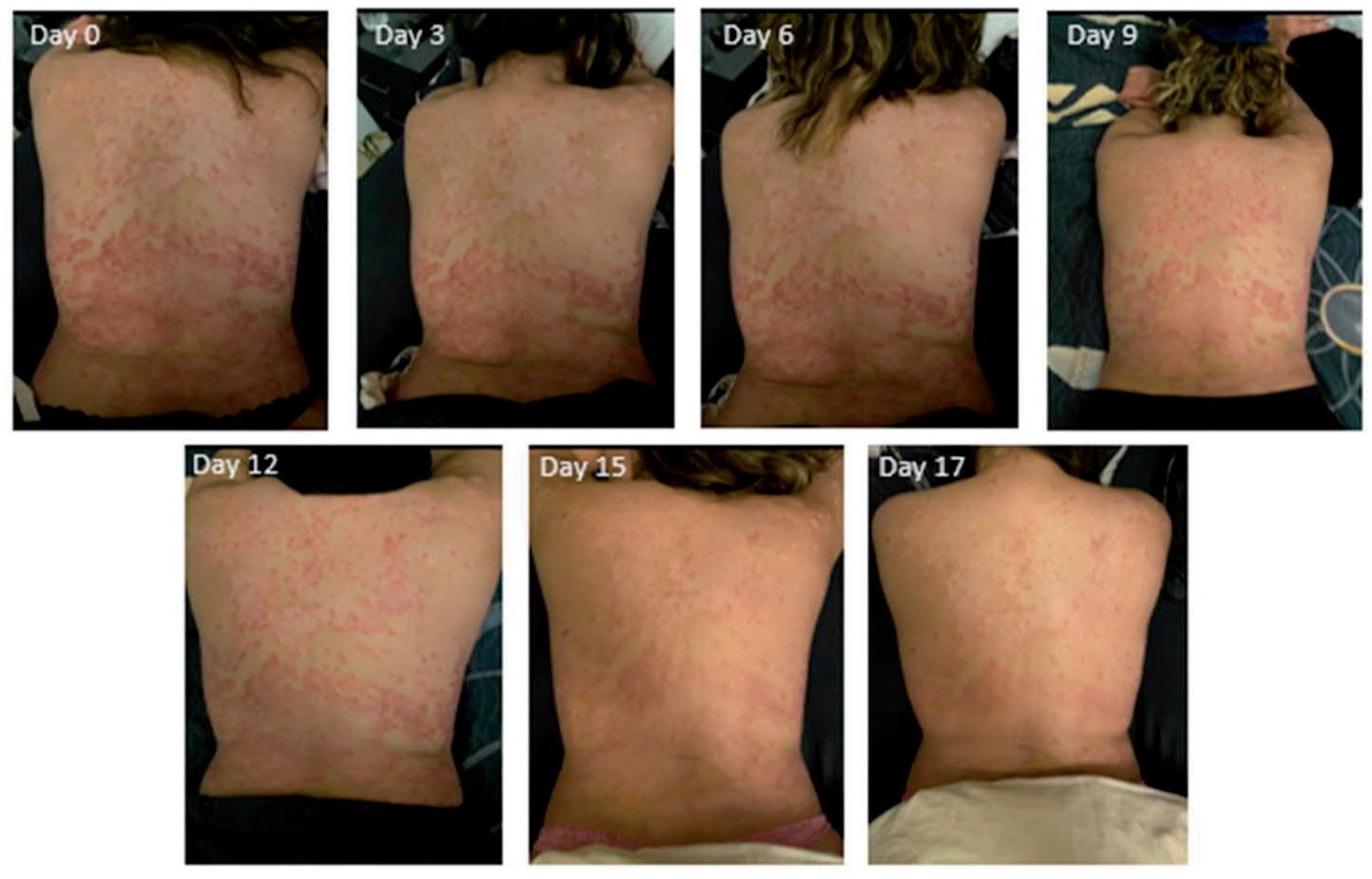
Eczema/dermatitis:

Treatment of eczema/dermatitis (before and after 8 weeks of treatment using Bioptron Quantum Hyperlight therapy for 10 minutes a day).
Skin Aging
Bioptron Quantum Hyperlight has multiple effects that make it a unique device to prevent aging signs, treat skin tone and wrinkles, and maintain a youthful skin. Bioptron Quantum Hyperlight therapy
slows down the natural aging process of the skin, effectively reversing the major signs of skin aging and enhancing the effects of cosmetic products and procedures. Bioptron Quantum Hyperlight therapy is a medically certified device that improves cellular mechanisms and naturally rejuvenates the skin.
Bioptron Quantum Hyperlight therapy:
– Promotes the production of collagen
– Improves skin density
– Decreases fine lines and skin wrinkles
– Increases skin thickness
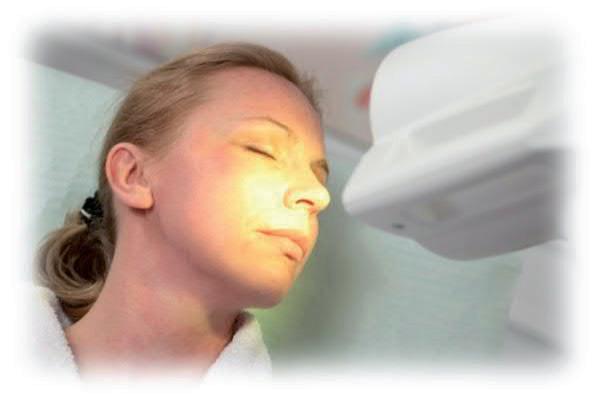
– Ameliorates skin texture, providing firmer and smoother skin
– Restores the natural luminosity of the skin
Effect of Quantum Hyperlight on the biophysical status of human skin
A clinical evaluation study was performed on 32 participants with different skin characteristics (7 males and 25 females, ages 26-63) to evaluate the biophysical skin status and skin modifications under the influence of Bioptron Quantum Hyperlight. In particular, the water status and interaction between water and skin lipids was investigated by means of the OMIS technique. OMIS (opto-magnetic imaging spectroscopy) is a validated skin characterization method based on its interaction with light (Koruga D, 2018). Overall, 4 participants had excellent skin status, 18 very good, another 8 normal (good, average) skin, and 2 participants had poor skin status. It was demonstrated
that under the influence of Quantum Hyperlight, the biophysical skin status is modified. No change was observed in the 4 participants with excellent biophysical skin status. In contrast, a 15% improvement was measured in participants with normal (average) skin, and the positive modification was as high as 50% in participants with poor skin status. Explanations of these observations are grounded in the profound effect that Quantum Hyperlight has on water in the skin, especially on the non-covalent hydrogen bonds. A study on a much larger number of participants (1,000) is currently ongoing to confirm these remarkable results.
Bioptron Quantum Hyperlight therapy can be used as a part of daily anti-aging skin care routines in combination with other creams and serums. In addition, Bioptron Quantum Hyperlight is a powerful tool when combined with other medical anti-aging treatments, decreasing rashes and redness at injections sites, avoiding inflammation, and also potentiating long-lasting effects of the following techniques:
• Facial and hair micro-needling
– Mesotherapy / bio-revitalization
– Hyaluronic acid (HA) fillers
– Botox
– Collagen injections
– Platelet-rich plasma (PRP) therapy
– Mesothreads
– Derma rollers
– Different kinds of skin peeling
• Facial rejuvenation, body treatments
– Fractional CO2 laser
– Endovenous laser ablation (EVLA)
– ND: YAG laser
– Cellulite treatment
Mesotherapy:
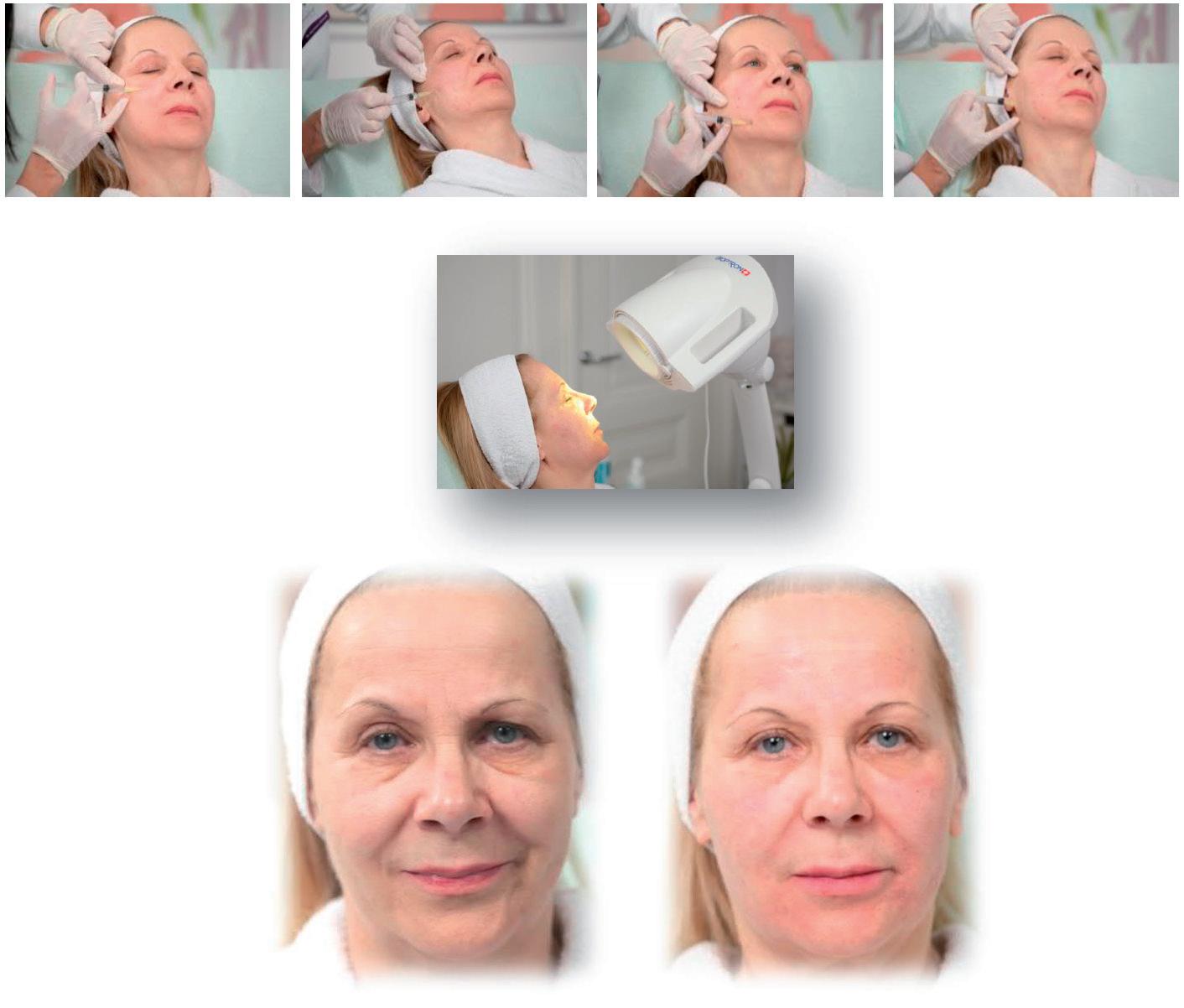
Bioptron Quantum Hyperlight therapy after mesotherapy for 10 minutes before (left) and after (right).
Bioptron Quantum Hyperlight therapy has also been reported to have a high efficacy for post-surgery aesthetic procedures, including after face-lifts, blepharoplasty, and ancillary facial procedures.
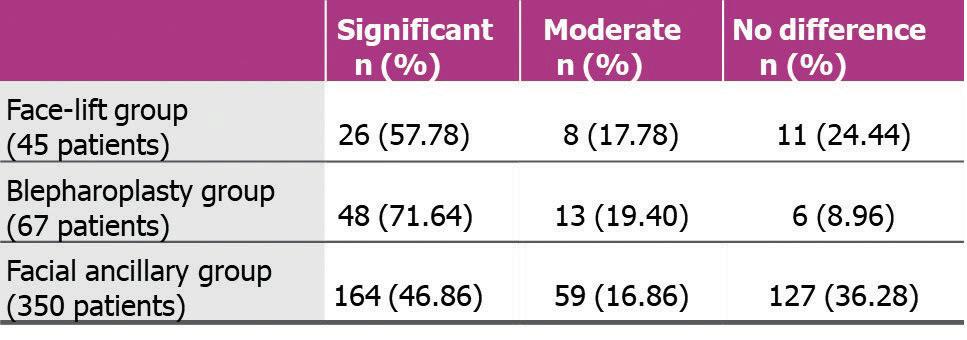
It was demonstrated that Quantum Hyperlight decreases edema and inflammation and provides pain relief throughout the entire healing process, speeding up the time it takes for swelling and bruising to subside (Colic et al., 2004).
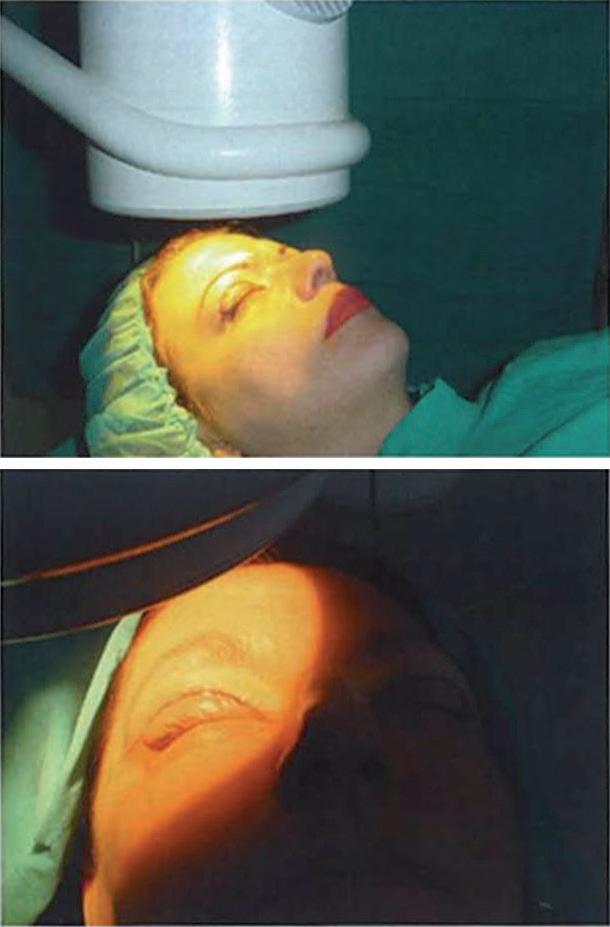
A blepharoplasty patient undergoing Bioptron Quantum Hyperlight treatment on her right eye.
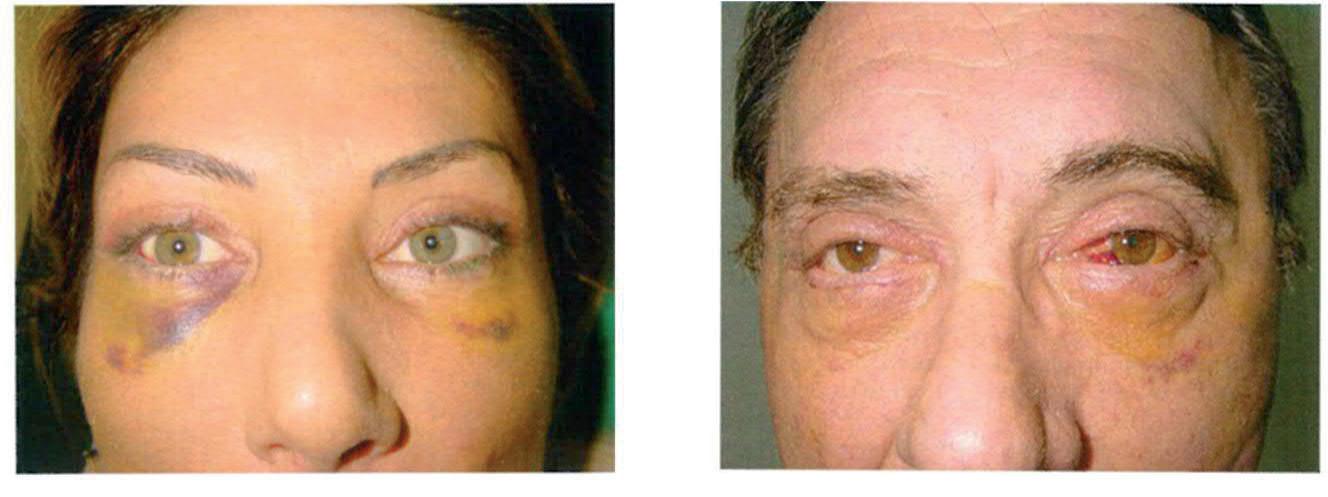
Patients displaying visual signs of hematoma and oedema following blepharoplasty. The woman’s left eye and the man’s right eye were treated daily with Quantum Hyperlight for 10 minutes. Left: 5 days post-surgery. Right: 7 days post-surgery.
Seasonal Affective Disorder
Seasonal affective disorder, often abbreviated as SAD, is a type of depression that typically occurs during the fall and winter months when daylight hours are shorter. It is thought to be related to reduced sunlight exposure and can lead to symptoms such as low energy, mood swings, and oversleeping. SAD shares many characteristics with major depression, such as persistent sadness, loss of interest in activities, and feelings of hopelessness. Typically, during the fall, people feel sad or unlike their usual selves. Their mood changes, they lose interest in activities they used to enjoy, and suffer from low energy. In addition, they feel agitated, experience trouble sleeping, with many feeling the strong desire to oversleep, even during the day. SAD, also known as “winter depression,” can affect how a person feels, thinks, and handles their daily activities. Another common symptom of SAD is an intense craving for carbohydrates and subsequent weight gain. SAD is therefore a serious health issue that causes people to prefer solitude and withdraw from social activities, which can exacerbate feelings of isolation and sadness (Melrose S, 2015).
SAD is thought to be caused by a combination of several factors, with the primary culprits being:
– Biological clock and circadian rhythm: Reduced exposure to natural sunlight during the shorter days of fall and winter can disrupt the body’s internal clock and circadian rhythm. This disruption can affect the production of certain hormones, such as melatonin and serotonin, which play a role in mood regulation and sleep patterns.
– Serotonin levels: Serotonin, a neurotransmitter that contributes to feelings of well-being and happiness, can decrease in the brain during the darker months. Lower serotonin levels
are associated with depression, and this may be a contributing factor in SAD.
– Melatonin levels: The increase in darkness during fall and winter can lead to the overproduction of melatonin, a hormone that regulates sleep. Elevated melatonin levels can cause drowsiness and contribute to the lethargy experienced by individuals with SAD.
– Genetic factors: There may be a genetic predisposition to SAD, as it tends to run in families. Individuals with a family history of mood disorders might be at higher risk.
– Environmental factors: Geographic location plays a role, as SAD is more common in regions with long, dark winters and less natural sunlight. The farther one is from the equator, the higher the prevalence of SAD.
It’s important to note that these factors can vary from person to person, and not everyone exposed to reduced sunlight will develop SAD. The exact cause and mechanisms behind SAD are still a subject of ongoing research.
The main treatment for SAD is bright light therapy, such as Bioptron Quantum Hyperlight therapy. The increased light levels compensate for the decrease in exposure to sunlight, helping to alleviate patients’ depressive symptoms, increase motivation levels, and improve their sleep duration. Light therapy helps regulate the body’s internal clock (circadian rhythms) and can improve mood and alleviate depressive symptoms associated with SAD. The scientific community accepts that SAD is caused by the lack of light. This decrease in light exposure causes an imbalance in the secretion of specific neurotransmitters in the brain such as serotonin and melatonin, which affects the sleepwake cycle and other mechanisms.
It is proven that light therapy using over 10,000 lux during the morning hours can be an effective method for treating SAD (Patronen et al., 2000; Tsai et al., 2004; Golden et al., 2005; Campbell et al., 2019).
Bioptron Quantum Hyperlight therapy devices provide more than 10,000 lux (indoor light measures approx. 500 lux; midday summer sunlight can reach 50,000 lux), the ideal dosage for treating SAD. The recommended approach is to use Bioptron Quantum Hyperlight therapy in the morning, soon after waking up, to help reset the body’s internal clock and improve energy levels and mood. Quantum Hyperlight therapy specialists also recommend directing the light emitted by the device toward the forehead while eating breakfast, reading the news, or working on your computer. A typical light therapy session lasts around 20 to 30 minutes, although the exact duration can vary depending on the individual’s needs and the device being used. The Bioptron Quantum Hyperlight light source should typically be placed around 20-40 centimeters away from the face, allowing for the light to enter the eyes indirectly, without looking directly at the light source. The recommended exposure times are:
• 20-40 minutes at 20-cm distance
• 40-60 minutes at 30-cm distance
• 60-120 minutes at 40-cm distance
Bioptron Quantum Hyperlight therapy is safe and easy to use for everyone of all ages suffering from SAD, including children and adolescents. Because Bioptron Quantum Hyperlight therapy has no side effects, users can discontinue their Quantum Hyperlight treatment during spring and summer with no repercussions.
The Use of Bioptron Quantum Hyperlight Therapy for Treating Other Forms of Depression
A recently published review paper endorsed the use of bright light therapy for the treatment of difficult-to-treat depression (Moeller et al., 2022), indicating that the treatment should be used in the mornings on a daily basis for at least 2 weeks, in sessions lasting 30-60 minutes. The findings of another clinical study performed in women with treatmentresistant depression (TRD) further support this recommendation (Rajacic et al., 2023). It has also been previously reported that bright light therapy has a positive effect on other non-seasonal depressions, such as depression, anxiety, and trauma-related disorders during the perinatal period (Nillni et al., 2018). Finally, ongoing research is showing that the combination of Bioptron Quantum Hyperlight therapy with wearing Quantum Hyperlight Optics (fully explained in Chapter 9) also resulted in mood improvement in healthy volunteers (Filipovic et al., 2023).
Application of Quantum Hyperlight in Children and Newborns
Few medical devices are designed and marketed specifically to be used in pediatrics and neonatology. Children and newborns have special needs and require appropriate healthcare. Bioptron Quantum Hyperlight therapy is a safe, medically certified device that can be used in children and newborns to relieve pain and promote healing. Bioptron Quantum Hyperlight therapy is especially useful for treating pediatric dermal afflictions, endogenous eczema, upper respiratory tract infections, allergic respiratory diseases, and pediatric musculoskeletal disorders. Dermal problems occurring in newborns such as phlebitis, decubitus, and intertrigo can also be treated safely. However, it is recommended that the use of Quantum Hyperlight in children under 6 years be performed strictly under the supervision of a physician. In addition, when using Quantum Hyperlight on
the face, a blindfold (included with the purchase of the Bioptron device) should be used. The recommended treatment time is 2-6 minutes once or twice per day at a distance of 10 cm, for as long as is needed.
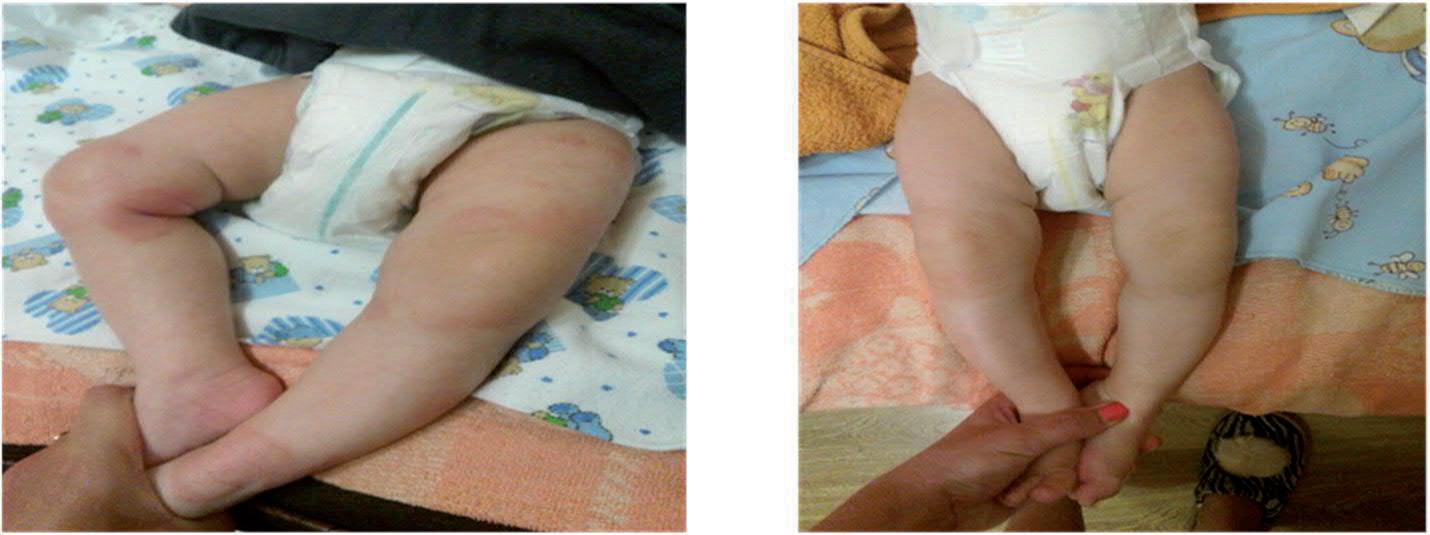
A 2-month-old pediatric patient with atopic dermatitis was successfully treated with Bioptron Quantum Hyperlight for 2 weeks (left: before; right: after).
A young girl diagnosed with Down syndrome and autism sustained several burn injuries after placing her hand on an electric hot plate. Bioptron Quantum Hyperlight was applied directly to the hand for 2 weeks. During the first week, sessions of 10 minutes twice or three times per day were performed, and daily sessions of 10 minutes were performed during the second week. Note the fast recovery of the burn wound over time (images b to g).
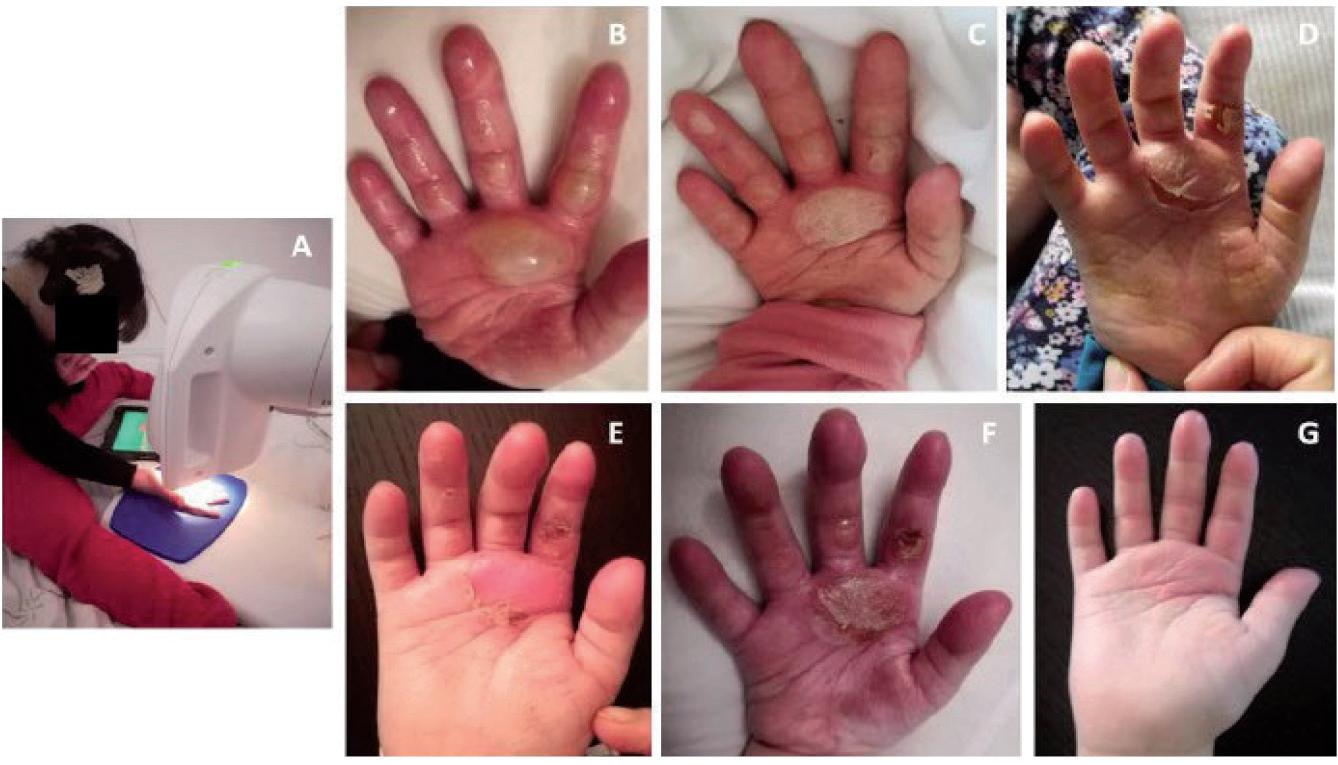
Individual Case Studies and Testimonials
Aside from more than 50 clinical studies that were performed with Bioptron Quantum Hyperlight, many individual case studies and testimonials have demonstrated its efficacy. (Koruga D, 2018).
1. Bioptron Quantum Hyperlight Applied in the Treatment of Burns
1.1. Cosmetic Wax Burn
Case description: A 52-year-old female burned her thumb with hot wax, leaving a 2nd degree burn of 2 cm long and 1 cm wide. The injury was accompanied with intense pain and the hand region with decreased mobility.
Protocol: Bioptron Quantum Hyperlight was applied locally on the burn site once a day for 8 minutes treatment for 7 days consecutively.
Healing observations: After the first application, the pain was relieved and motility improved. On the 3rd day of therapy, the edema around the wound receded. The antibacterial properties of Quantum Hyperlight prevented wound infection. After 7 days of treatment, the wound was healed.
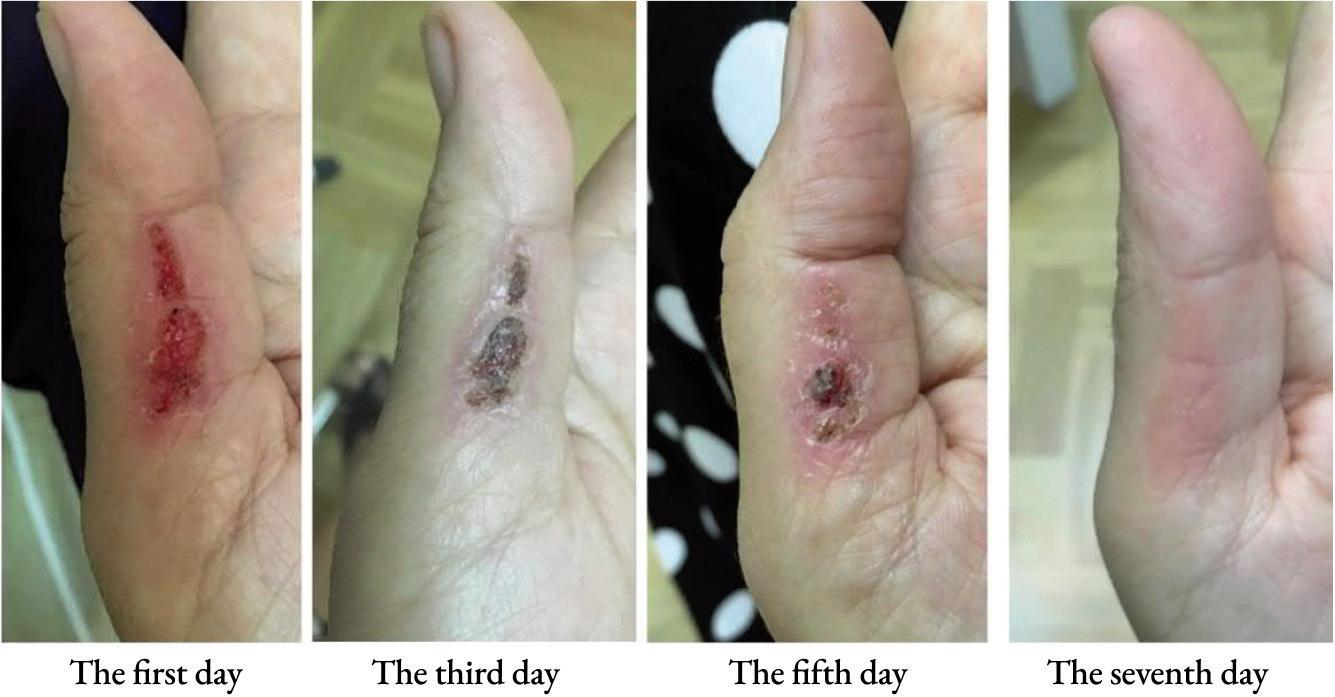
Images: Healing of the wound with Bioptron Quantum Hyperlight at days 1, 3, 5, and 7.
1.2. Boiling Water Burn
Case description: A 53-year-old female accidently burned her arm on the front femur region with boiling water. The next day a large blister appeared that burst open, with mild hemorrhage and intense pain leaving a 2 cm × 1 cm 2nd degree burn.
Protocol: Daily Quantum Hyperlight treatment of burn wound was started 5 days after burn injury for 28 days.
Healing observations: After the 3rd treatment, the pain reduced significantly. After 10 treatments, noticeable closing of the wound edge was registered. Significant decrease of lesion depth with reduced hyperemia as observed after the 15th Quantum Hyperlight treatment. The wound was completely closed after 28 treatments.

Images: Before treatment and after the second and 10th treatment.
2. Bioptron Quantum Hyperlight Applied in the Treatment of Psoriasis
Case description: This 32-year-old male has been suffering from psoriasis vulgaris on his legs for 6 years. He was treated both locally and systemically without any notable effect.
Protocol: Bioptron Quantum Hyperlight therapy was performed on both legs for 8 minutes at a distance of 7-10 cm for 5 days a week for 10 weeks (50 treatments in total).
Healing observations: During the first 2 weeks, initial inflammation occurred with exacerbation. Afterward, skin redness receded and skin changes improved. The initial inflammatory reaction receded after the 3rd week. After 2 months of therapy, significant improvements were observed in psoriatic changes on the skin of the lower legs. After the 50th Quantum Hyperlight treatment, the skin changes had almost completed receded, the redness had subsided, and the skin was no longer dry and cracked.
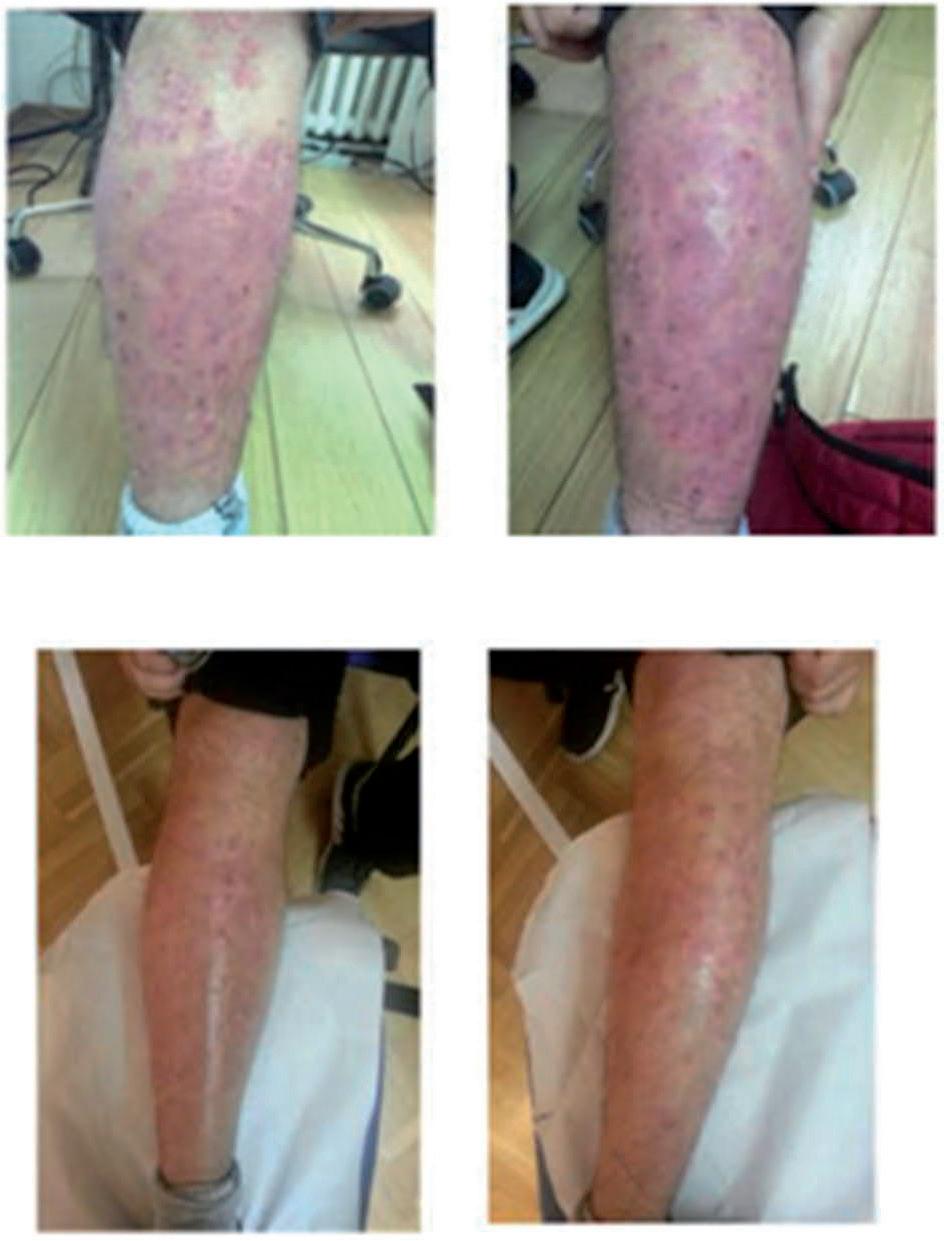
Images: Before and after 50 treatments with Quantum Hyperlight.
3. Bioptron Quantum Hyperlight Applied in the Treatment of Acne
Case description: A 21-year-old female was diagnosed with acne vulgaris on both cheeks, lasting for 4 years.
Protocol: Bioptron Quantum Hyperlight treatment was performed on both cheeks for 8 minutes at a distance of 5 cm for 30 days. A total of 15 treatments were performed, with one every second day.
Healing observations: At the beginning of the treatment, the patient’s skin was glossy, with pronounced pustules forming acne on both cheeks. The patient described occasional stinging and pruritus of her skin and dissatisfaction with her aesthetic appearance. Quantum Hyperlight therapy initially led exacerbated inflammation, which was then followed by a gradual reduction in inflammation and a decline in the number of papules and pustules on her skin. After 15 treatments, skin appearance improved significantly, with only a small number of papules. The patient described the treatment as very agreeable. Stinging and itching of the skin were alleviated, and she was very satisfied with the aesthetic appearance of her skin.
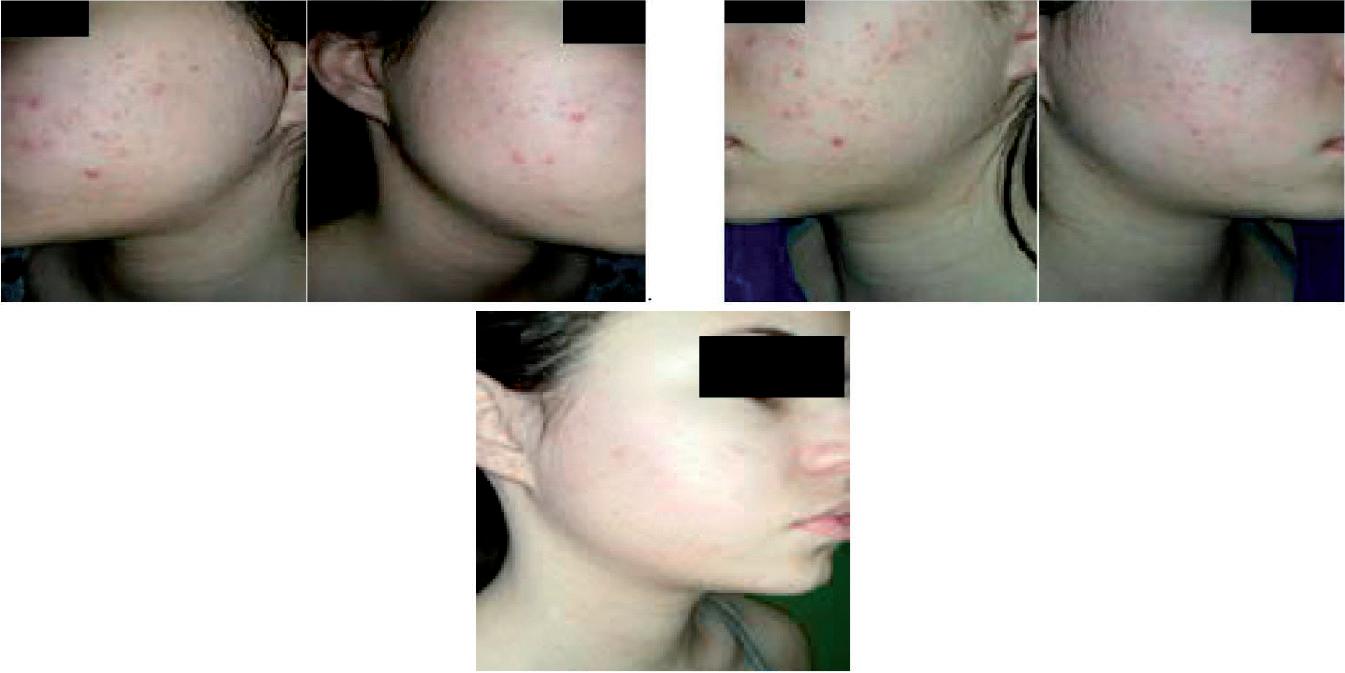
Images: Quantum Hyperlight treatment at day 1 (left), 5 (middle), and 15 (below).
4. Bioptron Quantum Hyperlight Applied in the
Treatment of Asthma
Case description: This case concerned a 78-year-old female patient, who had been suffering from non-allergic bronchial asthma for 5 years. Her treatment consisted of inhaled corticosteroids, inhibitors of leukotriene receptors and beta-2 adrenoreceptors.
Protocol: Bioptron Quantum Hyperlight was applied daily on the chest (sternum region) at a distance of 7 cm for 8 minutes for 19 consecutive days.
Healing observations: Before treatment, the patient experienced difficulty in breathing when on longer walks or when walking up hills or stairs. During the first 2 weeks, the patient’s general illness status improved remarkably. She experienced issues, such as difficulty breathing in the mornings, dyspnea, and coughing, during the first 9 days of treatment. From the 10th to the 19th treatment, however, these issues had subsided completely. In addition, a check-up examination for her condition, conducted by her treating pneumologist on the 11th day of Quantum Hyperlight therapy, showed significantly better results in the diagnostic spirometry test compared to the previous test performed 6 months prior.
5. Bioptron Quantum Hyperlight Applied in the Treatment of Spondylolisthesis LS-S1
Case description: Patient is a 26-year-old female suffering from lumber spine spondylolisthesis grade II for 4 years (spondylolisthesis is a pathology where one vertebra is displayed over another, inducing pain the lower back). She was regularly undergoing standard physical therapy.
Protocol: Application of Bioptron Quantum Hyperlight was performed as 8-minute daily treatments at a distance of 5-7 cm in the lumber spine area for 10 days consecutively.
Healing observations: Before the onset of treatment, a nagging pain in the lumbar region, morning stiffness, and strain after prolonged sitting was observed. During the 5 first treatments with Quantum Hyperlight, a gradual improvement was noticed in the lumbar pain with less stiffness in the morning. After the 7th treatment, pain was almost gone with minimum stiffness upon awakening. However, prolonged sitting was still problematic. After 10 treatments, pain was still reduced and a maximum improvement of morning stiffness was noticed. However, strain remained after prolonged periods of sitting.
6. Bioptron Quantum Hyperlight Applied in the Treatment of Lumbar Painful Syndrome (Lower Back Pain)
Case description: A 76-year-old female patient who is suffering from back pain for 5 years, with sudden exacerbation in the last 6 months, experiencing severe pain in the lumbar region, especially in the morning, with no pain propagation along the leg, but mild lateralization toward the left hip.
Protocol: Bioptron Quantum Hyperlight therapy was started on the painful region at 2 locations of the lumbar spine and also laterally left of the spinal column, with daily 8-minutes treatments at a distance of 7 cm for 10 days, and continued later for another 11 days.
Healing observations: After the 1st week of Quantum Hyperlight therapy, the patient experienced a feeling of improvement. She did not need to take pain medication that she had used previously. Considerable improvements after the 2nd week: Pain relief and easier to move around.
During the second week, some pain was still observed by the patient, especially in the morning, but certainly no more than experienced before the onset of Quantum Hyperlight therapy. Over the next 2 weeks, the patient was treated with Quantum Hyperlight in combination with physical therapy. During the 3rd week, she felt significant improvements, especially with getting out of bed. Her treating doctor testified that the patient finds it much easier to get up out of the chair in a smooth movement. After 4 weeks of therapy, the patient stated the pain had been alleviated, with no more pain-related lateralization toward her left hip.
7. Bioptron Quantum Hyperlight Applied in the Treatment of Chronic Venous Insufficiency (CVI)
Case description: A 62-year-old male patient, suffering from CVI for 5 years with skin edema, pain, redness, and thinned and dry skin of the leg (CVI is a medical condition that occurs when the veins in the legs are unable to return blood to the heart effectively. This is often the result of damaged or weakened vein valves, causing blood to pool in the legs. Common symptoms of CVI include leg pain, swelling, varicose veins, and skin changes).
Protocol: Application of Bioptron Quantum Hyperlight was performed for 8 minutes daily at the skin lesion site at a distance of 7 cm, for 20 days.
Healing observations: Before starting Quantum Hyperlight therapy, the patient had not received any treatment using medication. Patient experienced fatigue, heavy legs, pain, edema, redness, skin changes with a blue-green network of dilated capillaries and veins. At the beginning of the treatment, the patient felt slight pain and heaviness in his leg. After 10 days treatment with Quantum Hyperlight, a clear reduction of edema and inflammation was observed. After 20 days, a
gradually continued reduction of all symptoms occurred. At the end of the treatment, no itching or skin pain was felt, and all symptoms were almost completely reduced.
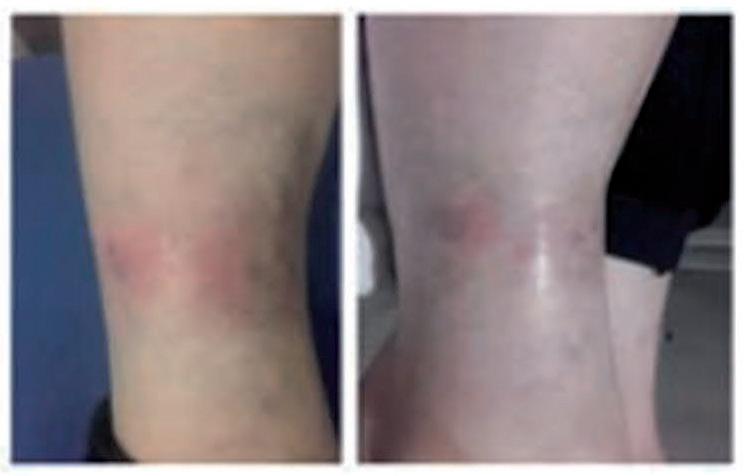
Images before (left) and after 20 days treatment with Quantum Hyperlight (right).
8, Bioptron Quantum Hyperlight Applied in the Treatment of Nipple Pain
Case description: A 29-year-old woman who was suffering from enlarged breasts with intense nipple pain 4 weeks after giving birth. She was not able to breastfeed or use a pump to retrieve breastmilk, her nipples were showing fissures and bleeding.
Protocol: Quantum Hyperlight therapy was performed 10 minutes per day for only 2 days.
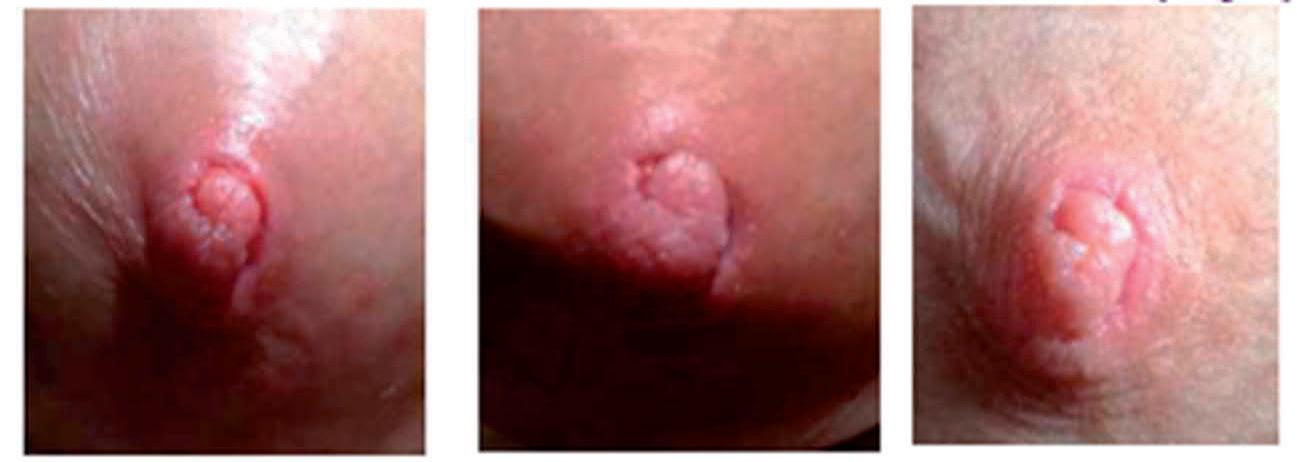
Images: Before (left), after 1 day (middle), and 2 days (right) treatment with Quantum Hyperlight.
9. Additional Case Study Testimonials
More than 50 additional testimonials of people that have successfully used Quantum Hyperlight for treating a variety of health issues can be found here:

https://www.bioptron.com/references/testitnonials/?page=1&fp=1
These “spontaneous” testimonials of users of Quantum Hyperlight cover the following topics: COVID-19 infection, skin aging, chronic fatigue syndrome, post-surgery wound healing, back pain, muscle cramps, prostate problems, varicose veins treatment, respiratory allergy, baldness, gum infection, jaw pain, lump in knee, bruises healing, vertebra cracks and degeneration, lower back pain, rib pain, diabetic foot ulcers (with images), necrotic ulcer of the thumb (with images), skin transplant healing (with images), wound healing after unsuccessful phlebectomy (with images), dog bite, knee injury, eye redness and pain, blocked ears, swollen ankle, post-surgery swelling, bedsores (with images), lip burn (with images), dental implant inflammation, periodontal disease, severe acne, pink eye, sinusitis, toothache, headaches, sprained ankles, arthritis, lupus, burn-out, keloid, vitiligo, post-surgery scars, acne, atopic dermatitis (with images), herpes eruption on lips, stretchmarks in pregnant women, yeast infection, Cesarean section, cracked nipples, alopecia, baldness, sinus congestion, chronic lower spine pain, tendon inflammation, burn of hand, child with eye wound (with images), enlarged tonsils, abdominal pain, common cold, groin
and hamstring injury, cycling pain, psoriasis-like skin, pelvic pain, bruised rib, muscle spasm, sports injury (with images), injured horse with ring bone, horse leg wound healing (with images).
Bioptron Quantum Hyperlight Light Therapy in Oral Care
Bioptron Quantum Hyperlight therapy has also been evaluated for its efficacy in oral care and dentistry. In a first clinical study, the effectiveness of Quantum Hyperlight was demonstrated as an additional treatment to non-surgical periodontology therapy in patients suffering from periodontitis. Gingival inflammation, number of plaques, bleeding and depth on grooves between gums and teeth were measured after 1 and 3 months of treatment. After 1 month of treatment, inflammation of the gums significantly improved, and a continued improvement of the bleeding and the gingival inflammation were observed in the group treated with Quantum Hyperlight after 3 months (Nardi et al., 2019).
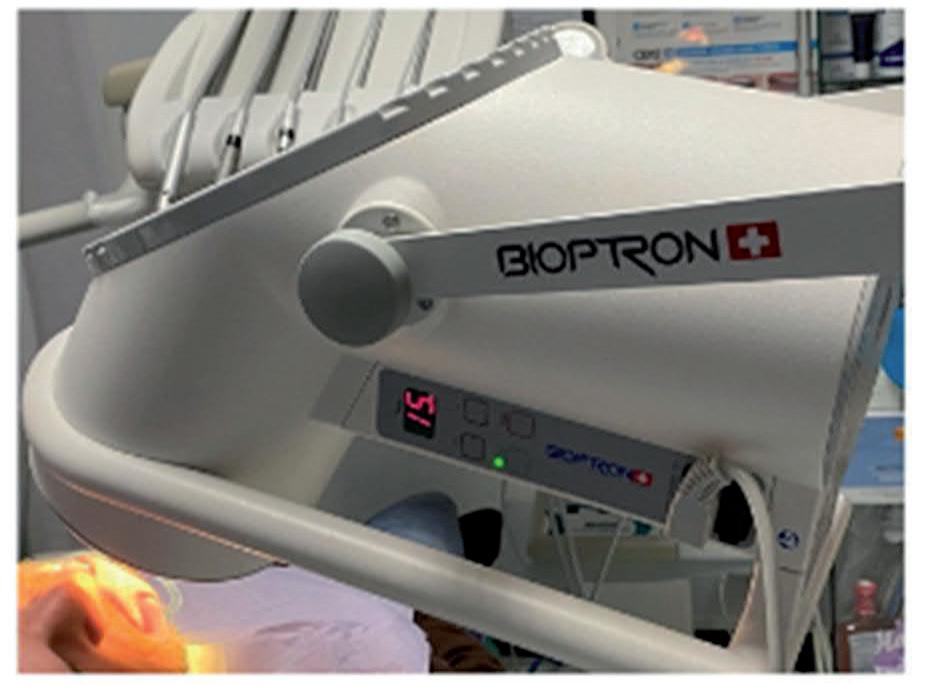
Image: A periodontal patient being treated with Bioptron Quantum Hyperlight.
Case study of an 18-year-old man badly wounded in the face after a car accident (left) and treated from the second day after trauma with Bioptron Quantum Hyperlight for 15 minutes daily. Results are shown after 1 month (right, A), 2 months (B), and 3 months (C). It was observed that scar tissue healed completely after 24 Quantum Hyperlight treatments (Nardi et al., 2021).
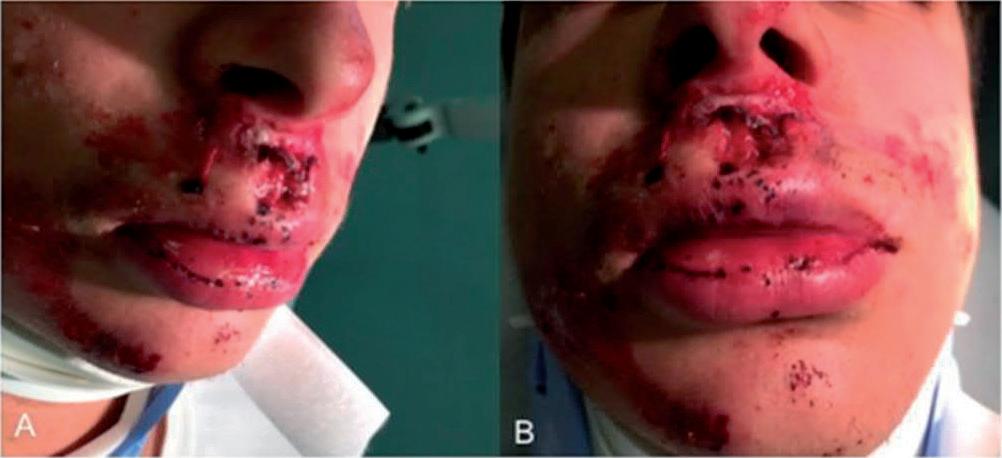
Extraoral facial images immediately after trauma: (A) extraoral lateral view; (B) extraoral frontal view
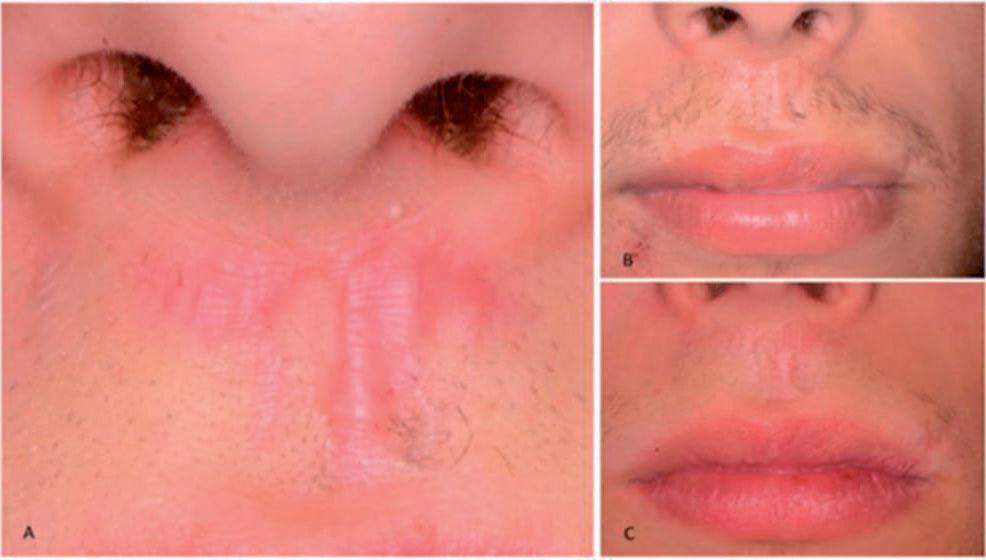
Extraoral view of soft tissue healing 1 month (A), two months (B) and 3 months (C) of Quantum Hyperlight treatment.
Another clinical study confirmed the efficacy of Quantum Hyperlight treatment in a group of patients suffering from pathologies of the oral cavity, in particular pain in the jaw muscle, joint and nerves around that area. A statistically significant reduction in pain and muscular spams,
improvements in function, increases in muscular strength, and a decrease of joint pain was observed. Other patients suffering from COMP (chronic oral mucosal pain) show a faster significant pain level decrease and tissue healing (significant reduction of inflammation and tissue swelling) compared to non-treated patients (Petruzzi et al., 2019).
Bioptron Quantum Hyperlight Light Therapy and Covid-19
COVID-19 is primarily a respiratory illness caused by the SARSCoV-2 virus, and its management typically involves supportive care, antiviral medications, and vaccination. Since the outbreak began in early 2020, SARS-CoV-2 has proven full of surprises. Initially regarded as respiratory virus, it can affect other organ systems and can linger in the body for months. The latest research unveils that people infected with the coronavirus may be left with permanent lung damage and people with compromised immune system are at the greatest risk. In June 2020, the Russian Ministry of Health included Bioptron Quantum Hyperlight Light therapy in its recommendations on fighting the worldwide viral infection rates and on improving the lung discharge in patients with moderate and mild severity due to the anti- inflammatory effects (Ministry of Healthcare of Russia, 2020). The Ministry recommends the use of Bioptron Quantum Hyperlight therapy on daily basis as per the following protocol:
– On the middle of the sternum (breastbone) for 4 minutes.
– On the area where the lung is inflamed (more often on back and side of the chest) for 6 minutes.
– On the solar plexus (between breastbone and belly button) for 4 minutes.
– Interscapular region (between the shoulder plates) for 1-6 minutes.
– Paravertebral region (next to the spinal cord) for 6 minutes.
A recently published study suggests that Bioptron Quantum Hyperlight modifies DNA expression in specific immune cells, implying that Bioptron has the capacity for immunomodulation in human immune cells and thus exerting an anti-inflammatory effect (Feehan et al., 2019).
Bioptron Quantum Hyperlight Light Therapy in Veterinary Care
Bioptron Quantum Hyperlight has also shown to be a very promising effective therapy for treating a variety of health issues in animals. Treatment is very well tolerated and accepted and can be combined with any other treatment, whereby its synergetic effects can be observed. For the comfort and health of the animals, Bioptron Quantum Hyperlight therapy can be applied directly on the skin, with no shaving of the area required before treatment.
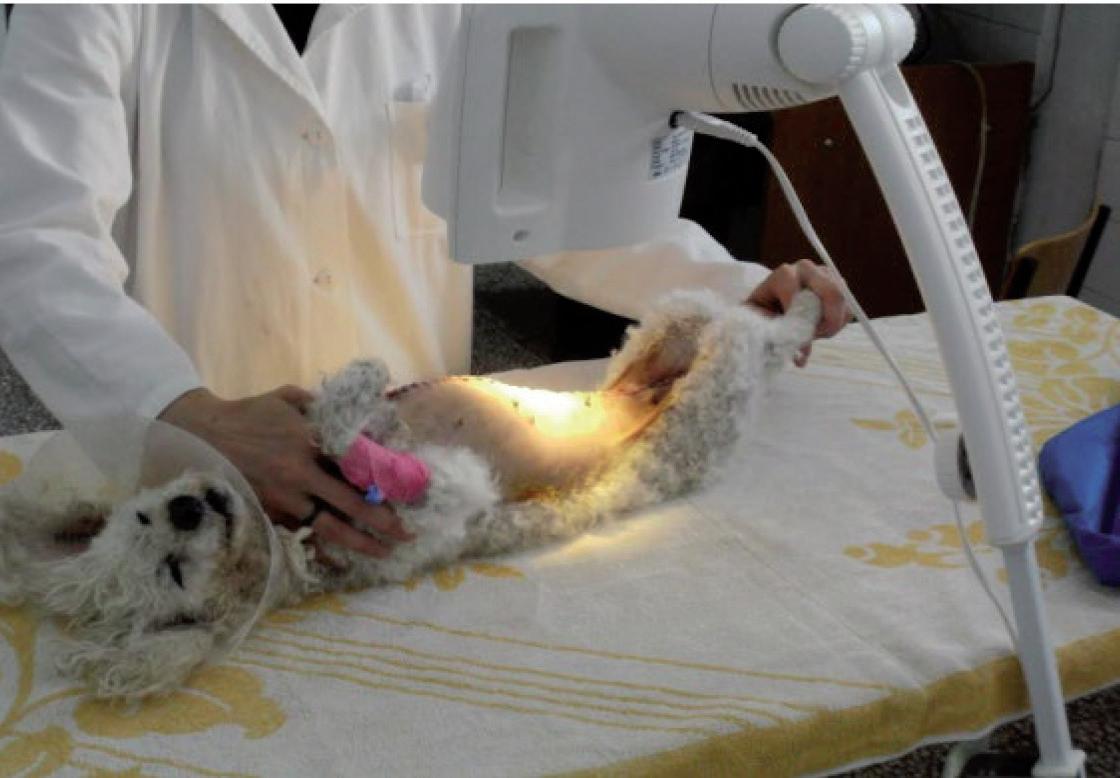
A dog being treated with Bioptron Quantum Hyperlight.
Successful Bioptron Quantum Hyperlight therapy outcomes have been reported for the following veterinary conditions: Skin problems (e.g., trichophytia, alopecia, bacterial and allergic dermatitis, demodicosis), allergies, eczema, arthritis, pain, problems with cramping syndrome, inflammatory disorders (e.g., otitis externa, mastitis, etc.), acute inflammation after surgery and injuries, wound healing after surgery and injuries, saddle sores in horses, diseases of muscles (eosinophilic myositis), and cat flu.
Wound Healing in Horses
The images below are of a two-year-old horse whose leg got stuck in his box. Upon freeing the leg, a horrific, large wound could be seen, which needed immediate surgery before being bandaged.
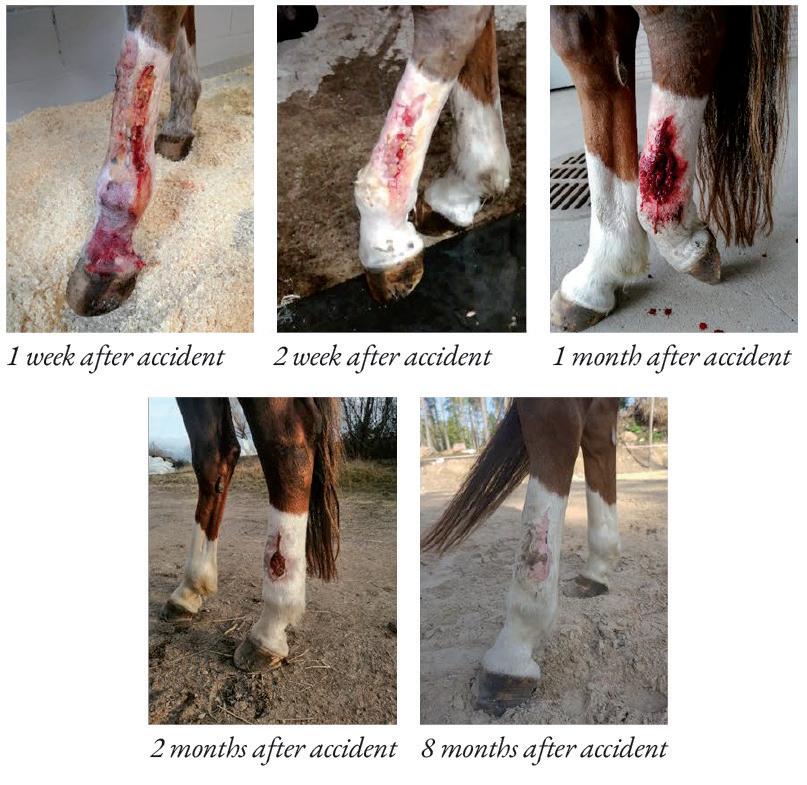
Quantum Hyperlight therapy started 1 week after the accident. During the first month, the leg was treated twice daily for 10 minutes. The next 3 months only once per day. All subsequent treatments were performed every 3rd day for 10 minutes. The course of treatment
ended 8 months later with excellent results. By the way, the horse is once again competing at dressage competitions!
Eczema in Cats
This cat received 10 Bioptron Quantum Hyperlight sessions for 10 minutes once a day in the nose area to treat eczema. Positive effects were visible from the first treatment, and full healing was achieved within 10 days.
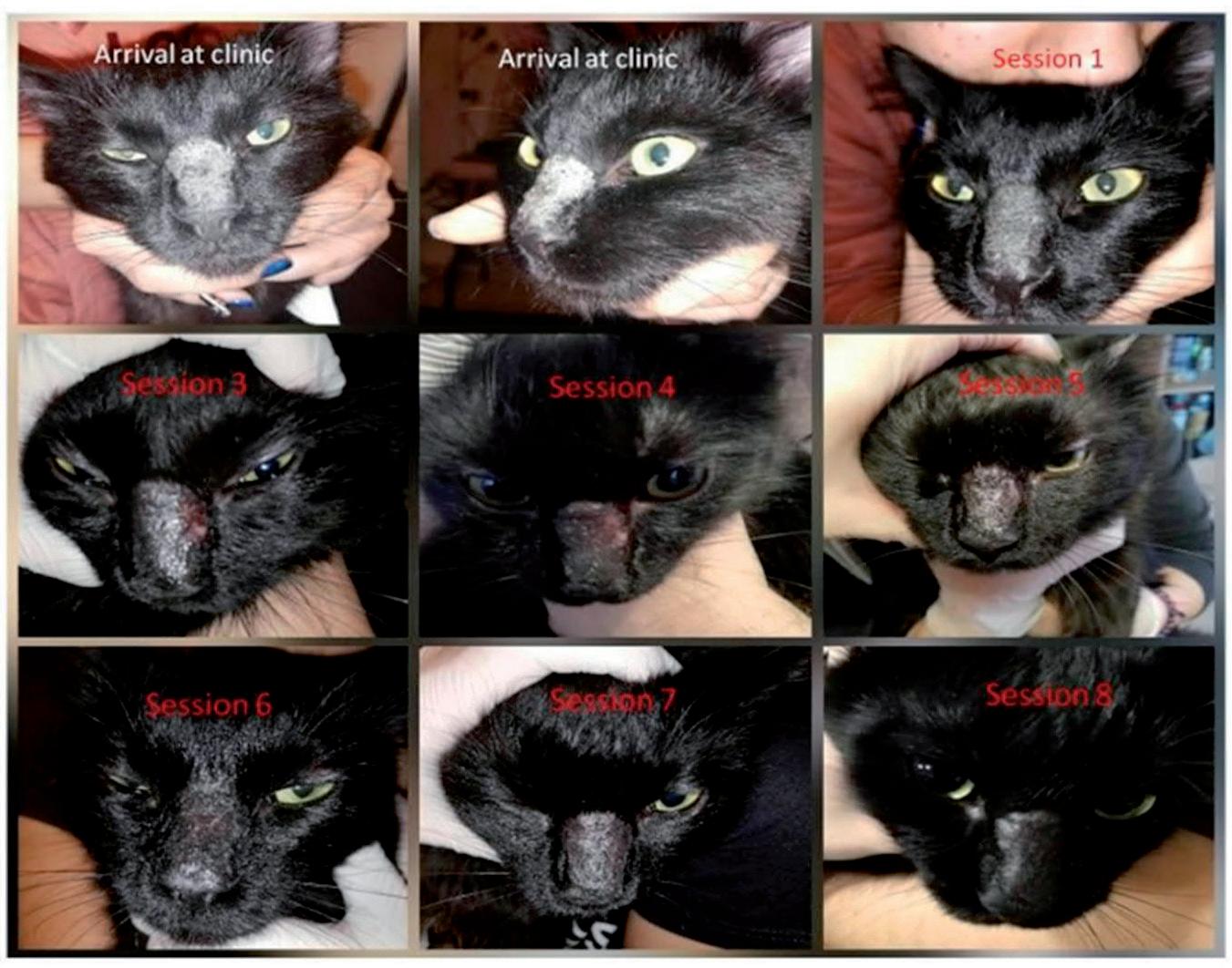
Mastitis in Cattle
Subclinical mastitis in high-yielding dairy cows poses a significant threat, often going unnoticed with no visible symptoms. Despite the lack of obvious signs, it impairs milk quality and production in the cows.
Elevated somatic cell counts indicate subclinical mastitis, necessitating regular testing. This condition compromises milk hygiene and increases pathogen transmission risk. Bioptron Quantum Hyperlight treatment of the udders of cows diagnosed with subclinical mastitis for 3 days (8 minutes per day at a distance of 10 cm) achieved full recovery and eliminated the need for antimicrobial therapy (Radojicic et al., 2020).
Zoo Animals
Bioptron Quantum Hyperlight therapy is also used to treat large zoo animals. Take a look at this video where an elephant was treated for pain and inflammation in his foot at a zoo in New Zealand:

https://www.youtube.com/watch ?v= BxsAZL8W vj s&t= 103 s&ab channel= BrilinFunctionalMedicineCentre
CHAPTER 9: Quantum Hyperlight Optics to Improve Brain Function
Light Pollution: Health Problems Caused by Harmful Light
Our eyes are not naturally protected from dangerous harmful radiation caused by artificial indoor lighting and natural sunlight. Excessive exposure irreversibly damages our eyes, causing cataracts and macular degeneration. Moreover, light exposure can also adversely affect our brain function and general physical health.
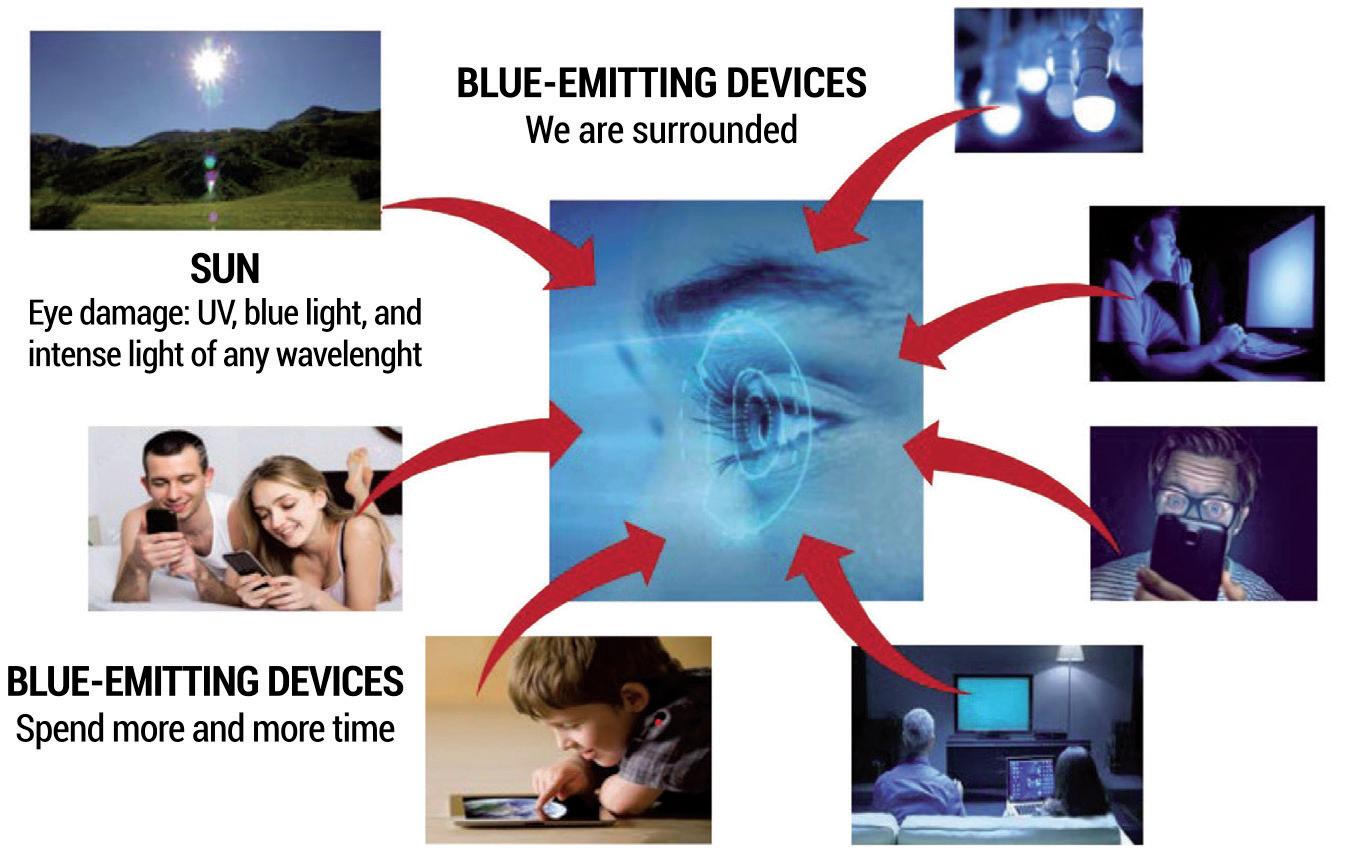
Light pollution sources affecting our general physical health.
Exposure to excessive artificial light at night can disrupt the circadian rhythms of humans, potentially leading to sleep disorders, increased stress, and various health problems. Light pollution, especially blue
light, is also associated with an increased risk of certain diseases, including breast cancer and obesity (Krigel et al., 2016; O’Hagan et al., 2016; Tosini et al., 2016; Zhao et al., 2018).
Blue light is a type of visible light that has a shorter wavelength and higher energy compared to other colors in the visible spectrum. While blue light is naturally emitted by the sun, it is also emitted by many artificial sources, including digital screens (such as those on computers, smartphones, and televisions) and LED lighting. Excessive exposure to blue light has been associated with several potential negative effects on human health:
– Disruption of circadian rhythms: Blue light plays a crucial role in regulating our circadian rhythms, which are our natural sleep-wake cycles. The Nobel Prize in Physiology or Medicine for 2017 was awarded jointly to Jeffrey C. Hall, Michael Rosbash, and Michael W. Young for their pioneering research on circadian rhythms, which are the natural, internal biological clocks that regulate the sleep-wake cycle and various other physiological processes in living organisms (Klarsfeld et al., 2018). Exposure to blue light, particularly in the evening, can interfere with the body’s production of melatonin, a hormone that helps regulate sleep. This disruption can lead to difficulty falling asleep and maintaining a healthy sleep pattern.
– Sleep disturbances: Prolonged exposure to blue light before bedtime can lead to difficulty falling asleep, reduced overall sleep duration, and poor sleep quality. This can contribute to sleep disorders such as insomnia (Sasseville et al., 2009; Sasseville et al., 2010; Shechter et al., 2018; Knufinke et al., 2019; Janku et al., 2020).
– Eye strain and fatigue: Staring at screens for extended periods can cause digital eye strain, also known as computer vision syndrome. Symptoms include dry eyes, blurred vision, headaches, and eye discomfort. Blue light is often implicated in these symptoms (Lin et al., 2017).
– Increased risk of macular degeneration: Some studies suggest that long-term exposure to blue light, particularly from digital devices and artificial lighting, may increase the risk of age-related macular degeneration (AMD). AMD is a leading cause of vision loss in older adults (Margrain et al., 2004; Zhao et al., 2018).
– Potential effects on mood: Limited research has suggested that excessive exposure to blue light, especially at night, might have mood-altering effects and may contribute to symptoms of depression and anxiety (Hester et al., 2021).
– Reduced alertness and cognitive function: Blue light exposure at night can disrupt the body’s natural wakefulness and alertness, potentially leading to reduced cognitive performance and increased daytime drowsiness (Henriksen et al., 2014; Henriksen et al., 2020).
Transformation of Light Through Hyperlight Optics
Hyperlight Optics are special glasses that integrate the fullerene C60 nanophotonic filter into the lenses to produce Quantum Hyperlight. As explained in Chapter 7, fullerene C60 has unique quantum properties, including a rotation twist rate of 18 billion times per second. Any light passing through the Hyperlight Optics (lenses) is transformed into a uniquely structured harmonized light complex (Koruga D, 2018; Koruga D, 2019; Koruga D, 2019).
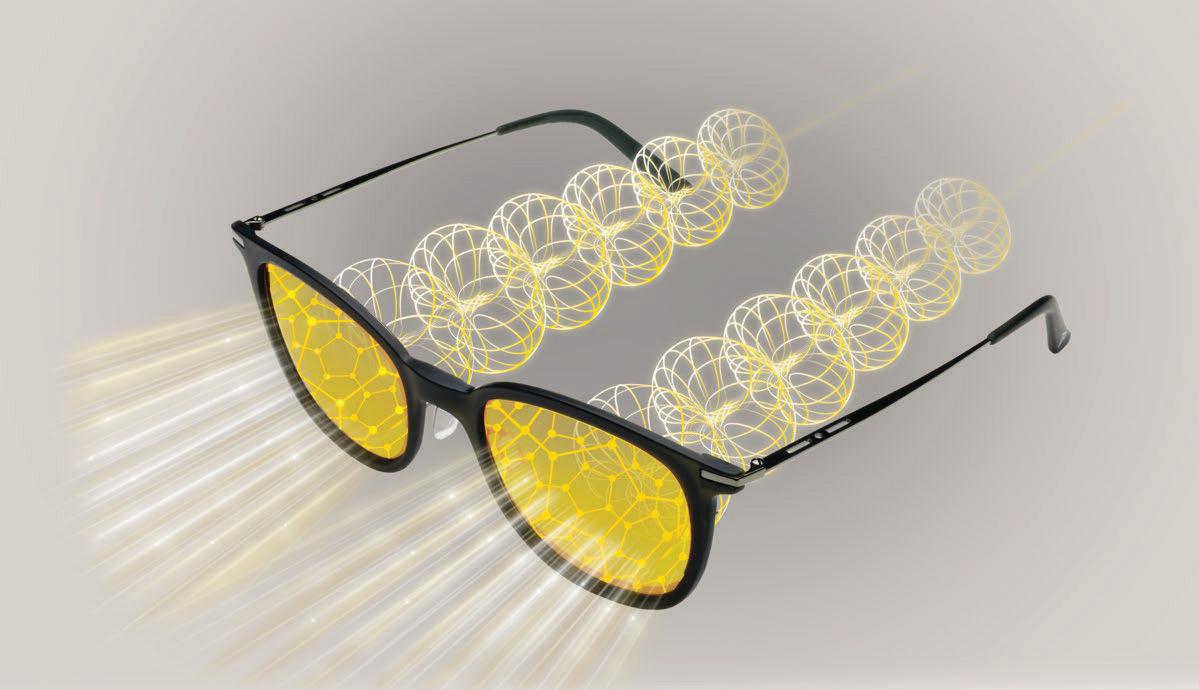
The formation of structured harmonized light by Hyperlight Optics.
Based on the principles of biomimicry, Quantum Hyperlight will ultimately restore biostructures in the eye and brain to a natural healthy state. Wearing these glasses will stimulate optimal functioning of biomolecules in the brain, improving your mental state to enable you to sleep better, see better, perform faster, and feel healthier and happier in general (Jankov et al., 2019; Boljanovic et al., 2021; Stankovic et al., 2020).
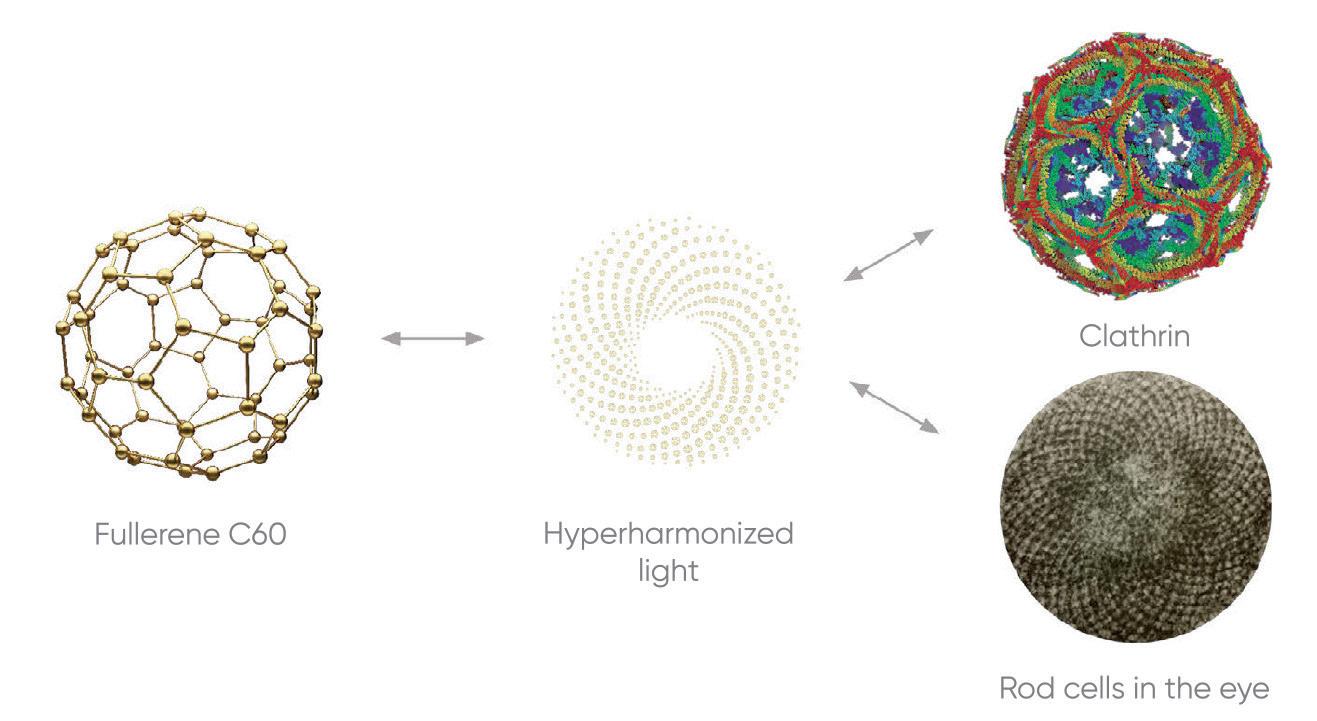
Schematic representation of the biomimicry principles of Hyperlight Optics: Via its quantum properties, fullerene C60 will transform any incoming light into Quantum Hyperlight (hyperharmonized) that will restore biostructures such as clathrin and the rod cells in the eye to an optimal healthy state (Koruga D, 2018).
Hyperlight Optics optimizes the intensity of light to the level that is the most comfortable for the eyes and our brain functions. When the intensity of light exceeds the optimal level, the Hyperlight Optics attenuates it. Conversely, it amplifies light intensity when the light level drops below the optimal level. Light optimization is achieved by transforming harmful UV and high-energy blue light into Quantum Hyperlight. Any light passing through the Hyperlight Optics (lenses) is transformed into a uniquely structured harmonized light complex.
Light transformation of sunlight (top), neon light (middle), and LED light (bottom) by wearing Hyperlight Optics. Note the spectral profile changes after passing through the Hyperlight Optics: The harmful wavelenghts (HW) such as UV and blue light are substantially decreased and restructured into desirable wavelenths (DW) ideal for eye and brain functioning.
Physiological Effects of Wearing Hyperlight Optics
Hyperlight Optics protects against harmful sunlight and artificial light sources and provides active light therapy to revitalize the human body. In particular, daily wearing of Hyperlight Optics improves hormone balance, cognitive abilities, eyesight, and signs of skin aging around the eyes.
–
Hormonal balance: Research studies have demonstrated that Hyperlight Optics optimizes levels of serotonin (happiness hormone), dopamine (pleasure hormone), melatonin (sleep regulation hormone), and cortisol (stress hormone), restoring your physiological balance, boosting self-confidence, improving our mood, and reducing stress, anxiety, depression and irritability (Filipovic et al., 2023; Lataz et al., 2023).
– Cognitive abilities: Other studies have shown that Quantum Hyperlight also has positive effects on brain function and will contribute to improving concentration, attention, and memory, making us more productive and efficient in our decision-making. The beneficial effects of wearing Hyperlight Optics are particularly recommended in periods of intense stress and prolonged mental stress (Gulyar et al., 2019).
– Eyesight: By providing maximal protection against harmful UV and blue light and converting it into Quantum Hyperlight, wearing Hyperlight Optics will slow down the development of cataracts, halt macular degeneration, and eliminate the need for dioptric eyewear. In addition, Hyperlight Optics reduce light scattering inside the eye, improve visual acuity, and enhance contrast sensitivity and color intensity, thereby reducing eye fatigue and discomfort. While driving, they will also reduce glare and blinding from sudden bright light.
– Anti-aging: Hyperlight Optics protects the skin around your eyes from aging. By converting harmful light radiation across the visible spectrum into Quantum Hyperlight, regeneration and synthesis of actin and elastin in the skin around the eyes will be induced. This will alleviate existing wrinkles and prevents new wrinkles from developing.
Clinical Observations in the Human Brain
Several research studies have been performed to objectively evaluate the effects of wearing Hyperlight Optics on the human brain.
A first study was conducted in seven individuals who were asked to wear the Hyperlight Optics whereafter their brain activity was measured by means of EEG. The same individuals were then asked to wear the same glasses, but without the fullerene C60 nanophotonic filter. Statistically significant differences were obtained in the activity of the human brain under the influence of light passing through the Hyperlight Optics. The differences appeared in the areas of the brain associated with the functioning of “default networks” (default networks are a collection of interconnected brain regions that are consistently active when the brain is at rest and not focused on external tasks): the lower part of the singular cortex, the right frontal zone, the middle and lower temporal regions, and areas responsible for planning, attention, past experiences and memory. It was statistically significantly proven that individuals wearing Hyperlight Optics had a more contemplative attitude to the introspective emotional experiences of past events with their active involvement in the figurative modeling of a hypothetical future with elements of reverie (Gulyar et al., 2019.1).
A second study performed in 17 individuals evaluated the effect of wearing Hyperlight Optics on the dynamics of a simple sensorimotor reaction, a reaction of choice (RC), and their correlation of recording the electrical activity of the human brain (EEG) under extreme lighting conditions and inadequate visibility of the object. As a control, glasses in a similar frame with a filter similar in light range but not containing the nanophotonic fullerene filter were used. The experimental model reflected the standard situation in which the driver of a vehicle is confronted with a blindingly bright source of light. The latent periods of
a simple sensorimotor reaction and the reaction of choice were determined. Electroencephalography (EEG) was recorded with eyes closed and open, and with glasses with a fullerene C60 nano-filter and a placebo filter. A decrease in correlation of the latent periods of a simple sensorimotor reaction and the RC was observed when wearing Hyperlight Optics, indicating an improvement in the rate of interhemispheric information processes, and improvement in the quality and effectiveness of decisions made. In addition, a significant decrease in the activity of frontal and central zones of the right hemisphere in the delta and beta2 ranges was measured, indicating a less stressful state and facilitating the decision-making process. Moreover, a significant increase in the activity of posterior cingulate cortex in the theta and alpha ranges was observed. This indicates that wearing Hyperlight Optics improved the coordination of visual information, attention, assessment of the position of the body, inhibition of irrelevant information, and optimization of decision-making processes (Gulyar et al., 2019.2).
A third study performed in 18 individuals aimed to establish whether wearing Hyperlight Optics affects the mental performance of a person; in particular, the speed and quality of performing visual-motor tasks similar to those performed by a person using a computer. It was observed that that under the action of light passing through filters containing fullerene C60 installed in the glasses, the execution time of the visual- motor task was reduced by 16.5% and the number of errors by 2.7% compared to testing without wearing Hyperlight Optics. This indicates that the nanophotonic filtered light positively influenced the speed of information processing and attentiveness. A simple correction test with the presentation of 2,000 characters showed that when wearing Hyperlight Optics, the fatigue significantly decreased compared to testing with intact light or placebo light. The concentration ratio in fatigue conditions (end of testing) decreased by 16.2% (fullerene C60 light), by 28.5% (placebo light), and by 23.6% (intact light). Also, the speed of information processing and the
percentage of concentration in the Hyperlight Optics group were higher, and the latent period of the reaction was shorter than with intact or placebo lighting. All this indicates that wearing Hyperlight Optics increases the efficiency of information processing and has a positive effect on the mental performance of a person. (Gulyar et al., 2019.3)
More recently, the effect of Hyperlight Optics in combination with Bioptron Quantum Hyperlight therapy was evaluated on changes in biochemical values of serotonin and melatonin in 32 healthy volunteers. The results demonstrated a clear effect on their affective status: The anxiety level was significantly lower after treatment. The increase in serotonin concentrations after one week of treatment indicated a positive reaction to wearing Hyperlight Optics in combination with Bioptron Quantum Hyperlight therapy, and resulted in mood improvement (Filipovic et al., 2023).
In conclusion, this chapter has provided a preliminary glimpse into the research findings, offering valuable insights into the beneficial effects of wearing Hyperlight Optics on the human brain. While the data are promising, it is important to note that this is just the beginning of the investigations. With ongoing research and data collection, even deeper insights and nuances will be uncovered, further refining our understanding and contributing to the body of knowledge in this field of Quantum Hyperlight glasses. Regular updates of research studies will be made available on the Hyperlight Optics homepage.
CHAPTER 10: Quantum Hyperlight Cosmetics
Quantum Cosmetics: a Revolution in Skin
Care
The history of cosmetics dates back thousands of years, with evidence of their use found in ancient civilizations such as Egypt, Mesopotamia, and Greece. In ancient Egypt, both men and women used cosmetics made from natural ingredients such as oils and minerals for religious, medicinal, and cosmetic purposes.
Today cosmetics is a thriving industry, marked by innovation, cultural influence, and a wide array of products catering to diverse beauty needs, including “functional cosmetics.” Functional cosmetics not only enhance one’s appearance, but also provide specific functional benefits for the skin, hair, or overall well-being. These products are formulated with active ingredients that go beyond mere aesthetics and serve a practical purpose.
Quantum cosmetics are part of functional cosmetics and are developed based on the cutting-edge scientific principles of fullerene C60 quantum physics, in particular the interaction of diffuse light with fullerene incorporated in cosmetic formulations. Light passing through fullerene-containing cosmetics undergoes various interactions and modifications to become “structured light” that contains wavelengths that are absorbed by the skin’s biomolecules, improving and stimulating the skin’s metabolism and functionality.
Yet in order to make fullerene C60 chemically compatible with cosmetic formulations, as fullerene is insoluble in water and polar
solvents, scientists had to develop a fullerene derivate that was watersoluble, stable, safe, and highly functional. This resulted in the birth of a revolutionary molecule called 3HFWC: Hyperharmonized Hydroxygenized Hydroxylated Fullerene Water Complex.
3HFWC: Hyperharmonized Hydroxygenized Hydroxylated Fullerene Water Complex
Hyperharmonized Hydroxygenized Hydroxylated Fullerene Water
Complex is a stable fullerene-water complex produced from ultrapure water and fullerene using a strong oscillatory magnetic field that results in strong bonding of hydroxyl groups to the surface of the fullerene C60 sphere. In simple terms, 3HFWC is composed of a fullerene C60 core, surrounded by hydroxyl groups (called fullerenol), and water molecules (3-12 water ordered layers). The compound is safe for use in cosmetic formulations, as was confirmed by many studies (Zepter internal communications).
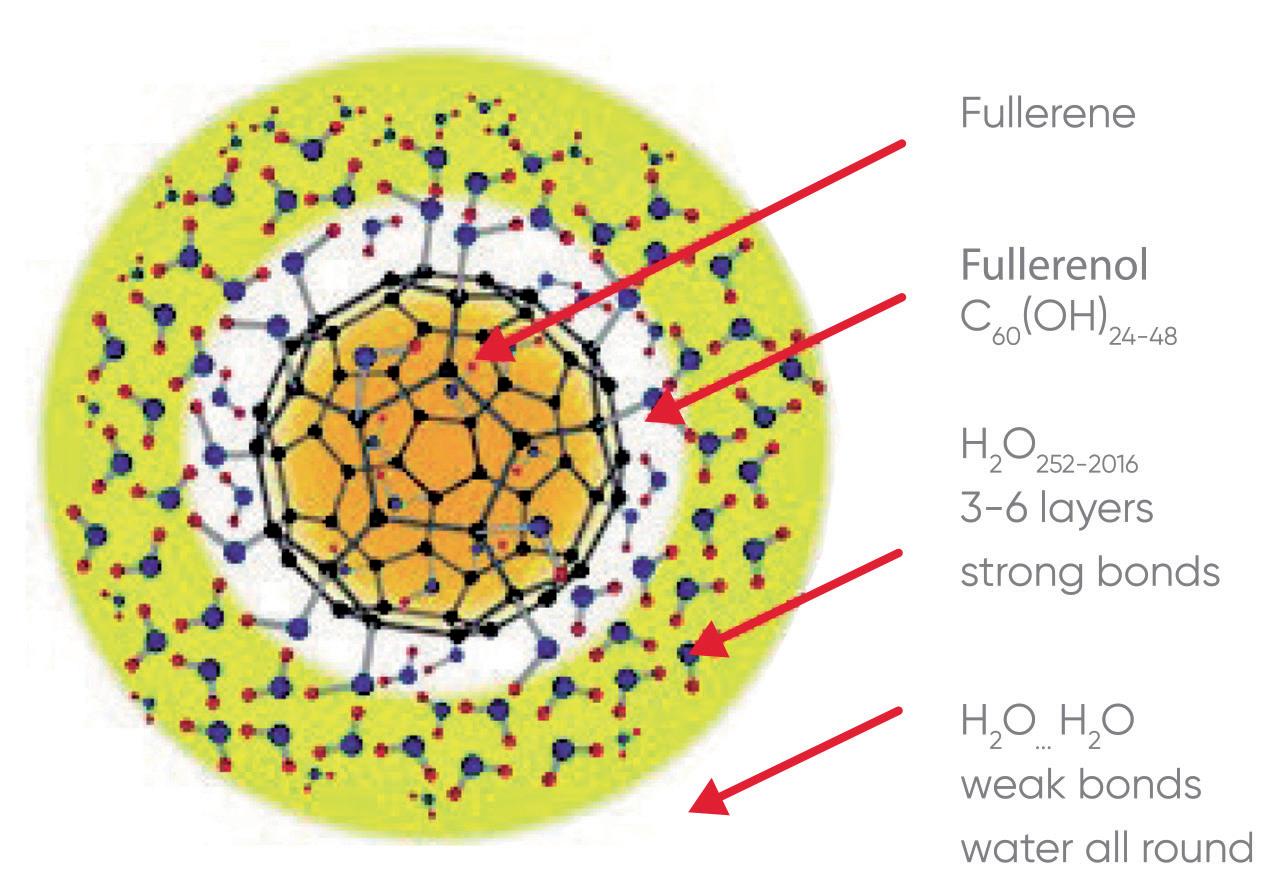
Schematic representation of the structure of 3HFWC.
As explained in Chapter 6, fullerene C60 itself is composed entirely of carbon atoms arranged in a cage-like or spherical structure resembling a soccer ball. On top of its classical properties (structure, stability, and molecular mass), by rotating 18 billion times per second and having multiple different vibrational states, the fullerene molecule also exhibits quantum properties. Fullerene C60 therefore acts on the skin in two different ways: In the classical way, i.e., by transferring energy, and in the quantum way through its wave function or “soliton effect.”
A soliton effect can be described as follows: Imagine a wave in the ocean. Normally, waves spread out and get smaller as they move. But a soliton is like a special wave that doesn’t behave in the same way. It retains its shape and size as it travels through the water. It’s like a wave that behaves like a single, unchanging bump instead of spreading out. This special behavior is called the soliton effect. Because water is one of the most important components of the skin, as well as for the whole human body, the skin aqueous layers can transmit vibrations caused by the fullerene C60 core in 3HFWC through surrounding molecules and affect the conformational state of the skin’s proteins such as collagen and elastin, as well as lipids and other structures.
The important role of water molecules in the functioning of our skin.
A water molecule is composed of oxygen and hydrogen atoms held together by a chemical covalent bond. Due to the partial positive and negative charges on the hydrogen and oxygen atoms, neighboring water molecules are held together by hydrogen bonds or dipole bonds.
Let’s dive a bit deeper into these hydrogen bonds and why they are important. Hydrogen bonds are very important in the structure
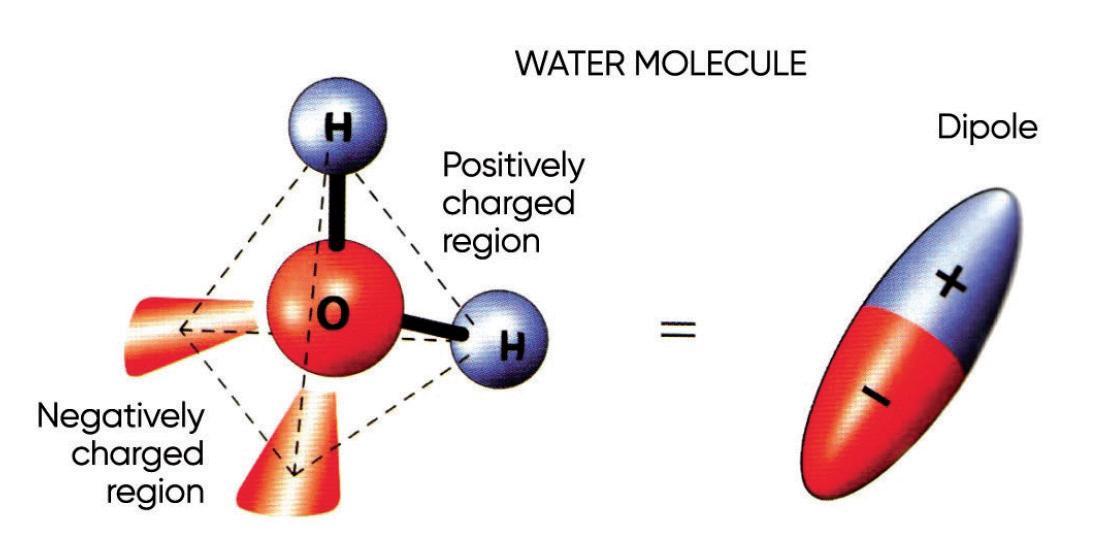
Schematic representation of a water molecule with positive and negative charge: The region near the oxygen molecule is negatively charged, while the region near the hydrogen molecule is positively charged, creating a dipole.
and function of all biological molecules. Linus Pauling, a renowned American chemist, made significant contributions to our understanding of the importance of hydrogen bonds in chemistry and biology. His work on the nature and significance of hydrogen bonds had a profound impact on the field of molecular biology and our comprehension of the structure and function of biomolecules. For instance, Pauling’s research highlighted the critical role of hydrogen bonds in determining the three-dimensional structures of important biomolecules, such as proteins and DNA. Hydrogen bonds help maintain the specific shapes and structures of these molecules, which is essential for their functions.
In addition, his insights into hydrogen bonding were influential in the discovery of the double helical structure of DNA, a groundbreaking achievement for which he is often credited. Hydrogen bonds between complementary base pairs (adenine-thymine and guanine-cytosine) hold the two strands of DNA together, allowing for replication and the storage of genetic information. Hydrogen bonds are involved in various biological processes, such as enzyme-substrate interactions, ligand- receptor binding, and the folding of RNA molecules.
The Quantum Effects of Hydrogen Bonds
In 1999, it was experimentally proven that hydrogen bonds also have both classical and quantum aspects. The classical description emphasizes the electrostatic attraction between atoms, which can be understood using classical physics. However, the formation, strength, and detailed behavior of hydrogen bonds are intricately tied to quantum mechanical principles. Any change in the strength of the hydrogen bonds or its termination causes a change that can be an integral part of a regulatory system, leading to impaired functionalism or disorder of molecular processes, including the development of disease. As such, quantum products such as 3HFWC can act at the nano-quantum level of the water present in skin and influence the quality of skin proteins such as collagen-both energetically in the classical way and energetically-informationally in the quantum way.
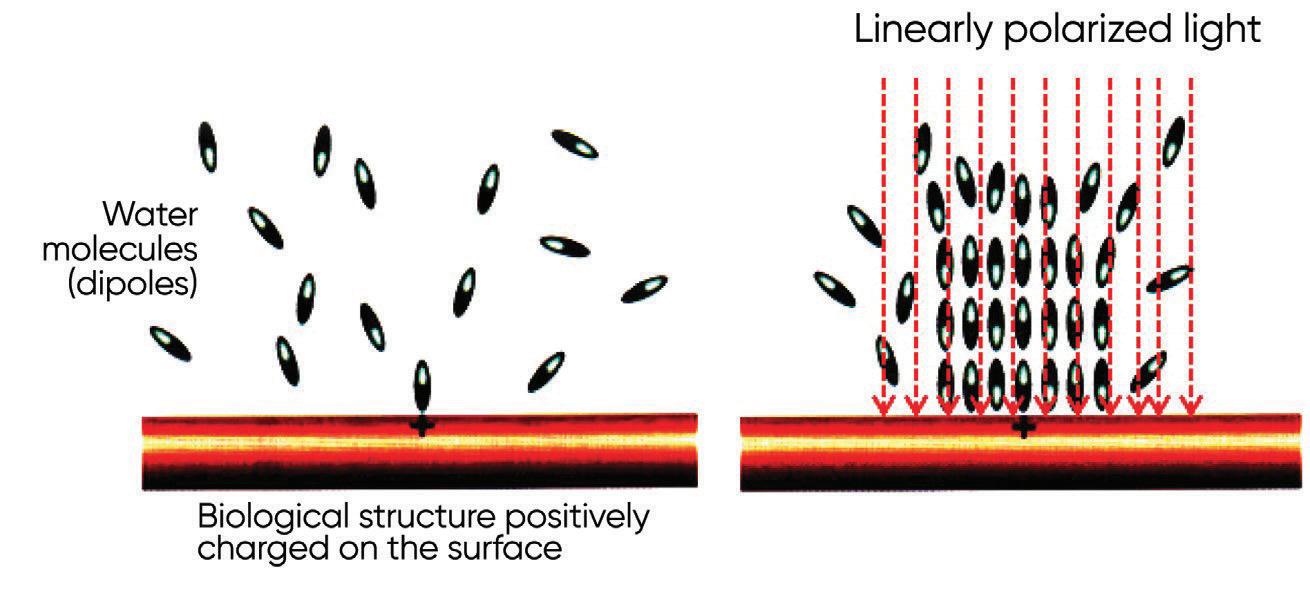
Schematic representation of water molecules (dipoles) arranged randomly in the presence of a biomolecule possessing a mainly positive charge on its surface (left). Under the influence of Quantum Hyperlight, water molecules adopt a regular, structured arrangement. This generates an electromagnetic effect on skin biomolecules such as collagen, which is essential for their normal functioning (right).
Clinical studies conducted in 38 female volunteers have shown the positive effects of 3HFWC on the quantity and quality collagen fibers, and an improvement in the baseline membrane functionality by means of a novel high sensitivity detection method known as optomagnetic imaging spectroscopy (OMIS). In addition, it was shown that 3HFWC increases moisturization of the skin as a result of establishing hydrogen bonds with water and other biomolecules (Miljkovic et al., 2019; Miljkovic et al., 2021).
Hyperlight Fluid Fusion Cosmetic Face Mist Containing 3HFWC
Hyperlight Fluid Fusion is a cosmetic face mist that restores the natural harmony of the skin at the cellular level. It contains 100% 3HFWC. The product is designed as a face spray for easy application. The fullerene C60 carbon component interacts with light to restore the natural harmony of the skin at the cellular level through resonance and light fusion with the electromagnetism of biomolecules. This aligns the covalent and non-covalent hydrogen bonds, bringing the biomolecules back into their natural, harmonized state (soliton effect).
Hyperlight Fluid Fusion has shown to have significantly higher thermostability, photostability, and antioxidant activity compared to other antioxidants. Because fullerene C60 has up to 250 times greater antioxidant effects than vitamin C, its potent antioxidative properties can reduce oxidative stress, thereby helping to sustain healthy skin. Oxidative stress, caused by active oxygen or free radicals, is harmful to skin.
The main factor contributing to oxidative stress in skin tissue is hazardous light and UV radiation. When skin is exposed to UV radiation, active oxygen or free radicals are produced, which can cause a series of biological effects in human skin cells, resulting in cell damage or cell
death. 3HFWC also blocks the harmful UVA and UVB rays, hazardous blue light, and electromagnetic smog by absorbing free radicals. It effectively prolongs cell life and stimulates the production of fibroblasts to fill skin cells with natural collagen.
Oxidative stress plays a major role in acne formation. In active acne lesions, too much sebum is produced and neutrophils infiltrate into pilosebaceous units. With the application of Hyperlight Fluid Fusion
Subcellular Complex onto the skin, super oxides are scavenged and successive filtration and sebum production are reduced, resulting in the suppression of inflammation. It also tightens large pores and improves skin texture.
Hyperlight Fluid Fusion also has a strong bactericidal impact. Fullerenes have been found to possess powerful bactericidal properties towards pathogenic bacteria. Their mechanism of action is based on chemical interactions with the bacterial surface. Because fullerene C60 absorbs light, it generates reactive oxygen species that cause considerable structural damage to the cell wall and membrane of microorganisms, rendering them inactivated and unable to reproduce. This antimicrobial activity was demonstrated against a variety of disease-inducing bacteria, including St. aureus, E. faecalis, E. coli, P. aeruginosa, B. subtilis, K. pneumoniae, S. typhimurium, and yeast candida albicans (Aoshima et al., 2009; Heredia et al., 2022). Hence 3HFWC also reduces the risk of skin infections, which is often the cause of delayed wound healing. In an animal study mimicking infected wounds caused by S. aureus, it was shown that 3HFWC not only reduced inflammation but also contributes to faster wound healing (Knezevic et al., 2021).
Hyperlight Fluid Fusion can also be used for oral cavity hygiene. There are more than 700 different species of bacteria that can found in the mouth, and without proper hygiene, they can reach levels that might lead
to oral infections and even deadly diseases. Gingivitis (bleeding gums) is one of the leading oral infections, affecting 50% of the population. A recent clinical study involving 60 subjects suffering from gingivitis demonstrated that twice-daily use of 3HFWC for two weeks significantly reduced the number of dental plaque microorganisms with an efficacy equal to 0.12% chlorhexidine mouth rinse (Tambur et al., 2023).

Quantum Hyperlight cosmetics: Hyperlight Fluid Fusion and La Danza Hyperlight Fusion.
La Danza Anti-Aging Cream Containing 3HFWC
La Danza Hyperlight Fusion is a day-and-night facial cream containing 3HFWC as its main active ingredient. Because of the antibacterial properties of 3HFWC, La Danza is preservative-free cosmetic product. Based on the previously explained resonance principles of
biomimicry, the interaction of 3HFWC in the cream’s formulation with light will impose its energetic and structural properties on deformed and damaged molecules in the skin. Using electromagnetic energy transmission, collagen fibers are harmonized to improve the quality and appearance of the skin.
Similar to Hyperlight Fluid Fusion Spray, La Danza cream also protects against the damaging effects of blue light, UVA, and UVB. The strong anti-oxidant properties of 3HFWC absorb UV-induced free radical production.
La Danza Hyperlight Fusion is an extremely powerful complex of active ingredients that adapts to all skin types. It reduces the depth of wrinkles, improves skin firmness and elasticity, moisturizes at the cellular level, protects against external factors, prevents allergies and skin irritations, and firms and brightens the skin, giving it a youthful appearance. Regular use of the product once or twice a day provides the skin with greater hydration, firmness and plumpness, increases its resistance to the negative effects of external factors, and accelerates the healing of minor damage. The unique properties of 3HFWC make the product ideal for both sensitive or mature skin that is prone to irritation and allergic reactions.
PART IV: Future Applications of Fullerene Based
Quantum Hyperlight
CHAPTER 11:
First Results in the Treatment of Cancer and Alzheimer’s Disease
Skin Cancer
Skin cancer is one of the most common cancers worldwide. Among the skin cancers, cutaneous melanoma is the most aggressive one with a high incidence of mortality, as it is known for its potential to spread rapidly to other parts of the body. Melanoma results from neoplastic transformation of normal pigment-producing melanocytes in the skin. Unfortunately, the prognosis for advanced stages of melanoma is very poor.
Recent research has demonstrated that treatment of melanoma (skin cancer) cells with both Quantum Hyperlight irradiation and 3HFWC (added to the cell culture medium) not only reduced the viability of these cells, but also initiated their “reprogramming” into normal cells. These initial experiments were performed in vitro (cells cultivated in laboratory conditions).
However, in a second experiment performed on animals (a mouse melanoma model), these results were confirmed: A strong anti-tumor effect of 3HFWC added to the drinking water of the mice in conjunction with Quantum Hyperlight irradiation was observed. These effects are mainly due to the stimulation of melanoma cell growth arrest and the induction of an anti-tumor immune response of the combination of 3HFWC and Quantum Hyperlight. Because the observed effects of 3HFWC and Quantum Hyperlight irradiation are
additive, further clinical trials in human cancer patients are currently underway to evaluate the potential use of 3HFWC Quantum Hyperlight-based phototherapy in skin cancer treatment (Markelic et al., 2022; Markelic et al., 2023).
Alzheimer’s Disease
Alzheimer’s disease currently affects approx. 50 million people worldwide, and this number is estimated to increase to 62% by 2030. Alzheimer’s disease is a progressive neurodegenerative disorder that primarily affects the brain, causing memory loss and cognitive decline. Alzheimer’s is characterized by the accumulation of abnormal protein deposits in the brain, including amyloid plaques (abnormal clumps) and tau tangles (tangled bundles of fibers). These plaques have toxic effects on neurons and disrupt cell-to-cell communication. There is currently no known cure for Alzheimer’s disease, but there are medications and interventions that can help manage its symptoms and slow its progression.
The therapeutic effects of fullerenes are well documented, including antiviral and antibacterial effects and their interaction with cancer cells. In order to understand the effects of 3HFWC, its ability to interact with Aβ beta protein was investigated in cell cultures. (Aβ beta protein is part of the amyloid plaques). These studies show that 3HFWC is able to inhibit their aggregation, the same process that initiates the formation of plaques in the human brain.
The positive effects of 3HFWC were also evaluated in a genetically modified mice model that mimics the development and progression of Alzheimer’s disease (Alzheimer’s disease does not develop in rodents). Adding 3HFWC to the drinking water of the mice for 3
months resulted in a significant decrease of amyloid plaque load in the animal’s brain without any other negative effects. The potential of 3HFWC to interact with amyloid plaque and exert an effect on the Alzheimer’s disease brain in laboratory mice is promising for the future, and significantly expands the therapeutic value of 3HFWC, in particular as a preventive agent in our aging population (Perovic et al., 2023).
CHAPTER 12: Quantum Hyperlight Regulation of Plant Growth
The positive effects of 3HFWC have also been investigated in the developments of plants. A recent research project looked at its influence on the growth and development of tomato plants. The goal of this study was to evaluate the positive effects of adding 3HFWC to the water used to water the soil on the growth of cherry tomato plants (Subotic et al., 2022).
Cherry tomato seeds (Solanum lycopersicum L.) were sown in special soil and grown in a greenhouse under controlled conditions (temperature and humidity). During the germination phase, in parallel to control seeds that were irrigated with untreated water, treated seeds were given water treated with 3HFWC once a day every two days. When seedlings developed their first leaves, plants were transplanted weekly and grown following standard agrotechnology practices until they reached a height of 7-15 cm. The plants were then transplanted again and further cultivated under optimized conditions (light exposure, temperature, and humidity) until full maturity and fruiting. Control plants were irrigated with water once a week, while treated plants were given 3HFWC.
Impressive results were obtained both in terms of increased seed germination and growth and development of the plants itself. After 3 days of cultivation, 3HFWC-treated seeds showed much earlier seedling development compared to untreated seeds. After 3 weeks of cultivation, 3HFWC-exposed seedlings were 41.7% higher, their weight
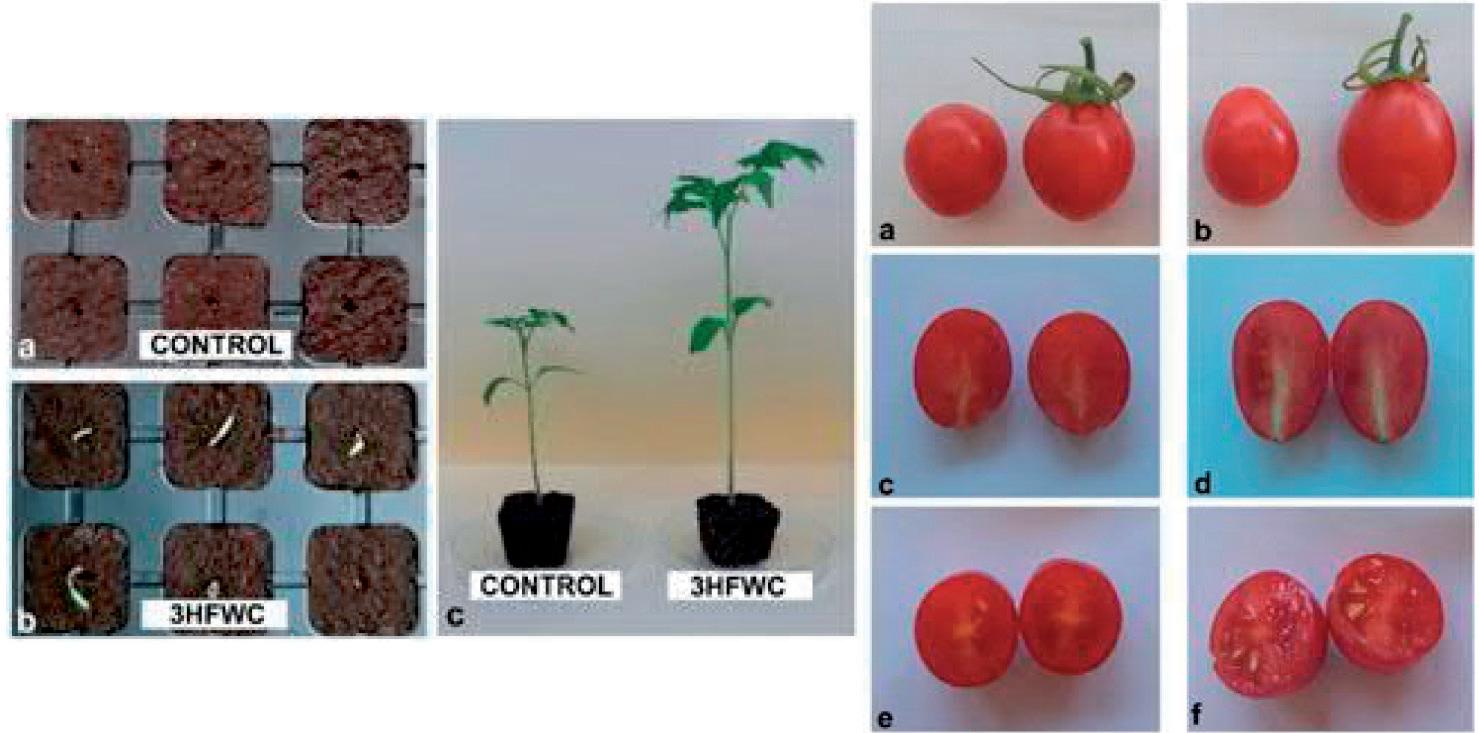
was 3.4 times higher, and more leaves had developed on each seedling (upper images).
In addition, the tomato fruits grown in the presence of 3HFWC were not only bigger, fruits from 3HFWC-treated plants were 32.5% heavier, 8.7% wider, and 12.9% larger than fruits from control plants-but also contained substantially more lycopene, significantly improving the nutritional value of the tomato (the lycopene content of fruits from 3HFWC-treated plants was 63.8% higher compared to fruits from control plants). Lycopene is considered the most effective free radical scavenger among carotenoids and has antioxidative, anti- diabetic, cardio-protective, anti-inflammatory, hepatic and neuro- protective, and anti-cancer properties. The authors further conclude that 3HFWC is safe to use, has no adverse effects on cherry tomato growth, and might be considered a possible candidate for use as nano- fertilizer.
CONCLUSION
Quantum Medicine is an emerging field of medical practice in which the principles of quantum physics are being integrated in different therapeutic applications. Quantum mechanistic principles have many functions in the human body, and, although still in a fairly early stage of development, quantum theories are becoming gradually accepted as fundamental principles in human cell, tissue physiology, and functioning. One of the most advanced fields of quantum medicine is the therapeutic application of light, in particular Quantum Hyperlight. Based on the Nobel Prize in Chemistry in 1996, the development of the fullerene C60-based nanophotonic filter allows the generation of hyperpolarized light known as Quantum Hyperlight. Quantum Hyperlight, based on the principles of biomimicry and “structured light meets structured matter,” harmonizes the molecular structure of the majority of the body’s biomolecules, including water clusters, collagen, microtubules, centrioles, and clathrin vesicles. As such, it can positively stimulate the body into using its own cellular processes for tissue repair.
Quantum Hyperlight-based consumer products have proven to make a difference in millions of people’s lives. In particular, the development of the Bioptron Quantum Hyperlight light emitting system, which was approved as a certified medical device based on more than 50 clinical studies demonstrating its efficacy in treating chronic wounds, rheumatoid symptoms, back pain, skin diseases, seasonal affective disorders, sleeping problems, and signs of skin aging, has been shown to have no negative side effects. Most certified therapeutic applications of Bioptron Quantum Hyperlight are based on an extremely
easy-to-use treatment regimen of 10-20 minutes exposure, which can be performed very easily at home.
The integration of the fullerene C60 nanophotonic filter into glasses resulted in the development of unique Hyperlight Optics. Going beyond the functionality of traditional sunglasses, the innovative technology of Hyperlight Optics transforms the energy of harmful high-energy spectra (ultraviolet rays and blue light) into Quantum Hyperlight to optimize the secretion of hormones in the brain, notably serotonin, dopamine, cortisol, and melatonin. By wearing Hyperlight Optics both indoors and outdoors, especially when exposed to blue light emitting devices such as your phone, PC, or when watching television, you can protect your eyes, optimize your cognitive skills, and restore your hormonal and psychological balance. Ultimately, you will see more, feel better, think faster, and live better.
The bio-stimulating principles of fullerene C60 have also been incorporated in cosmetic products known as Quantum Hyperlight cosmetics, which has been made possible by the development of 3HFWC, a water-soluble fullerene-based active ingredient. Two cosmetic formulations, Hyperlight Fluid Fusion face spray and La Danza anti-aging cream, have proven to positively restore skin function and metabolism through the interaction of light with 3HFWC when the products are applied to the skin. In addition to the antibacterial and strong antioxidant properties of 3HFWC, Quantum Hyperlight cosmetics are particularly suitable for people with sensitive skin.
AFTERWORD: My Family’s Quantum Hyperlight Experiences
I want to finish this book by providing a personal experience from within my family, as both my parents can testify to the unique healing powers of Quantum Hyperlight. My father, 65, has consistently maintained an active lifestyle. As a self-made professional, he dedicated himself to his extremely physical job of selling palm trees. Beyond his career, he also pursued his passion for sports, in particular kitesurfing. Also known as kiteboarding, kitesurfing is a water sport involving riding a board while being propelled by a steerable kite, harnessing the power of the wind to experience exhilarating speeds and the pure joy and excitement of the sport.
Unfortunately, two years ago during a kitesurfing session, he injured his knee so badly that his doctor prohibited him from continuing with his beloved sport. The physical pain from his injured knee was only compounded by the emotional toll it took on his morale and well-being. For many months, he explored various different therapies, including anti-inflammatory creams, medications, and physiotherapy, but nothing provided meaningful relief. Eventually, he made the difficult decision to sell his kitesurfing equipment, having resigned himself to the belief that he would never fully recover.
When I was first learned about Bioptron Quantum Hyperlight, I persuaded him to give it a try. He began using the lamp twice daily for 10 minutes at a distance of 10 cm. After just a few weeks of treatment,
his pain had completely disappeared. After a further two months into his daily 10-minute treatment sessions, my father started -yes, you’ve guessed it- surfing again. He began E-foil surfing, a sport that requires two healthy knees to successfully ride the waves!
Then there is also my mother. At 62 years old, my loving mother and devoted housewife, occasionally experienced stress. In July 2022, she started suffering from pain and the development of hard nodules in her left breast. Unfortunately, she did not recognize the urgency of seeking immediate treatment. As the months passed, it progressed into a severe condition, with the breast starting to turn black and a large necrotic wound forming. By the time she finally sought medical attention in December 2022, she was diagnosed with breast cancer. The doctors informed her that the extensive wound prevented them from operating. As a result, my mother started hormonal therapy combined with the oral intake of medicinal mushrooms.
I told my mother about the excellent clinical results of Bioptron Hyperlight in wound healing, and she started to incorporate two daily 10-minute sessions. Four months later, the wound on her breast had healed completely. Of course, the breast is still a bit discolored, but the wound closed completely. I only wish I could have taken pictures, but my mother did not feel comfortable with that. I had to respect her choice.
Myriam Willemse
Quantum Hyperlight consumer products are developed, produced and commercialized by the company Bioptron AG and Intercosmetica AG, part of the Zepter Group of companies, and can be bought online in at least 60 countries. For more details:
BIOPTRON Quantum Hyperlight Devices
https://www.bioptron.com
Quantum Hyperlight Optics
https://shop.zepter.com/Hyperlight-Optics/Hyperlight-Eyewear https://hyperlightoptics.com/
Cosmetics Based on Quantum Hyperlight Technology Hyperlight Fluid Fusion https://shop.zepter.com/beauty-wellness/Special-Treatment/ Hyperlight-Fluid-Fusion
Anti-aging creme La Danza Hyperlight Fluid Fusion https://shop.zepter.com/beauty-wellness/Women/ Soft-Touch-Eye-Cream-(1)
Please scan the QR code above to discover Quantum Hyperlight innovations.
BIBLIOGRAPHY
Bibliography PART I: Quantum Medicine
Agostinis P., Berg K., Cengel K, Foster T., Girotti A., Gollnick S., M Hahn S., Hatnblin M., Juzeniene A., Kessel D., Korbelik M., Moan J., Mroz P, Nowis D., Piette J., Wilson B., Golab J. (2011). Photodynamic therapy of cancer: an update. Cancer J Clin. 61(4), 250-281.
Bisiani J., Anugu A., Pentyala S. (2023). It’s Time to Go Quantum in Medicine. J. Clin. Med., 12(13), 4506.
Chopra D. (2015). Quantum healing: Exploring the frontiers of mind/ body medicine (updated ed.). Bantam.
Chopra D., Tuszynski J., Fertig B. (2023). Quantum Body: the New Science of a Living Longe, Healthier, More Vital Life. Harmony Books.
Di Gregorio E., Israel S., Staelens M., Tankel G., Shankar K., Tuszynski J. (2022). The distinguishing electrical properties of cancer cells. Physics of life reviews, 43, 139-188.
Fertig B., Chopra D., Tuszynski J. (2022). Towards Quantum Medicine. HSOA Journal of Alternative, Complementary & Integrative Medicine, 8:251, 1-13.
Godzsche PC. (2011). Niels Finsen’s treatment for lupus vulgaris. Journal of the Royal Society of Medicine, 104(1), 41-42.
Gonzales M., Sutherland E. and Olalde J. (2020). Quantum functional energy medicine: The next frontier of restorative medicine. Journal of Restorative Medicine, 9(1), 1-7.
Griffiths, D.J. and Schroeter D.F. (2018). Introduction to quantum mechanics (3rd ed.). Cambridge University Press.
Grover V., Tognarelli J., Crossey M., Cox I., Taylor-Robinson S., McPhail M. (2015). Magnetic Resonance Imaging: Principles and Techniques: Lessons for Clinicians. Journal of clinical and experimental hepatology, 5(3), 246-255.
Hönigsmann H. (2013). History of phototherapy in dermatology. Photochemical & photo biological sciences: Official journal of the European Photochemistry Association and the European Society for Photobiology, 12(1), 16-21.
Jacques S. (2013). Optical properties of biological tissues: a review. Physics in medicine and biology, 58(11), R37-R61.
Jafari M., Hasanzadeh M. (2020). Cell-specific frequency as a new hallmark to early cancer and efficient therapy: recording of cancer voice as a new horizon. Biomedicine and Pharmacotherapy, 122, 10977.
Ko D., Lyons A., Kohli I., Narla S., Torres A., Miller A., Ozog D., Hamzavi I., Lim H. (2022). The value of photomedicine in a global health crisis: Utilizing ultraviolet C to decontaminate N95 respirators during the COVID-19 pandemic. Photodermatol. Photoimmunol. Photomed., 38(2), 95-98.
Korotkov K. (2023). The Principles and Practice of the Integrative Quantum Medicine. Independently published. ISBN-13: 979- 8859094196.
Lakhovsky G. (2007). The Secret of Life: Cosmic Rays and Radiations of Living Beings. Digireads.com. ISBN-13: 978-1420929959.
Lee J., Lee J., Kim S. (2021). Current and Future Perspectives on Light Therapy Using Wearable Devices. Chronobiol Med., 3(3), 92-96.
Magas V. (2006). Perspective of Quantum Medicine. In Burdyuzha, V. (Eds.) The Future of Life and the Future of Our Civilization (321334). Springer. https://doi. org/10.1007/978-1-4020-4968-2
Mussttaf R., Jenkins D., Jha A. (2019). Assessing the impact of low-level laser therapy (LLLT) on biological systems: a review. Int J Radiation Biol., 95(2), 120-143.
Ngoc L., Moon J., Lee Y. (2023). Utilization of light-emitting diodes for skin therapy: Systematic review and meta-analysis. Photodermatol. Photoimmunol. Photomed., 39(4), 303-317.
Oschman J. (2015). Energy Medicine: The Scientific Basis (2nd Ed.). Churchill Livingstone. ISBN-13: 978-0443067297.
Pjrek E., Friedrich M., Cambioli L., Dold M., Jager F., Komorowski A., Lanzenberger R., Kasper S., Winkler D. (2020). The Efficacy of Light Therapy in the Treatment of Seasonal Affective Disorder: A Meta- Analysis of Randomized Controlled Trials., Psychother Psychosom., 89(1), 17-24.
Reddy S., Reddy V., Shanna S. (2023). Physiology, Circadian Rhythm In: Stat Pearls Treasure Island (FL). Stat Pearls Publishing.
Rein G. (2004). Bioinformation Within the Biofield: Beyond Bioelectromagnetics. The Journal of Alternative and Complernentary Medicine (NewYork,NY),10(1),59-68.http://doi.org/10.1089/107555 304322848968.
Satyanand A. (2000). Surya Chikitsa. Diamond. ISBN/UPC: 8171820107.
Siko S. (2002). Life as a Fourth level of Quantum Organization of Nature. In Proceedings of the International Workshop: Energy and Information Transfer in Biological Systems, Acireale, Catania, Italy, 18- 22 September 2002, World Scientific, New Jersey - London – Singapore - Hong Kong, p. 358 (p. 293-307).
Sliney D. (2016). What is light? The visible spectrum and beyond. Eye (London, England). 30(2), 222-229.
Tiller W. (2004). A Personal Perspective on Energies in Future Energy Medicine. The Journal of Alternative and Complementary Medicine, 10(5). 867-877. http://doi. org/10.1089/acm.2004.10.867.
Whelan H., Sn1its R., Buchman E., Whelan N., Turner S., Margolis D., Cevenini V., Stinson H., Ignatius R., Martin T., Cwiklinski J., Philippi A., Graf W., Hodgson B., Gould L., Kane M., Chen G., Caviness J. (2001). Effect of NASA light-emitting diode irradiation on wound healing. J Clin Laser Med Surg., 9(6), 305-14.
Woloshyn T.A. (2017). Soaking up the rays. Light therapy and visual culture in Britain, 1890-1940. Manchester University Press.
Bibliography PART II: Quantum Hyperlight
Baggott J. (1994). Perfect Symmetry: The Accidental Discovery of Buckminsterfullerene (IX+ 315). Oxford University Press.
Bhakta P., Barthunia B. (2020). Fullerene and its applications: A review. Journal of Indian Acade,ny of Oral Medicine and Radiology, 32(2), 159-163.
Cifra M., Brouder C., Nerudova M. and Kučera O., (2015). Biophotons, coherence and photocount statistics: A critical review. Journal of Luminescence, 164, 38-51.
Gurwitsch A, (1923) Arch Entw Mech Org, 100 (1), 11-40.
Hamouda S., Khalifa N; and Belhasan M. (2018). Bio-Photon Research and Its Applications: A Review. Int.J Interdisciplinary Research and Innovations, 6(1), 35-46.
Koruga D. (2018). Hyperpolarized Light: Fundamentals of NanoBiomedical Photonics (Library Special Editions). Zepter Book World. Belgrade.
Koruga D., Matija L., Stankovic I., Jeftic B., Thompson N. (2023). Medical Devices Based on Mimicry in Light-Matter Interaction: “Structured matter meets Structured Light”. In Najman, S., et al. (Eds.). Bioceramics, Biomimetic and Other Compatible Materials Features for Medical Applications: Engineering Materials, Springer Nature Switzerland.
Litchinister N. (2012). Structured light meets structured matter. Science (New York, NY.), 337(6098), 1054-1055.
Ozturk S., Yalta K., E Yetkin E. (2016). Golden ratio: A subtle regulator in our body and cardiovascular system. Int. J Cardio, 15(223), 143-145.
Popp F. (2003). Properties of biophotons and their theoretical implications. Indian J Exp Biol., 41(5): 391-402.
Ravindra C., Rengan V., Ramana B. (2022). A systemic review of Fibonacci Sequence in the human abdominal wall. Cereus, 14(12), e33072.
Rizzo R., Hank N., Zhanga J. (2016). Detecting presence of cardiovascular disease through mitochondria respiration as depicted through biophotonic emission. Redox Biol., 8, 11-17.
Van Wijk R., Van Wijk E. (2005). An Introduction to Human Biophoton Emission. Forsch. Komplementȁrmed. Klass Naturheilkd, 12(2), 77-83.
Zapata F., Pastor-Ruiz V., Ortega-Ojeda F., Montalvo G., Ruiz-Zolle A., Garcia-Ruiz C. (2021). Human ultra-weak photon emission as non- invasive spectroscopic tool for diagnosis of internal states - A review. J Photochem Photobiol B., 216, 112141.
Bibliography Bioptron Quantum Hyperlight Therapy System
Abd-Elhamed T., G., Borhan W., H., Abd-Alwahab M., G., & Abd Elhameed M., M. (2022). Polarized light therapy for wounds: a systemic review. The Egyptian Journal of Hospital Medicine, 93, 7600-7609.
Abdel-Mageet S., M., Selim A., O.,Ghafar M., A., A., &Ali R., R. (2015) A description of the effect of polarized light as an adjuvant therapy on wound healing in pediatrics. International Journal of Biophysics 5 (1): 18-23
Abdou W., El-Kosery S., Kassab A., Younsi H. (2019). Effect of Bioptron in Treating Cracked Nipples in Breast Feeding Women: A Randomized Controlled Trial, World J Med. Sci., 16 (1), 35-40.
Abramovich S. G., Drobyshev, V. A., Koneva, E. S., & Makhova, A. A. (2020). The efficacy of the comprehensive use of naphthalan and non- selective chromotherapy in the treatment of patients with gonarthrosis. Drug Research, 70(04), 170-173.
Ahmed, A. A. E. S. A., Abdel-Aziz, K. S., Ahmed M., Awad M., Mahmoud A.H. A., Ahmed, A. A. (2020). Effect Of Polarized Light Therapy on Incisional Pain After Cesarean Section. European Journal of Molecular & Clinical Medicine, 7(10).
Antonic M. The use of polychromatic polarized light BIOPTRON in physiotherapy. 2-5 (unpublished).
Aragona, S. E., Grassi, F. R., Nardi, G., Lotti, J., Mereghetti, G., Canavesi, E., Lotti, T. (2017). Photobiomodulation with polarized light in the treatment of cutaneous and mucosal ulcerative lesions. Journal of Biological Regulators and Homeostatic Agents, 31(2 Suppl. 2), 213-218.
Aronis E., Braziotis A., Kafouros K., Pagratis N., Papakostas T., Venetsanos P. (1992). The Action of Visible Polarized Light on Skin Diseases. Poster Presentation 1992, 25. (case series, internal).
Bahrami, H., Moharrami, A., Mirghaderi, P., & Mortazavi, S. M. J. (2023). Low-Level Laser and Light Therapy After Total Knee Arthroplasty Improves Postoperative Pain and Functional Outcomes: A Three-Arm Randomized Clinical Trial. Arthroplasty Today, 19, 101066.
Ballyzek M., Vesovic-Potic V., Johnston A. (2005). Efficacy of polarized, polychromatic, non-coherent light in the treatment of chronic musculoskeletal neck and shoulder pain. Unpublished Material, BIOPTRON AG, Wollerau, Switzerland.
Begic-Rahic, J., Vranic S. (2010). The application of Bioptron Light Therapy in dermatology and wound healing. European Dermatolo.5:57–60.
Białożyt J., Materniak K., Kawecki M. (2018). Use of polarized lighting in support of treatment of pressure ulcers among patients after bums. Preliminary report. Dermatologia Estetyczna, 20(1), 114.
Campbell P., Miller A., and Woesner M. (2019). Bright Light Therapy: Seasonal Affective Disorder and Beyond. Einstein J Biol Med., 32, E13-E25.
Chen B., Liu Y., Liu Y., Xu S. (2023). Distribution characteristics of pathogens in different stages of pressure ulcers and the therapeutic effect of linear polarized polychromatic light combined with silver sulfadiazine cream. Medicine, 102(42), e35772.
Choi M., Kim J., Cho K., Lee J. (2013). In vivo and in vitro analysis of low-level light therapy: a useful therapeutic approach for sensitive skin. Lasers Med Sci., 28(6), 1573-9. DOI: 10.1007/s10103-013-1281-x.
Chumak A., (2000). Role of nitric oxide in modulation of afferent impulses in cutaneous branches of somatic nerves by polarized light. Bull Exp Biol Med., 130(8), 734-6.
Colić M., Vidojković, N., Jovanović, M., Lazović, G. (2004). The use of polarized light in aesthetic surgery. Aesthetic plastic surgery, 28(5), 324-327.
De Melo C., Alves A., Terena S., Fernandes K., Nunes F., da Silva D., Bussadori S., Deana A., Mesquita-Ferrari R. (2016). Light-emitting diode therapy increases collagen deposition during the repair process of skeletal muscle. Lasers Med Sci. ;31 (3), 531-8.
Dimitrios S., Stasinopoulos L. (2017). Treatment of carpal tunnel syndrome in pregnancy with polarized polychromatic non-coherent light (Bioptron light): a preliminary, prospective, open clinical trial. Laser therapy, 26(4), 289-295.
Đurović A., Marić D., Brdareski Z., Jevtić M., Đurđević, S. (2008). The effects of polarized light therapy in pressure ulcer healing. Vojnosanit Pregled, 65(12), 906-912.
El-Deen, H. B., Fahmy, S. E. H. A. M., Ali, S. A., & El-Sayed, W. M. (2014). Polarized light versus light-emitting diode on healing of chronic diabetic foot ulcer. Romanian Journal of Biophysics, 24(2), 1-15.
Feehan J., Tripodi N., Fraser S., Mikkelsen K., Thewlis N., Kiatos D., Husaric M., Apostolopoulos V. (2019). Polarized light therapy: Shining a light on the mechanism underlying its immunolodulartory effects. J Biophotonics, 13, e201960177.
Fenyö M., Mandl J., Falus A. (2002). Opposite effect of linearly polarized light on biosynthesis of interleukin-6 in a human B lymphoid cell line and peripheral hu1nan monocytes. Cell Biology International, 26(3), 265-269.
Filipović B., Miljković S., Jeftić B., Nešković A., Mileusnic I., Ilankovic N., Jakovčevski I., Koruga D. (2023). Influence of nano photonic light ordered by Fibonacci sequences on serotonin and melatonin levels and affective state of healthy volunteers. (Internal report).
Gallacchi G. (1993) Comparative Study on the Efficacy and Tolerance of Two Different Light Therapy Devices (BIOPTRON Device and Philips Lamp) Used to Treat Patients Suffering from Localized pain States. (Unpublished).
Gasparyan L., Brill G., Makela A. (2005). Activation of angiogenesis under influence of red low level laser radiation. In Laser Florence 2004: A Window on the Laser Medicine World (Vol. 5968, 4550). SPIE.
Golden, R. N., Gaynes, B. N., Ekstrom, R. D., Hamer, R. M., Jacobsen, F. M., Suppes, T. Nemeroff, C. B. (2005). The efficacy of light therapy in the treatment of mood disorders: a review and meta-analysis of the evidence. American Journal of Psychiatry, 162(4), 656-662.
Iordanou P. (2009). Effect of visible and infrared polarized light on the healing process of full-thickness skin wounds: an experimental study. Photomed Laser Surg., 27(2), 261-7.
Iordanou P., Baltopoulos G., Giannakopoulou M., Bellou P., Ktenas E. (2002). Effect of polarized light in the healing process of pressure ulcers. International journal of Nursing Practice, 8(1), 49-55.
Janković, A. (2005). Physical therapy of venous ulcers: effects of electroionotherapy and polarized light. Vascular Diseases, 4, 5.
Janković A., Binić I., Vručinić Z., Janković D., Janković I., & Jančić S. (2010). Can you combine herbal therapy with physical agents in the treatment of venous leg ulcers. Complementary Medicine Research, 17(5), 266-269.
Karadžić M. (2001). Polarized Light at the treatment of Rheumatoid Arthritis. (Unpublished).
Kolenko A. (2017) Light therapy in complex treatment of patients with herpes zoster. National Medical University named after O.O. Bogomolets, Kiev.
Kubasova T., Horváth M., Kocsis K., Fenyö M. (1995). Effect of visible light on some cellular and immune parameters. Immunology and Cell Biology, 73(3), 239-244.
Kymplova J., Navrátil L., Knížek, J. (2003). Contribution of phototherapy to the treatment of episiotomies. Journal of clinical laser medicine & surgery, 21(1), 35-39.
Leguina-Ruzzi A., Raichura K. R., Tonks S. K., Kwabi S., & Leitner C. (2019). Treatment of non-atopic dermatitis with polarized UV-free polychromatic light: A case report. Clinics and practice, 9(3), 1161. (case report).
Marx A. (2007). Amendment to the Clinical Evaluation of the BIOPTRON Light Therapy System, Version 01. BIOPTRON database 2007 (unpublished case reports).
Medenica L., Lens M. (2003). The use of polarized polychromatic non- coherent light alone as a therapy for venous leg ulceration. Journal of wound care, 12(1), 37-40.
Melrose S. (2015). Seasonal Affective Disorder: An Overview of Assessment and Treatment Approaches. Depress Res Treat., 2015, 178564.
Mihaylova M., Ruseva Z., Filkova S. (2017). The effect of polarized polychromatic non-coherent light (Bioptron) therapy on patients with lower back pain. Scripta Scientifica Salutis Publicae, 3(1), 23. 10.14748/ sssp. v3il.2165.
Mohamed M. H., Selem M. N., Mohamed M. S., Abd EL-Ghaffaar, H. A. (2019). Interleukin-6 response to shock wave therapy versus polarized light therapy in the treatment of chronic diabetic foot ulcers. Drug Invention Today, 11 (11).
Mohamed M. H., Tabia A., Selim, M. N. (2022). Ultrasonographic Response to Polarized Light Therapy in the Treatment of Atopic Dermatitis. Egyptian Journal of Physical Therapy, 9(1), 21-28.
Moeller S., Gbyl K., HjorthØj C., Andreasen M., Austin S., Buchholtz P., FØnss L., Hjerrild S., Hogervorst L., JØrgensen M., Ladegaard N., Martiny K., Meile J., Packness A., Sigaard K., Straarup K., Straszek S., Soerensen C., Welcher B., Videbech P. (2022). Treatment of difficult- to-treat depression - clinical guideline for selected interventions. Nord J Psychiatry, 76(3), 177-188. DOI: 10.1080/08039488.2021.1952303.
Monstrey S. J., Hoeksema H., Saelens H., Depuydt K., Hamdi M., Van Landuyt K., & Blondeel P. N. (2002). A conservative approach for deep dermal burn wounds using polarized-light therapy. British journal of Plastic Surgery, 55(5), 420-426.
Monstrey S., Hoeksema H., Depuydt K., Van Maele G., Van Landuyt, K., Blondeel, P. (2002). The effect of polarized light on wound healing. European Journal of Plastic Surgery, 24(8), 377-382.
Mowafy E., Mostafa Z., Ibrahim I., Ibrahim M., Elshahawy, A. (2021). Wound Surface Area and Colony Count of Various Modes of Phototherapy. Egyptian Journal of Hospital Medicine, 85(2).
Mowafy Z. M. E., Abdelrahman S. M. E., Ali K. M., Ali A. M. A. (2022). Low level laser therapy versus polarized light therapy on healing of foot burn. International Journal of Health Sciences, 6(S2), 13053- 13063. https://doi.org/10.53730/ijhs.v6nS2.8444.
Nardi GM., Guerra F., Ndokaj A., Corridore D., Straker MA., Sportelli P., Di Giorgio R., Grassi FR., Grassi R., Ottolenghi L. (2021). Phototherapy and Tailored Brushing Method. Personalized Oral Care in Patients with Facial and Dental Trauma. A Report of a Case. Healthcare (Basel). 9(5), 561. DOI: 10.3390/healthcare9050561.
Nardi G. M., Grassi R., Grassi F. R., Aragona S. E., Rapone B., Della Vella F., & Sabatini S. (2019). Use of photobiomodulation induced by polarized polychromatic non-coherent light in the management of adult chronic periodontitis. Journal of Biological Regulators and Homeostatic Agents, 33(1), 293-297.
Nardi G. M., Mazur M., Papa G., Petruzzi M., Grassi F. R., Grassi R. (2022). Treatment of Peri-Implant Mucositis with Standard of Care and Bioptron Hyperlight Therapy: A Randomized Clinical Trial. International Journal of Environmental Research and Public Health, 19(9), 5682.
Nemeth L., Groselj M., Golez A., Arhar A., Frangez I., & Cankar K. (2020). The impact of photobiomodulation of major salivary glands on caries risk. Lasers in Medical Science, 35(1), 193-203.
Nillni Y., Mehralizade A., Mayer L., Milanovicb, S. (2018). Treatment of depression, anxiety, and trauma-related disorders during the perinatal period: A systematic review. Clin Psychol Rev., 66, 136-148.
Nosseir A. A., Hamed H. A., Ali Z. A., Elwasefy S. A. (2020). Polarized Light Therapy versus Betamethasone Phonophoresis in Treatment of Psoriasis. Saudi Journal of Medical and Pharmaceutical Sciences, 06, 143-148.
Partonen, T., & Lönnqvist, J. (2000). Bright light improves vitality and alleviates distress in healthy people. Journal of Affective disorders, 57(1- 3), 55-61.
Petrović D., Zlatković-Svenda M., Lazović B. (2018). Could the complex regional pain syndrome (Sudeck atrophy), emerged as a distal radius at the typical site fracture complication, be prevented by physical therapy? Annals of Physical and Rehabilitation Medicine, 61, e114.
Petruzzi M., Nardi G. M., Cocco F., Della Vella F., Grassi R., Grassi, F. R. (2019). Polarized Polychromatic Noncoherent Light (Bioptron Light) as Adjunctive Treatment in Chronic Oral Mucosal Pain: A Pilot Study. Photobiomodulation, Photomedicine, and Laser Surgery, 37(4), 227-232.
Rajacic B., Sagud M., Begic D., Perkovic M., Dvojkovic A., Ganoci L., Pivac N. (2023). Plasma Brain-Derived Neurotrophic Factor Levels in First-Episode and Recurrent Major Depression and before and after Bright Light Therapy in Treatment-Resistant Depression. Biomolecules, 13, 1425.
Raeissadat SA., Rayegani SM., Rezaei S., Sedighipour L., Bahrami MH., Eliaspour D., Karimzadeh A. (2014). The effect of polarized polychromatic noncoherent light (bioptron) therapy on patients with carpal tunnel syndrome. J Lasers Med Sci., 5(1), 39-46.
Radojicic B., Jestrotic D. (2020). Effect of Bioptron Hyperpolarized Light (HPL) application in the prevention and treatment of mastitis in high dairy cows. In Proceeding Book of 10th International Conference of Ecosystems, (ICE2020), 141-146. ISBN 978-9928-4443-5-6.
Rutteman B., Borremans K., Beckers J, Devleeschouwer E., Lampmann S., Corthouts I., Verlinde (2017). P. Aeromonas wound infection in a healthy boy, and wound healing with polarized light. JMM Case Rep., 4(10): e005118. DOI: 10.1099/jmmcr.0.005118.
Samoilova KI. (2003). Enhancement of growth promoting activity of human blood on keratinocytes after its irradiation in vivo (transcutaneously) and in vitro with visible and infrared polarized light. Tsitologiia, 45(6), 596-605.
Samoilova, K. A., Zhevago, N. A., Petrishchev, N. N., Zimin, A. A. (2008). Role of nitric oxide in the visible light-induced rapid increase of human skin microcirculation at the local and systemic levels: II: Healthy volunteers. Photomedicine and laser surgery, 26(5), 443-449.
Simic A. (1999, April 27-30). Effects of PILER light therapy on wound healing in patients operated due to stomach carcinoma [Conference presentation]. 3rd International Gastric Cancer Congress, 1999, Seoul, Korea.
Simic,A. (2001). Importance of Bioptron light therapy in the treatment of surgical incisions. In Second Balkan Congress for PRAS and Bioptron Satellite Symposium (24-26), Belgrade.
Simic A., Pesco P., Bjelovic M., Stojacov, D., Todorovic, M., Todorovic, V., Kotarak, M. (2001). Bioptron light therapy and thoracophrenolaparotomy wound healing in patients operated due to cardiac carcinoma. Paper presented at the 4th International Gastric Cancer Congress.
Simic A., Stojakov D., Sabljak P., Jekic I., Bjelovic M., Pesko, P. (1999). Piler Light Therapy-Effect on Wound Healing in Esophagogastric Surgery. European Surgical Research, 31(1), 225-225.
Stasinopoulos D., Antonis C., Dimitrios L. (2020). The Effectiveness of Polarized Polychromatic Noncoherent Light (Bioptron Light) In Patients with Chronic Rotator Cuff Tendinopathy. A Clinical Trial. J. Phy. Fit Treatment & Sports, 7(5), 555-724.
Stasinopoulos D. (2019). The Effectiveness of Polarized Polychromatic Non-Coherent (BIOPTRON) Light in the Management of Acute Lateral Elbow Tendinopathy: A Case Report.
Stasinopoulos D. (2005). The use of polarized polychromatic non- coherent light as therapy for acute tennis elbow/lateral epicondylalgia: A pilot study. Photomedicine and Laser Therapy, 23(1), 66-69. (case series).
Stasinopoulos D. (2020) The effectiveness of polarized polychromatic non-coherent (BIOPTRON) light in the management of acute Patellar Tendinopathy. A case report. ARC Journal of Clinical Case Reports, 6(2), 10-13. ISSN No. (Online) 2455-9806.
Stasinopoulos D., Stasinopoulos I. (2006). Comparison of effects of Cyriax physiotherapy, a supervised exercise program and polarized polychromatic non-coherent light (Bioptron light) for the treatment of lateral epicondylitis. Clinical Rehabilitation, 20(1), 12-23.
Stasinopoulos D., Stasinopoulos I., Johnson M. I. (2005). Treatment of carpal tunnel syndrome with polarized polychromatic noncoherent light (Bioptron light): A preliminary, prospective, open clinical trial. Photomedicine and Laser Therapy, 23(2), 225-228.
Stasinopoulos D., Stasinopoulos I., Pantelis M., Stasinopoulou, K. (2009). Comparing the effects of exercise program and low-level laser therapy with exercise program and polarized polychromatic non - coherent light (Bioptron light) on the treatment of lateral elbow tendinopathy. Photomedicine and laser surgery, 27(3), 513-520.
Tada K., Ikeda K., Tomita, K. (2009). Effect of polarized light emitting diode irradiation on wound healing. J. Trauma, 67(5), 1073-1079.
Taha, M. M., El-Nagar, M. M., Elrefaey, B. H., Elkholy, R. M., Ali, O. I., Alkhamees, N., Felaya, E. S. E. E. S. (2022). Effect of Polarized Light Therapy (Bioptron) on Wound Healing and Microbiota in Diabetic Foot Ulcer: A Randomized Controlled Trial. Photobiomodulation, Photomedicine, and Laser Surgery, 40(12), 792-799. https://doi. org/10.1089/photob.2021.0175.
Tsai Y. F., Wong T. K., Juang Y. Y., Tsai, H. H. (2004). The effects of light therapy on depressed elders. International journal of geriatric psychiatry, 19(6), 545-548.
Waked I. S., Abdelhamid, N. D. (2015). The efficacy of linear polychromatic noncoherent light (Bioptron light) in the treatment of plaque psoriasis. World Journal of Pharmaceutical Research SJIF, 4(5), 366-376.
Young S., Bolton P., Dyson M., Harvey W., Diamantopoulos C. (1989). Macrophage responsiveness to light therapy. Lasers Surg Med., 9(5), 497-505.
Zhevago N.A., Samoilova K.A. (2006) Pro- and anti-inflammatory cytokine content in the human peripheral blood after its transcutaneous and direct (in vitro) irradiation with polychromatic visible and infrared light. Photomedicine and Laser Surgery, 24(2), 129-139.
Zhevago N.A., Samoilova K.A., Calderhead R.G. (2006) Polychromatic light similar to the terrestrial solar spectrum without its UV component stimulates DNA synthesis in human peripheral blood lymphocytes in vivo and in vitro. Photochemistry Photobiology, 82(5)., 1301-1308.
Bibliography Quantum Hyperlight Optics
Boljanovic J., Miljkovic M., Jeftic B. (2021) The fullerene eyewear and the brain. New Galaxy Zepter’s Nano World, 111-117.
Filipovic B, Miljkovic S., Jeftić B., Neskovic A., Mileusnic I., Ilanković N., Jakovcevski I., Koruga D. (2023). Influence of nano photonic light ordered by Fibonacci sequences on serotonin and melatonin levels and affective state of healthy volunteers. Internal report.
Gulyar S., Filimonova N., Makarchuk M., Kryvdiuk Y. (2019). Ocular Influence of NanoModified Fulleren Light: 1. Activity of Default Networks of the Human Brain. Journal of US-China Medical Science, 16. doi 10.17265/1548-6648/2019.02.001.
Gulyar S., Filimonova N., Makarchuk M., Krivdiuk Y. (2019). Ocular Influence of NanoModified Fullerene Light, 2: Time Correlation of the Choice and Simple Sensorimotor Reactions That Determine Blinding Compensation of the Driver. Journal of US-China Medical Science, 16. doi 10.17265/1548-6648/ 2019.03.001.
Gulyar S., Tamarova Z., Kirilenko E. (2019). Ocular Influence of Nano-modified Fullerene Light: 3. Speed and Quality of Visual Information
Processing in Man. Journal of US-China Medical Science, 16. doi 10.17265/1548-6648/2019.03.002.
Henriksen T., Skrede S., Fasmer OB., Hamre B., GrØnli J., Lund A. (2014). Blocking blue light during mania - Markedly increased regularity of sleep and rapid improvement of symptoms: A case report. Bipolar Disord., 16(8), 894-8. DOI: 10.1111/bdi.12265.
Henriksen T., Gr0nli J., Assmus J., Fasm1er OB., Schoeyen H., Leskauskaite I., Bjorke-Bertheussen J., Ytrehus K., Lund A. (2020). Blue-blocking glasses as additive treatment for mania: effects on actigraphy-derived sleep parameters. J Sleep Res., 29. DOI: 10.1111/ jsr.12984.
Hester L., Dang D., Barker CJ., Heath M., Mesiya S., Tienabeso T., Watson K. (2021). Evening wear of blue-blocking glasses for sleep and mood disorders: a systematic review. Chronobiol Int., 38(10), 13751383. DOI:10.1080/07420528.2021.1930029.
Jankov M., Jaksic V., Koruga D. (2019). Clinical impact of nanophotonic blue-light filtering spectacles based on fullerene C60 and PMMA. Vojnosanitetski pregled., 78, 82-82. doi 10.2298NSP190522082J.
Janků K., Šmotek M., Fárková E., Kopřivová J. (2020). Block the light and sleep well: Evening blue light filtration as a part of cognitive behavioral therapy for insomnia. Chronobiol Int., 37(2), 248-259. DOI: 10.1080/07420528.2019.1692859.
Klarsfeld A., Birman S., Rouyer F. (2018). Nobel time for the circadian clock - Nobel Prize in Medicine 2017: Jeffrey C. Hall, Michael Rosbash and Michael W. Young. Med Sci., 34(5), 480-484.
Knufinke M., Fittkau-Koch L., MØst EIS., Kompier MAJ., Nieuwenhuys A. (2019). Restricting short-wavelength light in the evening to improve sleep in recreational athletes - A pilot study. Eur J Sport Sci., 19(6), 728-735. DOI: 10.1080/17461391.2018.1544278.
Koruga D. (2018). Effect of hyperharmonized light on the modification of EEG signals, pp. 241-247, Hyperpolarized Light, Zepter Book Word.
Koruga D. (2019). Optical filter based on light-matter coupling in quantum-confined cavity spaces. EU Patent Application, PCT / EP2019/065365.
Koruga D. (2019) Optical filter based and method of manufacturing an optical filter. Patent Application, EP 3469 406 B1, Bulletin 33/2020, 12.08.2020.
Krigel A., Berdugo M., Picard E., Levy-Boukris R., Jaadane I., Jonet L., Dernigoghossian M., Andrieu-Soler C., Torriglia A., Behar-Cohen F. (2016). Light-induced retinal damage using different light sources, protocols and rat strains reveals LED phototoxicity. Neuroscience, 339, 296-307.
Kwon, J., Kim, Y, Lanuza, A. et al. (2022). Formation of matter-wave polaritons in an optical lattice. Nat. Phys., 18, 657-661.
Latas M., Boljanovic J., Jeftic B., Lazovic Z. (2023). Investigation of the effect of Hyperlight Optics on psychological disorders such as clinical depression and anxiety. (Internal report).
Lin JB., Gerratt BW., Bassi CJ., Apte RS. (2017). Short-Wavelength Light-Blocking Eyeglasses Attenuate Symptoms of Eye Fatigue. Invest. Ophthalmol. Vis. Sci., 58, 442-7.
Margrain H., Boulton M., Marshall J., Sliney D. (2004). Do blue light filters confer protection against age-related macular degeneration? Progress in Retinal and Eye Research, 23(5), 523-531
O’Hagan J., Khazova M., Price L. (2016). Low-energy light bulbs, computers, tablets and the blue light hazard. Eye (Lond), 30(2), 230-3.
Sasseville A., Benhaberou-Brun D., Fontaine C., Charon MC., Hebert M. (2009). Wearing blue-blockers in the morning could improve sleep of workers on a permanent night schedule: A pilot study. Chronobiol Int., 26(5), 913-25. DOI:10.1080/07 420520903044398.
Sasseville A., Hebert M. (2010). Using blue-green light at night and blue-blockers during the day to improves adaptation tonight work: A pilot study. Prog Neuropsychopharmacol Biol Psychiatry., 34(7), 123642. DOI: 10.1016/j.pnpbp.2010.06.027.
Shechter A., Kim EW., St-Onge MP., Westwood AJ. (2018). Blocking nocturnal blue light for insomnia: A randomized controlled trial. J Psychiatr Res., 96, 196-202. DOI: 10.1 0l 6/j.jpsychires.2017. 10.015.
Stanković I., Matija L., Jankov M., Branislava J., Koruga, D. (2020). Optical and structural properties of PMMA/C60 composites with different concentrations of C60 molecules and its possible applications. Journal of Polymer Research, 27. doi 10.1007/ sl0965-020-02203-4.
Tosini G., Ferguson I., and Tsubota K. (2016). Effects of blue light on the circadian system and eye physiology. Mal Vis., 22, 61-72.
Zhao Z., Zhou Y., Tan G., Li J. (2018). Research progress about the effect and prevention of blue light on eyes. Int J Ophthalmol., 11(12), 1999-2003.
Bibliography Quantum Cosmetics
Aoshima H., Kokubo K., Shirakawa S., Ito M., Yamana S., Oshima T. (2009). Antimicrobial activity of fullerenes and their hydroxylated derivatives. Biocontrol Sci., 14(2), 69-72. DOI : 10.4265/ bio.14.69.
Heredia D., Durantini A., Durantini J., Durantini E. (2022). Fullerene C60 derivatives as antimicrobial photodynamic agents. Journal of Photochemistry and Photobiology: Photochemistry Reviews, 51, 100471.
Knezevic N., Jetvic N., Jovic Z., Koruga D. (2021). Zepter’s innovative products. In Zepter’s Nanoworld, New Galaxy Science Magazine (Special edition 2021, 139-149).
Miljkovic S., Jeftic B., Stankovic I., Stojiljkovic N., Koruga D. (2021). Mechanisms of skin moisturization with hyperharmonized hydroxyl modified fullerene substance. J Cosmet Dermatol., 20, 3018-3025.
DOI: 10.1111/jocd.13965.
Miljkovic S., Jeftic B., Sarac D., Matovic V., Slavkovic M., Koruga D. (2020). Influence of hyper-harmonized fullerene water complex on collagen quality and skin function. J. Cosmet Dermatol., 19, 494-501. DOI: 10.1111/jocd.12999.
TamburZZ., AleksićED., ČabriloLazićMP., OpačićDN., KalevskiKD., Puletić MZ., Avramov SN., Biočanin VM. (2023). The investigation of antibacterial activity of hyperlight fluid fusion subcellular essential complex. J Infect Dev Ctries, l 7, 643-648. DOI: 10.3855/jidc. 17740.
Bibliography PART IV: Future Applications
Lazovic J., Zopf LM., Hren J., Gajdoš M., Slavkovic M., Jovic Z., Stankovic I., Matovic V, Koruga D. (2021). Fullerene-Filtered Light Spectrum and Fullerenes Modulate Emotional and Pain Processing in Mice. Symmetry, 13, 2004. DOI: 10.3390/sym13112004.
Markelić M., Drača D., Krajnović T., Jović Z., Vuksanović M., Koruga D., Mijatović S., Maksimović-Ivanić D. (2022). Combined Action of Hyper-Harmonized Hydroxylated Fullerene Water Complex and Hyperpolarized Light Leads to Melanoma Cell Reprogramming In Vitro. Nanomaterials (Basel), 12, 1331. DOI: 10.3390/ nano 12081331.
Markelić M., Mojić M., Bovan D., Jelača S., Jović Z., Purić M., Koruga D., Mijatović S., Maksimovic-Ivanic D. (2023). Melanoma Cell Reprogramming and Awakening of Antitumor Immunity as a Fingerprint of Hyper-Harmonized Hydroxylated Fullerene Water Complex (3HFWC) and Hyperpolarized Light Application In Vivo. Nanomaterials (Basel), 13, 372. DOI: 10.3390/nano 13030372.
Matija L., Muncan J., Mileusnic I., Koruga D. (2017). Fibonacci
Nanostructures for Novel nanotherapeutic Approach. In Alexandro Mihai Grumezescu A. M. (Eds), Nanoand Microscale Drug Delivery Systems (49-74). Elsevier. ISBN 978-0-323-52727-9.
Perovic M., Ciric J., Matovic V., Srbovan M., Koruga D., Kanazir S., Ivkovic S. (2023). The presymptomatic treatment with 3HFWC nanosubstance decreased plaque load in 5XFAD mouse model of Alzheimer’s disease. CNS Neurosci Ther., 30(3). E14188. DOI: 10.1111/ cns.14188.
Subotić A., Jevremović S., Milošević S., Trifunović-Momčilov M., Đurić M., Koruga D. (2022). Physiological Response, Oxidative Stress
Assessment and Aquaporin Genes Expression of Cherry Tomato (Solanum lycopersicum L.) Exposed to Hyper-Harmonized Fullerene Water Complex. Plants (Basel, Switzerland), 11, 2810. DOI: 10.3390/ plants 11212810.
GLOSSARY
3HFWC: Fullerene-based water complex patented by Zepter. Its composition results from the functionalization of the C60 molecule combined with oxygen and hydrogen, organized in the form of water molecules.
Amino acid: Amino acids are molecules which, combined with each other, form proteins. In total, 20 amino acids are part of the composition of proteins in the human body, eight of which are essential.
Angiogenesis: Physiological process that characterizes the formation of new blood vessels.
Apoptosis: Physiological process of programmed cell death.
Axon: The axon is the longest extension of the nerve cell (neuron). It transmits nerve impulses to target cells.
Biomimicry: Derived from Greek word bio meaning “life” and mimesis meaning “imitation;” a process or interaction by which the pattern seeks the same pattern.
Biomolecule: Chemical compound present in living organisms and participating in their metabolism. Proteins, lipids, and carbohydrates are biomolecules.
Biophoton: Derived from the Greek word bio meaning “life” and photon meaning “light;” a photon (electromagnetic energy particle) of biological origin. It is the spontaneous emission of ultra-low intensity light emanating from all living systems. Biophotons carry information about the state of the organism.
Candida Albicans: Microscopic fungus, usually harmless and present in the genital tract, digestive tract, mouth, and on the skin. During a hormonal or immune imbalance, it can sometimes become pathogenic by releasing toxins within the body.
Centriole: Small cellular structure involved in essential physiological processes such as division, migration, and cellular communication.
Clathrin: This protein structure is primarily responsible for the two crucial processes of endocytosis and exocytosis. It has the same constitution as fullerene and is found in the brain and many other human tissues. Clathrin allows membrane invagination and vesicle formulation. Clathrin is one of a class of important proteins involved in the movement of cell membranes. Clathrin has the same icosahedral matrix structure as hyperpolarized light.
Cortisol: Hormone produced by the adrenal glands in response to stimulation of the pituitary gland by the hormone “corticotropic” (ACTH). It is an essential hormone in cases of stress (illness, surgery, hypoglycemia).
Cosmeceuticals: Cosmetic products containing pharmaceutical and medically beneficial active ingredients.
Cytokines: Molecule secreted by a large number of cells, in particular lymphocytes (white blood cells involved in cellular immunity) and macrophages (body defense cells responsible for absorbing foreign particles), and involved in the development and the regulation of immune responses.
Dendrites: Branched extensions of the cell body of neurons. Creating a neuron tree, they receive nerve impulses from other nerve cells.
Derma-roller: Derma-rollers are used for treatment of many skin problems. They are a tool designed to be used at home. They are
an accessory composed of a handle, at the end of which is a cylinder equipped with approximately 500 micro-needles.
Dopamine: A small molecule produced by some of our neurons. They use it as a chemical messenger, to transmit information to different brain circuits: it is what we call a “neurotransmitter”.
Dyspnea: Shortness of breath or dyspnea is the sensation of difficult and uncomfortable breathing experienced in a situation which normally does not cause any respiratory discomfort.
Elastin: Protein present in the body’s elastic tissues (skin, ligaments, artery walls). It is responsible for the elasticity of body tissues.
Endocytosis: Main process by which clathrin transmits the necessary energy to different cells (hormones, proteins, cellular metabolites) in order to allow them optimal intracellular communication and functioning.
Epicondylitis: Painful inflammation of the elbow tendons.
Exocytosis: Expulsion process by which cell debris is eliminated by tissue inflammation.
Fibroblast: Main cells of connective tissue (solid tissue whose role is to protect the tissues and organs it surrounds, such as skin, tendons, and cartilage).
Fibonacci sequence: In mathematics, the Fibonacci sequence is a sequence of integers in which each successive term represents the sum of the two previous terms, and which begins with 0 and 1. We owe the Fibonacci sequence to Leonardo Fibonacci, born in 1175. Each living being is organized according to mathematical principles that are as fascinating as they are precise. Thus, the Fibonacci sequence and the golden ratio are symbols of universal harmony.
Fullerene C60: Molecule composed of 60 carbon atoms, discovered in 1985, for which the Nobel Prize in Chemistry was awarded in 1996. It has the property of forming closed cages whose surface is reminiscent of that of a football. It has many biomedical applications as well as in the health field.
Hydroxyl: In chemistry, the name hydroxide designates the OH entity comprising an atom of oxygen and a hydrogen atom linked.
Icosahedral: Relating to the icosahedron, qualifying a geometric shape with 20 sides, each composed of an equilateral triangle.
Non-sticking interaction: A non-covalent interaction differs from a covalent bond because it does not involve the sharing of electrons, but rather involves more dispersed variations in electromagnetic interactions between molecules or within a molecule.
Mastitis: Inflammatory reaction of the mammary gland of infectious, traumatic, or toxic origin.
Mast cell: Immune cells which have mainly been studied for their involvement in allergic reactions. These include phenomena of varying severity, ranging from chronic allergic diseases to immediate hypersensitivity reactions and anaphylactic shock.
Melatonin: Hormone produced in a small structure in our brain called the “pineal gland.” Its main function is to provide temporary guidance to our body. This is why it is fundamental to the circadian regulation of our sleep.
Mesotherapy: Technique which consists of injecting low doses of drugs or other products into the skin, using a needle that is 4-13 mm long, or an electronic gun. A mesotherapy session can include several hundred injections.
Microglial cells: Microglial cells are cells that belong to the central nervous system. All microglial cells form microglia. Microglial cells are the vacuum cleaners and cleaners of the central nervous system. They rid the white matter and gray matter of waste that may be present there.
Microtubule: Microtubules constitute one of the three main components of the cytoskeleton or “backbone” of the cell. They are composed of a thin cylindrical-shaped structure that serve as intracellular transport pathways found inside cell membranes. Microtubules ensure the localization of organelles in the cell and, along the microtubules, transport can be carried out using motor proteins. In addition to supporting the structure of cells, microtubules are essential for cell division (including chromosome segregation). They play a role in cell migration and intracellular transport.
Mitochondria: These bean-shaped organelles constitute the place of cellular respiration. It is from these that the majority of cellular fuel, ATP, is produced from glucose.
Nano: Element which means “small.”
Neutrophil: A type of white blood cell responsible for the body’s defense reactions. The number of neutrophils increases during an infection and can decrease in the case of chemotherapy or cancer. Their role is mainly to fight bacteria; their decrease exposes the body to infections.
Neurite: A neurite is the cellular extension of the neuron that can take two forms during its growth: the axon and the dendrite. They allow neurons to establish connections with other cells.
Periodontitis: Periodontitis, also called “loose teeth,” is a disease of bacterial origin, causing destruction of the bone supporting the teeth.
Peptide: Chemical substance consisting of two or more amino acids.
Peptide process “peptide bond:” The process of peptide bond formation is an example of a condensation reaction resulting in dehydration (removal of water).
Peptide bonds: Are covalent bonds that exist between any two amino acids resulting in a peptide chain. These connections participate in all physiological processes, acting as regulators and transmitters.
Phagocytosis: Process in the body that allows it to get rid of harmful elements, such as pathogens or dying cells. This ingestion of unwanted elements is carried out by so-called “phagocytic” cells, belonging to the immune system.
Photocurrent: Electric current passing through a photodetector and generated when the photodetector is exposed to a light source.
Photodynamic: Radiation from the solar spectrum or from a light source.
Plantar fasciitis: Pain from the thick band of tissue called the “plantar aponeurosis” that extends from the heel to the base of the toes.
Polynuclear eosinophils: Polynuclear eosinophils are white blood cells (leukocytes). There are three main types of polymorphonuclear cells: neutrophils, basophils, and eosinophils. Eosinophils represent 1-3% of white blood cells circulating in the blood. Their main mission is to participate in the body’s immune response, particularly in the fight against parasitic infections and inflammatory responses associated with certain diseases and allergies.
Protease: Characterizes all enzymes which, by cutting the chemical bonds between amino acids, ensure the degradation of proteins.
Quantum: The term quantum concretely refers to the smallest quantity of energetic information that will influence the molecules and
atoms of the body responsible for different healthy elementary processes. Its applications in medicine are vast.
Suprachiasmatic nucleus: The suprachiasmatic nuclei are responsible for controlling circadian rhythms. These two structures are located at the base of the hypothalamus in the brain, just above the optic chiasm (hence their name). They have several tens of thousands of neurons.
Telomere: DNA sequences located at the end of chromosomes and whose role is to preserve the integrity of our genetic heritage.
Triskelion: In biochemistry, a triskelion is an assembly of three clathrin molecules, named thus by analogy of shape.
ACKNOWLEDGMENTS
We would like to express our gratitude first and foremost to Mr. Philip Zepter, founder and Managing Director of Zepter International and a visionary expert in fullerene-based medicine and its new advances. It is he who initiated this remarkable project.
We also warmly thank all the researchers and specialists based at Zepter in Belgrade, Serbia, particularly Dr. Aleksandar Neskovic, Dr. Noel Thomson, and Dr. Olja Lopushansky, Director Bioptron, The Netherlands, for their review of the contents of this book and their constructive comments.
Finally, we also extend our thanks to our loved ones for their invaluable support, as well as to all the people who will read this enriching work and who will hopefully benefit from its content in their everyday lives, as do we.
ABOUT THE AUTHORS
Dr. Bart De Wever, who holds a PhD in Medical Sciences from Maastricht University in the Netherlands, has over 25 years of experience in scientific research and development. He has been a pioneer in the industrial development of major health innovations, including reconstructed, tissue-engineered models of human skin and cornea. These models, widely recognized as regulatory-approved alternatives to animal testing, have earned him global recognition. He also played a pivotal role in the scientific validation of anti-biofilm oral care products designed to treat gingivitis and peri-implantitis. As the author and co-author of numerous scientific publications, he is currently the Chief Scientific Officer at Zepter International, where he oversees the research and scientific validation of Quantum Hyperlight products and helps enhance the brand’s reputation.
Myriam Willemse is an author in the field of health and well-being and holds a state diploma in naturopathy and nutrition. During her studies, she was a research partner in integrative medicine at the CREAT Institute in Toulon, France, specializing in nutrition in general and in cellular regeneration through the practice of cold-water baths. She studied the impact of cold baths in the sea and their metabolic benefits when combined with physical activity and a healthy diet. She has written two books on this subject, published by Jouvence Santé in 2022 and 2023.
Contact Information:
Bart De Wever: bartaltexa@gmail.com
Myriam Willemse: willemsemy@gmail.com
PART III: Commercial Applications
1. Bioptron Quantum Hyperlight Applied in the Treatment of
2. Bioptron Quantum Hyperlight Applied in the Treatment of Psoriasis
3. Bioptron Quantum Hyperlight Applied in the Treatment of Acne
4. Bioptron Quantum Hyperlight Applied in the Treatment of Asthma
5. Bioptron Quantum Hyperlight Applied in the Treatment of Spondylolisthesis LS-S1
Original title
BART DE WEVER, PHD AND MYRIAM WILLEMSE
HYPERLIGHT THERAPY, A Breakthrough for Healing and Enhancing Your Well-Being
Publisher
ZEPTER BOOK WORLD
Belgrade, Knez Mihailova 42
email: office@bookworld.zepter.rs
For Publisher SLAVKA ILIĆ
Computer typesetting VOJISLAV SIMIĆ
Cover design
MIHAILO STANIĆ
Printing house
PLANETA PRINT, Stevana Tomića 1, Beograd
Print run 2000
ISBN 978-86-7494-184-3
61:[544.528.2:773
DE WEVER, Bart
Hyperlight Therapy : a breakthrough for healing and enhancing your well-being / Bart De Wever, Myriam Willemse. - Ed. 1st. - Belgrade : Zepter Book World, 2025 (Beograd : Planeta print). - 174 str. : ilustr. ; 24 cm
Tiraž 2.000. - Book review by Deepak Chopra, Jack Tuszynski and Brian Fertig, authors of “Quantum Body.”: str. 10-12. - Glossary: str. 161-167. - About the authors: str. 170. - Bibliografija: str. 139-160.
ISBN 978-86-7494-184-3
1. Willemse, Myriam [аутор] а) Фотоника
COBISS.SR-ID 164480265
Inspired by the Nobel Prize-winning discovery of the fullerene C60 molecule and its unique quantum properties, a team of biomedical engineers and scientists has pioneered and patented the groundbreaking Hyperlight technology. This innovation is medically approved, accelerates the healing of chronic wounds and everyday injuries, relieves pain, treats major dermatological conditions, and alleviates symptoms of anxiety and depression.
This book delves into the mechanisms of action and applications of this breakthrough therapy, showcasing its clinically proven efficacy across a wide range of health conditions—without side effects. As a medically certified solution, Hyperlight Therapy is accessible to all.
With over 3.5 million Bioptron Quantum Hyperlight devices in use worldwide, this revolutionary approach is reshaping the landscape of healing. Discover its impact alongside other cutting-edge fullerene C60-based products, such as Hyperlight Eyewear and Quantum Hyperlight cosmetics.
“This book is a must-read for anyone interested in the age-old question of how light interacts with the human body. The authors take readers on an exhilarating journey, offering profound insights into the healing power of light. The book culminates with the latest discoveries on hyperpolarized light and its remarkable therapeutic potential.”
Deepak Chopra, M.D., The Chopra Foundation, New York, USA
Jack Tuszynski, Ph.D., University of Alberta, Edmonton, Canada and Politecnico di Torino, Turin, Italy
Brian Fertig, M.D., Meridian Health-School of Medicine & Robert Wood Johnson School of Medicine, Piscataway, NJ, USA
Copyright © 2025 by Home Art & Sales Services - all rights reserved.
Edition: 1
Printed by: Zepter World Book
ISBN: 978-86-7494-184-3
